Massive MIMO Channel 1 Thesis On Massive MIMO Channel 2
VerifiedAdded on 2023/04/23
|56
|11480
|99
AI Summary
Contribute Materials
Your contribution can guide someone’s learning journey. Share your
documents today.
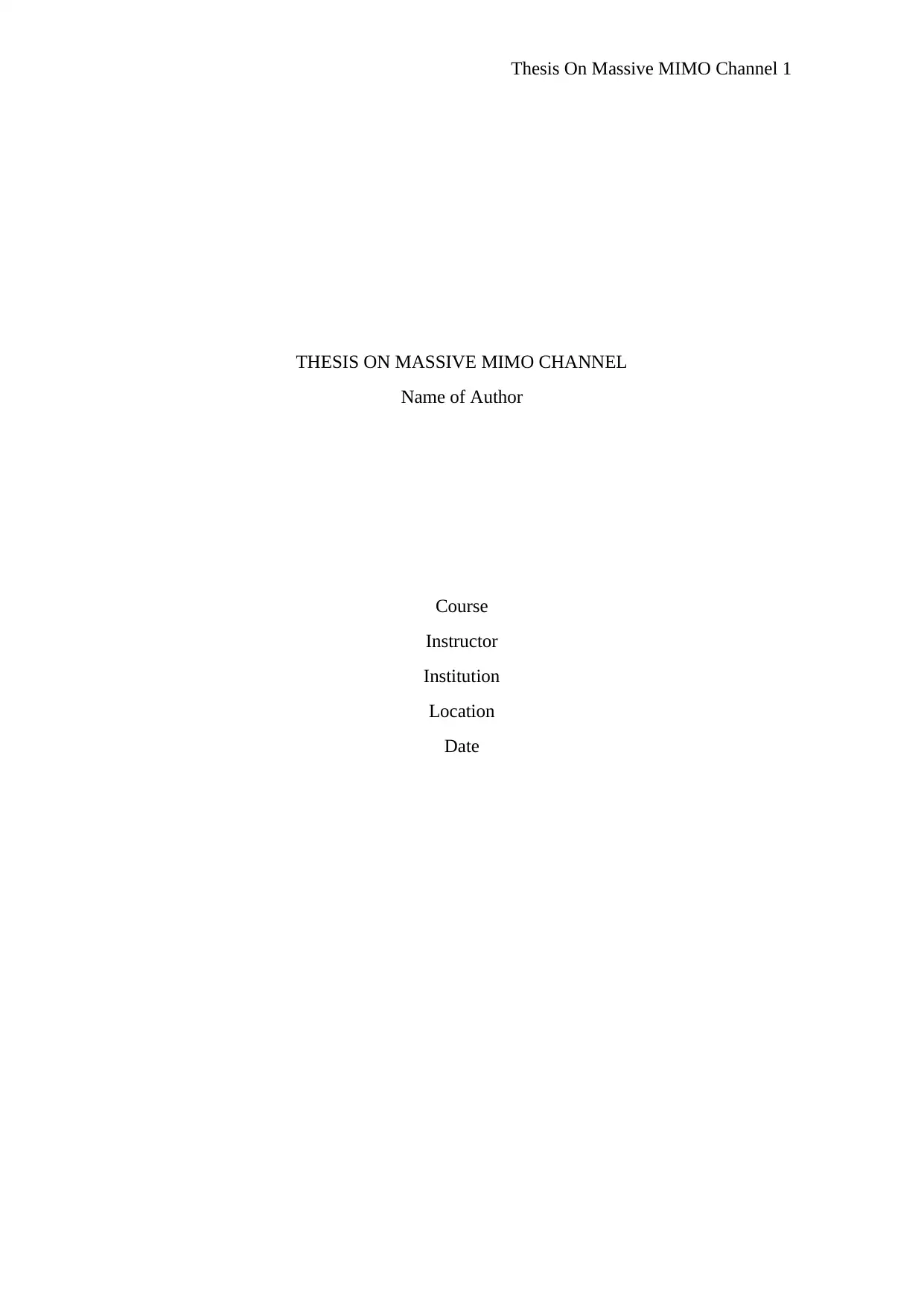
Thesis On Massive MIMO Channel 1
THESIS ON MASSIVE MIMO CHANNEL
Name of Author
Course
Instructor
Institution
Location
Date
THESIS ON MASSIVE MIMO CHANNEL
Name of Author
Course
Instructor
Institution
Location
Date
Secure Best Marks with AI Grader
Need help grading? Try our AI Grader for instant feedback on your assignments.
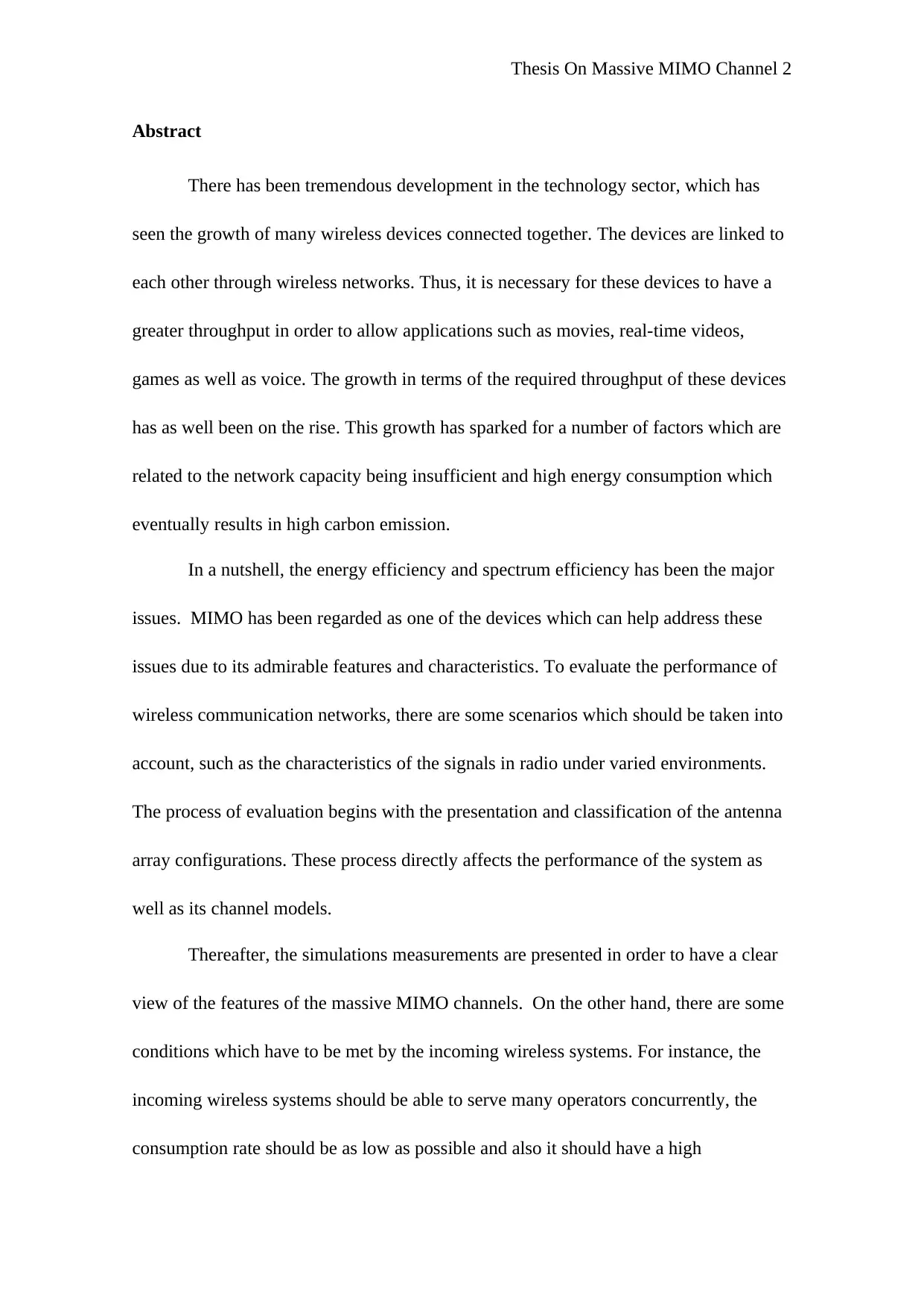
Thesis On Massive MIMO Channel 2
Abstract
There has been tremendous development in the technology sector, which has
seen the growth of many wireless devices connected together. The devices are linked to
each other through wireless networks. Thus, it is necessary for these devices to have a
greater throughput in order to allow applications such as movies, real-time videos,
games as well as voice. The growth in terms of the required throughput of these devices
has as well been on the rise. This growth has sparked for a number of factors which are
related to the network capacity being insufficient and high energy consumption which
eventually results in high carbon emission.
In a nutshell, the energy efficiency and spectrum efficiency has been the major
issues. MIMO has been regarded as one of the devices which can help address these
issues due to its admirable features and characteristics. To evaluate the performance of
wireless communication networks, there are some scenarios which should be taken into
account, such as the characteristics of the signals in radio under varied environments.
The process of evaluation begins with the presentation and classification of the antenna
array configurations. These process directly affects the performance of the system as
well as its channel models.
Thereafter, the simulations measurements are presented in order to have a clear
view of the features of the massive MIMO channels. On the other hand, there are some
conditions which have to be met by the incoming wireless systems. For instance, the
incoming wireless systems should be able to serve many operators concurrently, the
consumption rate should be as low as possible and also it should have a high
Abstract
There has been tremendous development in the technology sector, which has
seen the growth of many wireless devices connected together. The devices are linked to
each other through wireless networks. Thus, it is necessary for these devices to have a
greater throughput in order to allow applications such as movies, real-time videos,
games as well as voice. The growth in terms of the required throughput of these devices
has as well been on the rise. This growth has sparked for a number of factors which are
related to the network capacity being insufficient and high energy consumption which
eventually results in high carbon emission.
In a nutshell, the energy efficiency and spectrum efficiency has been the major
issues. MIMO has been regarded as one of the devices which can help address these
issues due to its admirable features and characteristics. To evaluate the performance of
wireless communication networks, there are some scenarios which should be taken into
account, such as the characteristics of the signals in radio under varied environments.
The process of evaluation begins with the presentation and classification of the antenna
array configurations. These process directly affects the performance of the system as
well as its channel models.
Thereafter, the simulations measurements are presented in order to have a clear
view of the features of the massive MIMO channels. On the other hand, there are some
conditions which have to be met by the incoming wireless systems. For instance, the
incoming wireless systems should be able to serve many operators concurrently, the
consumption rate should be as low as possible and also it should have a high
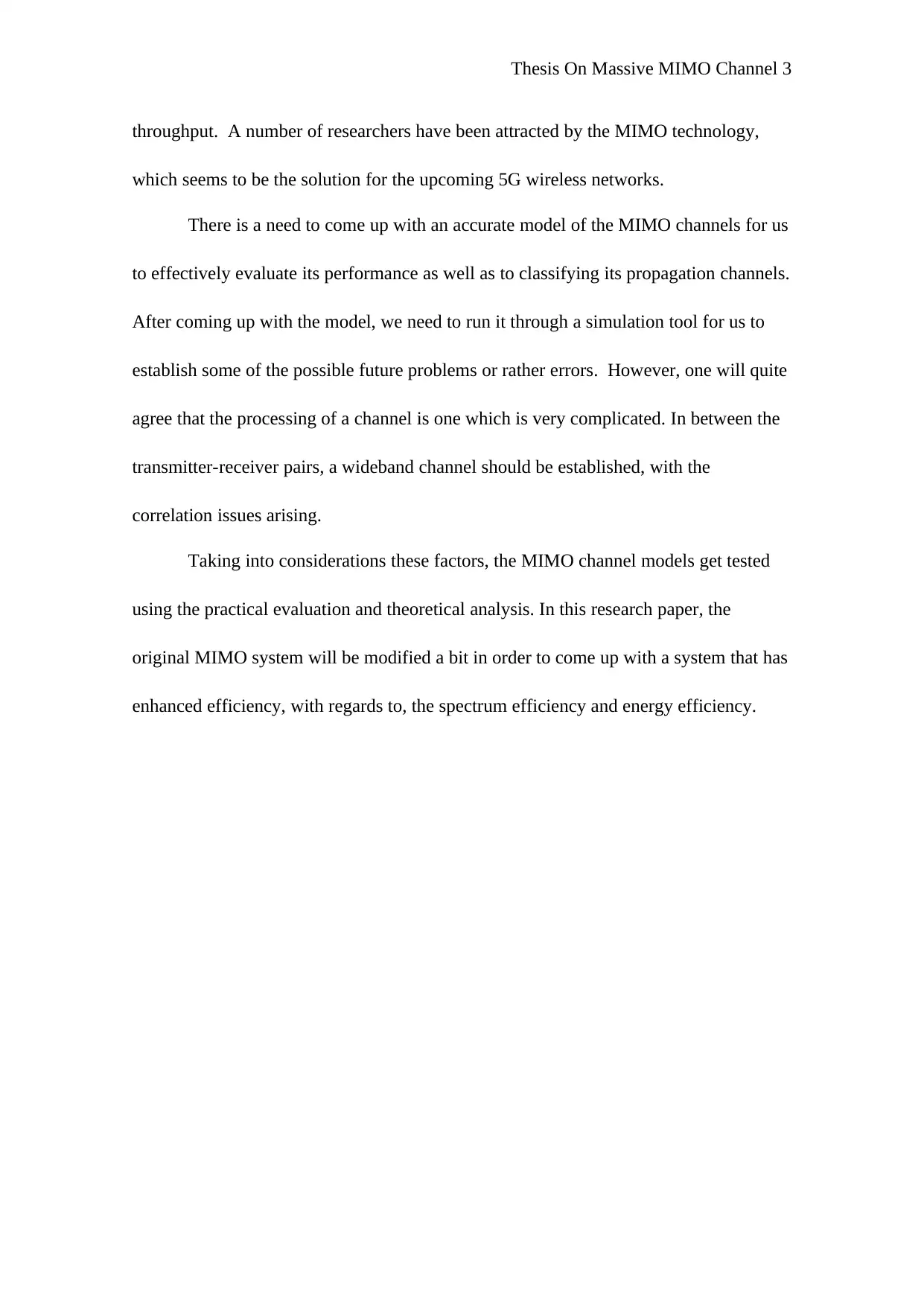
Thesis On Massive MIMO Channel 3
throughput. A number of researchers have been attracted by the MIMO technology,
which seems to be the solution for the upcoming 5G wireless networks.
There is a need to come up with an accurate model of the MIMO channels for us
to effectively evaluate its performance as well as to classifying its propagation channels.
After coming up with the model, we need to run it through a simulation tool for us to
establish some of the possible future problems or rather errors. However, one will quite
agree that the processing of a channel is one which is very complicated. In between the
transmitter-receiver pairs, a wideband channel should be established, with the
correlation issues arising.
Taking into considerations these factors, the MIMO channel models get tested
using the practical evaluation and theoretical analysis. In this research paper, the
original MIMO system will be modified a bit in order to come up with a system that has
enhanced efficiency, with regards to, the spectrum efficiency and energy efficiency.
throughput. A number of researchers have been attracted by the MIMO technology,
which seems to be the solution for the upcoming 5G wireless networks.
There is a need to come up with an accurate model of the MIMO channels for us
to effectively evaluate its performance as well as to classifying its propagation channels.
After coming up with the model, we need to run it through a simulation tool for us to
establish some of the possible future problems or rather errors. However, one will quite
agree that the processing of a channel is one which is very complicated. In between the
transmitter-receiver pairs, a wideband channel should be established, with the
correlation issues arising.
Taking into considerations these factors, the MIMO channel models get tested
using the practical evaluation and theoretical analysis. In this research paper, the
original MIMO system will be modified a bit in order to come up with a system that has
enhanced efficiency, with regards to, the spectrum efficiency and energy efficiency.
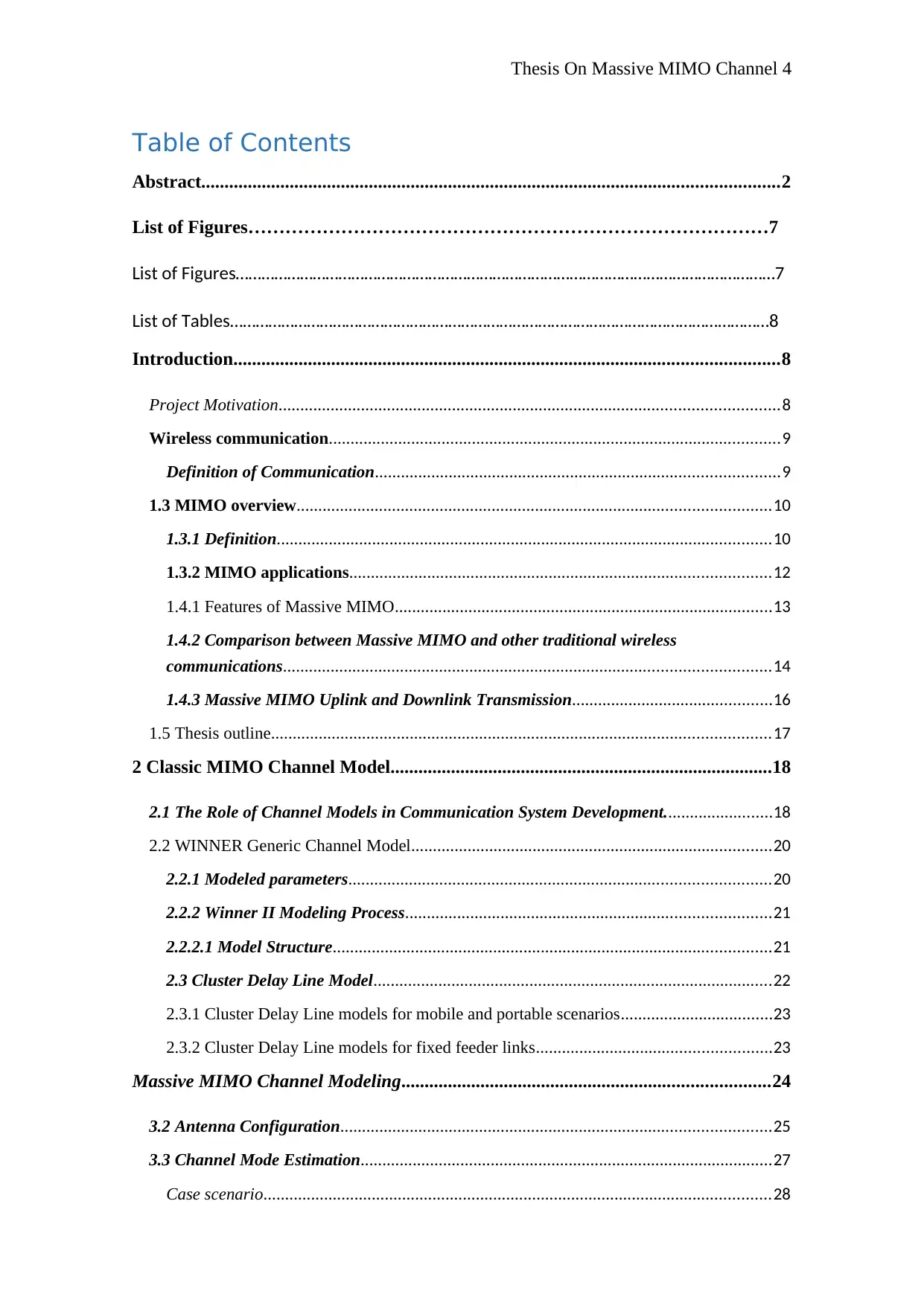
Thesis On Massive MIMO Channel 4
Table of Contents
Abstract............................................................................................................................2
List of Figures…………………………………………………………………………7
List of Figures………………………………………………………………………………………………………………7
List of Tables………………………………………………………………………………………………………………8
Introduction.....................................................................................................................8
Project Motivation...................................................................................................................8
Wireless communication........................................................................................................9
Definition of Communication.............................................................................................9
1.3 MIMO overview.............................................................................................................10
1.3.1 Definition..................................................................................................................10
1.3.2 MIMO applications.................................................................................................12
1.4.1 Features of Massive MIMO.......................................................................................13
1.4.2 Comparison between Massive MIMO and other traditional wireless
communications................................................................................................................14
1.4.3 Massive MIMO Uplink and Downlink Transmission..............................................16
1.5 Thesis outline...................................................................................................................17
2 Classic MIMO Channel Model..................................................................................18
2.1 The Role of Channel Models in Communication System Development.........................18
2.2 WINNER Generic Channel Model...................................................................................20
2.2.1 Modeled parameters.................................................................................................20
2.2.2 Winner II Modeling Process....................................................................................21
2.2.2.1 Model Structure.....................................................................................................21
2.3 Cluster Delay Line Model............................................................................................22
2.3.1 Cluster Delay Line models for mobile and portable scenarios...................................23
2.3.2 Cluster Delay Line models for fixed feeder links......................................................23
Massive MIMO Channel Modeling...............................................................................24
3.2 Antenna Configuration...................................................................................................25
3.3 Channel Mode Estimation...............................................................................................27
Case scenario.....................................................................................................................28
Table of Contents
Abstract............................................................................................................................2
List of Figures…………………………………………………………………………7
List of Figures………………………………………………………………………………………………………………7
List of Tables………………………………………………………………………………………………………………8
Introduction.....................................................................................................................8
Project Motivation...................................................................................................................8
Wireless communication........................................................................................................9
Definition of Communication.............................................................................................9
1.3 MIMO overview.............................................................................................................10
1.3.1 Definition..................................................................................................................10
1.3.2 MIMO applications.................................................................................................12
1.4.1 Features of Massive MIMO.......................................................................................13
1.4.2 Comparison between Massive MIMO and other traditional wireless
communications................................................................................................................14
1.4.3 Massive MIMO Uplink and Downlink Transmission..............................................16
1.5 Thesis outline...................................................................................................................17
2 Classic MIMO Channel Model..................................................................................18
2.1 The Role of Channel Models in Communication System Development.........................18
2.2 WINNER Generic Channel Model...................................................................................20
2.2.1 Modeled parameters.................................................................................................20
2.2.2 Winner II Modeling Process....................................................................................21
2.2.2.1 Model Structure.....................................................................................................21
2.3 Cluster Delay Line Model............................................................................................22
2.3.1 Cluster Delay Line models for mobile and portable scenarios...................................23
2.3.2 Cluster Delay Line models for fixed feeder links......................................................23
Massive MIMO Channel Modeling...............................................................................24
3.2 Antenna Configuration...................................................................................................25
3.3 Channel Mode Estimation...............................................................................................27
Case scenario.....................................................................................................................28
Secure Best Marks with AI Grader
Need help grading? Try our AI Grader for instant feedback on your assignments.
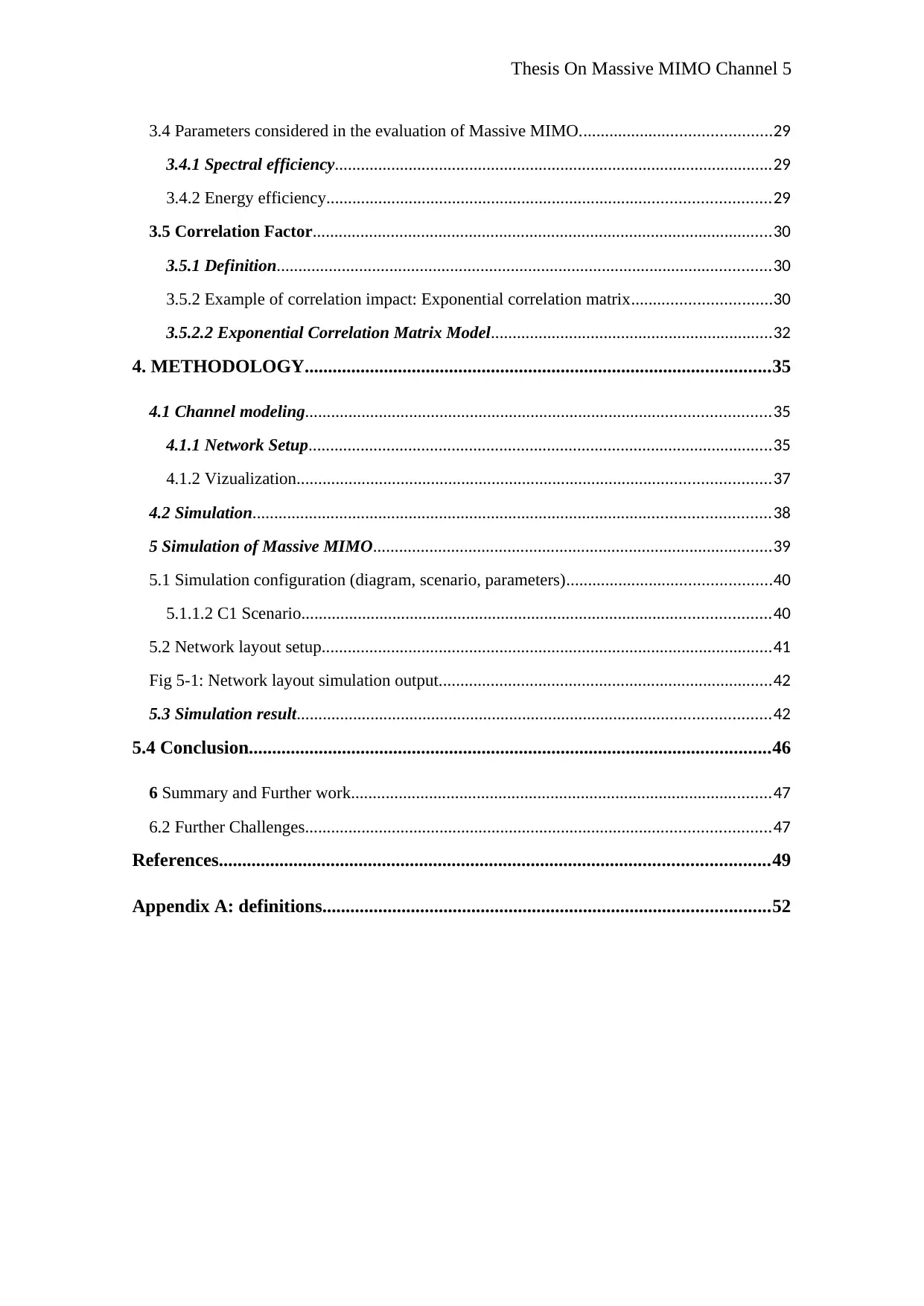
Thesis On Massive MIMO Channel 5
3.4 Parameters considered in the evaluation of Massive MIMO............................................29
3.4.1 Spectral efficiency.....................................................................................................29
3.4.2 Energy efficiency......................................................................................................29
3.5 Correlation Factor..........................................................................................................30
3.5.1 Definition..................................................................................................................30
3.5.2 Example of correlation impact: Exponential correlation matrix................................30
3.5.2.2 Exponential Correlation Matrix Model.................................................................32
4. METHODOLOGY....................................................................................................35
4.1 Channel modeling...........................................................................................................35
4.1.1 Network Setup...........................................................................................................35
4.1.2 Vizualization.............................................................................................................37
4.2 Simulation.......................................................................................................................38
5 Simulation of Massive MIMO............................................................................................39
5.1 Simulation configuration (diagram, scenario, parameters)...............................................40
5.1.1.2 C1 Scenario............................................................................................................40
5.2 Network layout setup........................................................................................................41
Fig 5-1: Network layout simulation output.............................................................................42
5.3 Simulation result.............................................................................................................42
5.4 Conclusion................................................................................................................46
6 Summary and Further work.................................................................................................47
6.2 Further Challenges...........................................................................................................47
References......................................................................................................................49
Appendix A: definitions................................................................................................52
3.4 Parameters considered in the evaluation of Massive MIMO............................................29
3.4.1 Spectral efficiency.....................................................................................................29
3.4.2 Energy efficiency......................................................................................................29
3.5 Correlation Factor..........................................................................................................30
3.5.1 Definition..................................................................................................................30
3.5.2 Example of correlation impact: Exponential correlation matrix................................30
3.5.2.2 Exponential Correlation Matrix Model.................................................................32
4. METHODOLOGY....................................................................................................35
4.1 Channel modeling...........................................................................................................35
4.1.1 Network Setup...........................................................................................................35
4.1.2 Vizualization.............................................................................................................37
4.2 Simulation.......................................................................................................................38
5 Simulation of Massive MIMO............................................................................................39
5.1 Simulation configuration (diagram, scenario, parameters)...............................................40
5.1.1.2 C1 Scenario............................................................................................................40
5.2 Network layout setup........................................................................................................41
Fig 5-1: Network layout simulation output.............................................................................42
5.3 Simulation result.............................................................................................................42
5.4 Conclusion................................................................................................................46
6 Summary and Further work.................................................................................................47
6.2 Further Challenges...........................................................................................................47
References......................................................................................................................49
Appendix A: definitions................................................................................................52
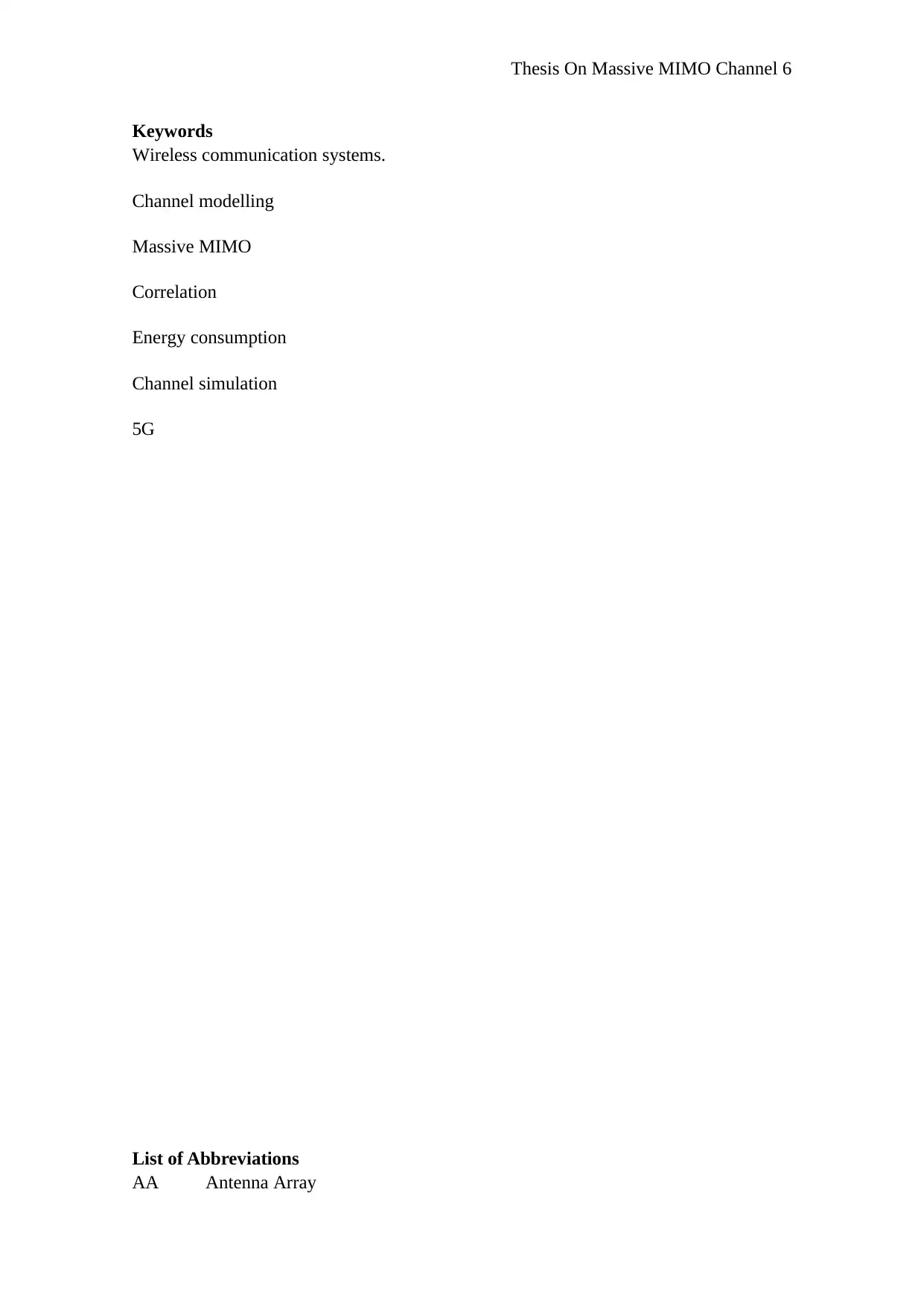
Thesis On Massive MIMO Channel 6
Keywords
Wireless communication systems.
Channel modelling
Massive MIMO
Correlation
Energy consumption
Channel simulation
5G
List of Abbreviations
AA Antenna Array
Keywords
Wireless communication systems.
Channel modelling
Massive MIMO
Correlation
Energy consumption
Channel simulation
5G
List of Abbreviations
AA Antenna Array
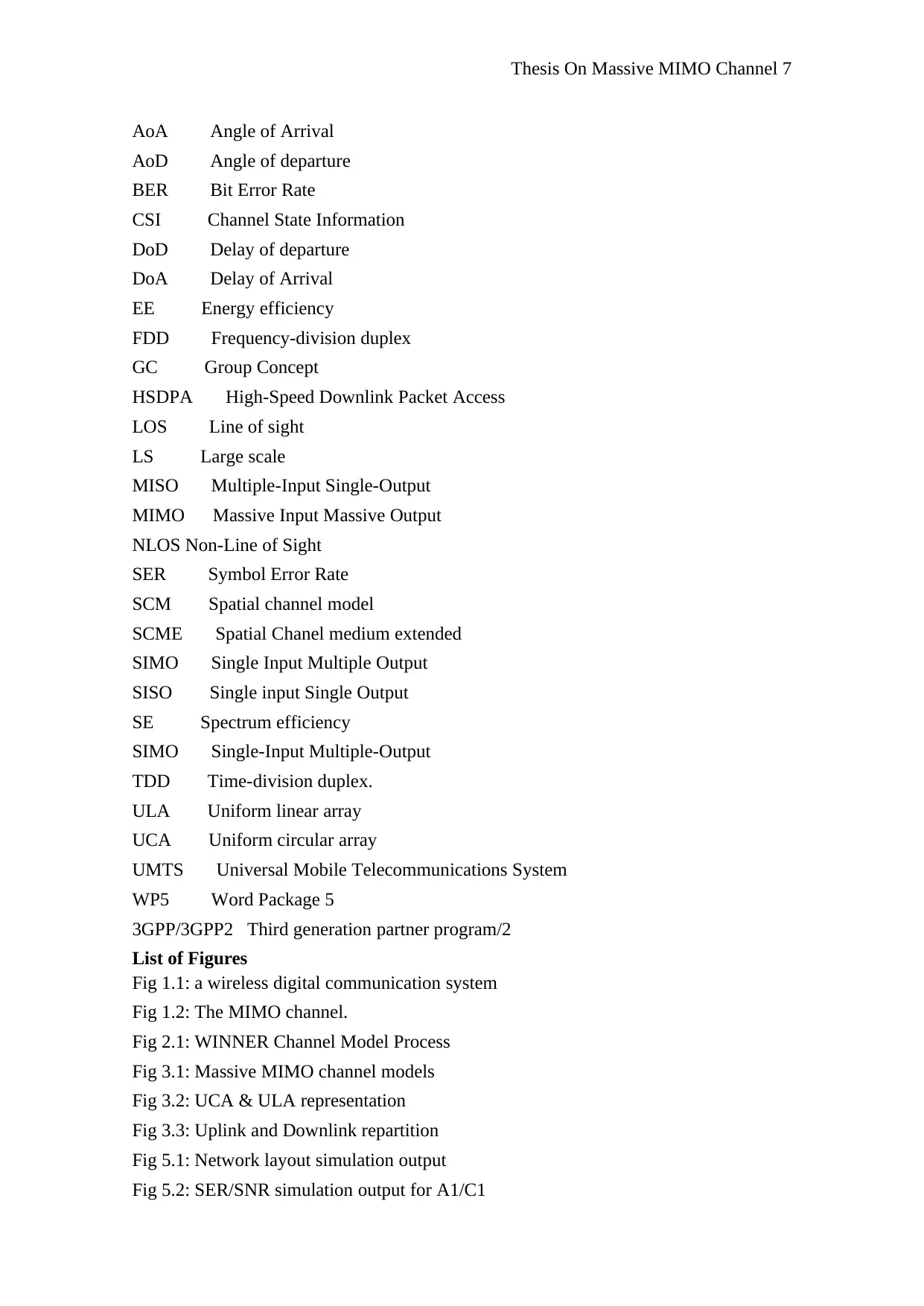
Thesis On Massive MIMO Channel 7
AoA Angle of Arrival
AoD Angle of departure
BER Bit Error Rate
CSI Channel State Information
DoD Delay of departure
DoA Delay of Arrival
EE Energy efficiency
FDD Frequency-division duplex
GC Group Concept
HSDPA High-Speed Downlink Packet Access
LOS Line of sight
LS Large scale
MISO Multiple-Input Single-Output
MIMO Massive Input Massive Output
NLOS Non-Line of Sight
SER Symbol Error Rate
SCM Spatial channel model
SCME Spatial Chanel medium extended
SIMO Single Input Multiple Output
SISO Single input Single Output
SE Spectrum efficiency
SIMO Single-Input Multiple-Output
TDD Time-division duplex.
ULA Uniform linear array
UCA Uniform circular array
UMTS Universal Mobile Telecommunications System
WP5 Word Package 5
3GPP/3GPP2 Third generation partner program/2
List of Figures
Fig 1.1: a wireless digital communication system
Fig 1.2: The MIMO channel.
Fig 2.1: WINNER Channel Model Process
Fig 3.1: Massive MIMO channel models
Fig 3.2: UCA & ULA representation
Fig 3.3: Uplink and Downlink repartition
Fig 5.1: Network layout simulation output
Fig 5.2: SER/SNR simulation output for A1/C1
AoA Angle of Arrival
AoD Angle of departure
BER Bit Error Rate
CSI Channel State Information
DoD Delay of departure
DoA Delay of Arrival
EE Energy efficiency
FDD Frequency-division duplex
GC Group Concept
HSDPA High-Speed Downlink Packet Access
LOS Line of sight
LS Large scale
MISO Multiple-Input Single-Output
MIMO Massive Input Massive Output
NLOS Non-Line of Sight
SER Symbol Error Rate
SCM Spatial channel model
SCME Spatial Chanel medium extended
SIMO Single Input Multiple Output
SISO Single input Single Output
SE Spectrum efficiency
SIMO Single-Input Multiple-Output
TDD Time-division duplex.
ULA Uniform linear array
UCA Uniform circular array
UMTS Universal Mobile Telecommunications System
WP5 Word Package 5
3GPP/3GPP2 Third generation partner program/2
List of Figures
Fig 1.1: a wireless digital communication system
Fig 1.2: The MIMO channel.
Fig 2.1: WINNER Channel Model Process
Fig 3.1: Massive MIMO channel models
Fig 3.2: UCA & ULA representation
Fig 3.3: Uplink and Downlink repartition
Fig 5.1: Network layout simulation output
Fig 5.2: SER/SNR simulation output for A1/C1
Paraphrase This Document
Need a fresh take? Get an instant paraphrase of this document with our AI Paraphraser
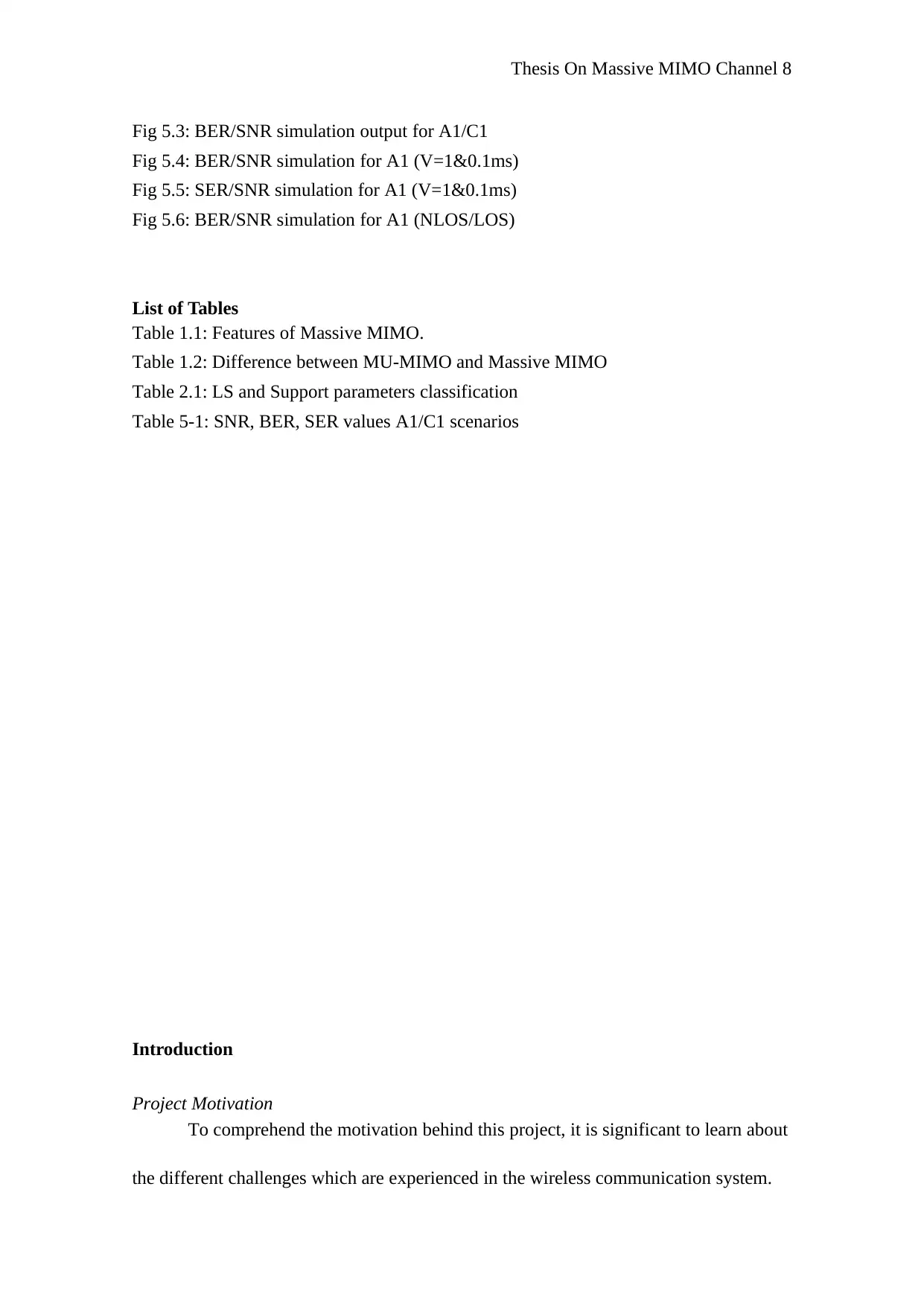
Thesis On Massive MIMO Channel 8
Fig 5.3: BER/SNR simulation output for A1/C1
Fig 5.4: BER/SNR simulation for A1 (V=1&0.1ms)
Fig 5.5: SER/SNR simulation for A1 (V=1&0.1ms)
Fig 5.6: BER/SNR simulation for A1 (NLOS/LOS)
List of Tables
Table 1.1: Features of Massive MIMO.
Table 1.2: Difference between MU-MIMO and Massive MIMO
Table 2.1: LS and Support parameters classification
Table 5-1: SNR, BER, SER values A1/C1 scenarios
Introduction
Project Motivation
To comprehend the motivation behind this project, it is significant to learn about
the different challenges which are experienced in the wireless communication system.
Fig 5.3: BER/SNR simulation output for A1/C1
Fig 5.4: BER/SNR simulation for A1 (V=1&0.1ms)
Fig 5.5: SER/SNR simulation for A1 (V=1&0.1ms)
Fig 5.6: BER/SNR simulation for A1 (NLOS/LOS)
List of Tables
Table 1.1: Features of Massive MIMO.
Table 1.2: Difference between MU-MIMO and Massive MIMO
Table 2.1: LS and Support parameters classification
Table 5-1: SNR, BER, SER values A1/C1 scenarios
Introduction
Project Motivation
To comprehend the motivation behind this project, it is significant to learn about
the different challenges which are experienced in the wireless communication system.
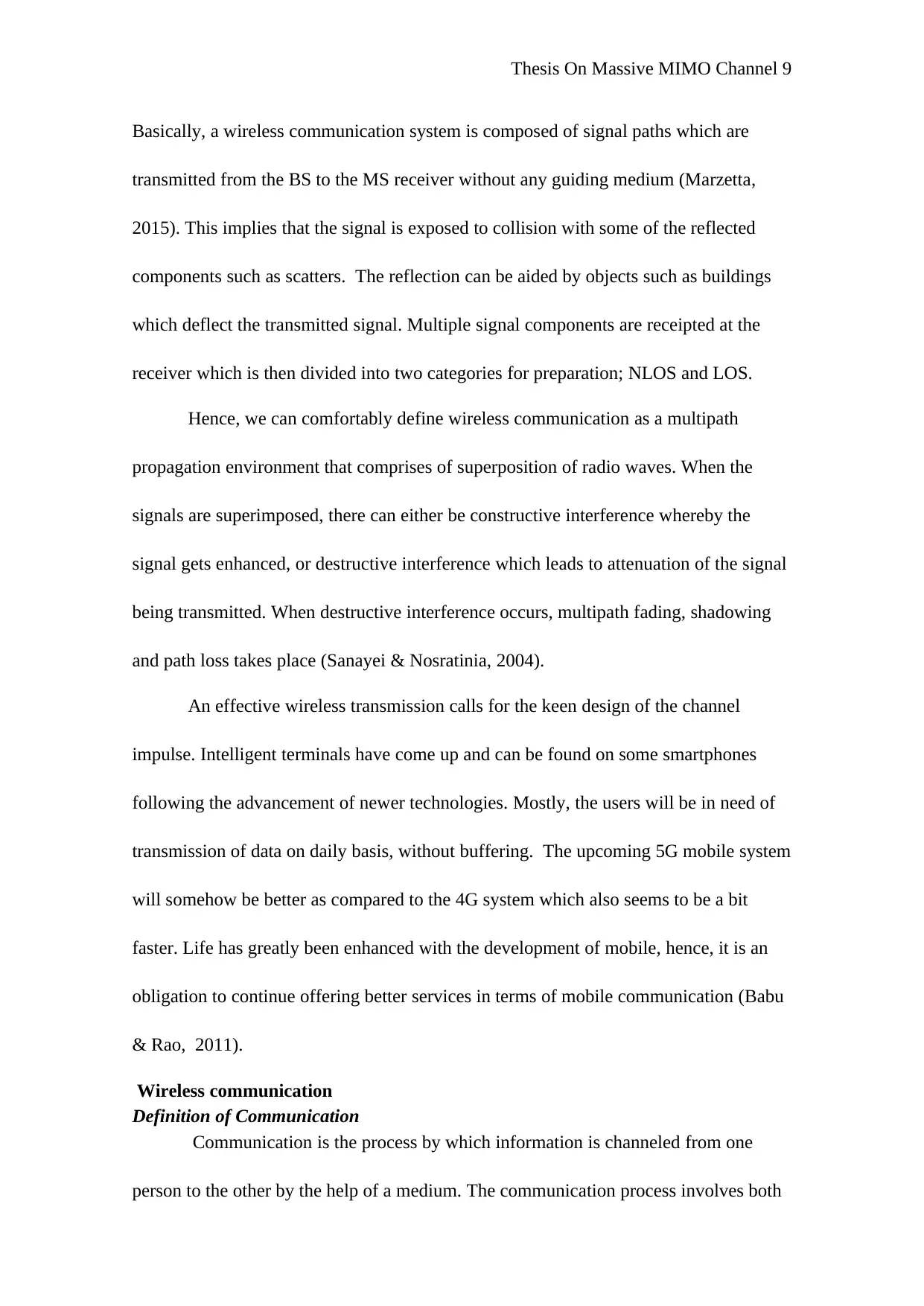
Thesis On Massive MIMO Channel 9
Basically, a wireless communication system is composed of signal paths which are
transmitted from the BS to the MS receiver without any guiding medium (Marzetta,
2015). This implies that the signal is exposed to collision with some of the reflected
components such as scatters. The reflection can be aided by objects such as buildings
which deflect the transmitted signal. Multiple signal components are receipted at the
receiver which is then divided into two categories for preparation; NLOS and LOS.
Hence, we can comfortably define wireless communication as a multipath
propagation environment that comprises of superposition of radio waves. When the
signals are superimposed, there can either be constructive interference whereby the
signal gets enhanced, or destructive interference which leads to attenuation of the signal
being transmitted. When destructive interference occurs, multipath fading, shadowing
and path loss takes place (Sanayei & Nosratinia, 2004).
An effective wireless transmission calls for the keen design of the channel
impulse. Intelligent terminals have come up and can be found on some smartphones
following the advancement of newer technologies. Mostly, the users will be in need of
transmission of data on daily basis, without buffering. The upcoming 5G mobile system
will somehow be better as compared to the 4G system which also seems to be a bit
faster. Life has greatly been enhanced with the development of mobile, hence, it is an
obligation to continue offering better services in terms of mobile communication (Babu
& Rao, 2011).
Wireless communication
Definition of Communication
Communication is the process by which information is channeled from one
person to the other by the help of a medium. The communication process involves both
Basically, a wireless communication system is composed of signal paths which are
transmitted from the BS to the MS receiver without any guiding medium (Marzetta,
2015). This implies that the signal is exposed to collision with some of the reflected
components such as scatters. The reflection can be aided by objects such as buildings
which deflect the transmitted signal. Multiple signal components are receipted at the
receiver which is then divided into two categories for preparation; NLOS and LOS.
Hence, we can comfortably define wireless communication as a multipath
propagation environment that comprises of superposition of radio waves. When the
signals are superimposed, there can either be constructive interference whereby the
signal gets enhanced, or destructive interference which leads to attenuation of the signal
being transmitted. When destructive interference occurs, multipath fading, shadowing
and path loss takes place (Sanayei & Nosratinia, 2004).
An effective wireless transmission calls for the keen design of the channel
impulse. Intelligent terminals have come up and can be found on some smartphones
following the advancement of newer technologies. Mostly, the users will be in need of
transmission of data on daily basis, without buffering. The upcoming 5G mobile system
will somehow be better as compared to the 4G system which also seems to be a bit
faster. Life has greatly been enhanced with the development of mobile, hence, it is an
obligation to continue offering better services in terms of mobile communication (Babu
& Rao, 2011).
Wireless communication
Definition of Communication
Communication is the process by which information is channeled from one
person to the other by the help of a medium. The communication process involves both
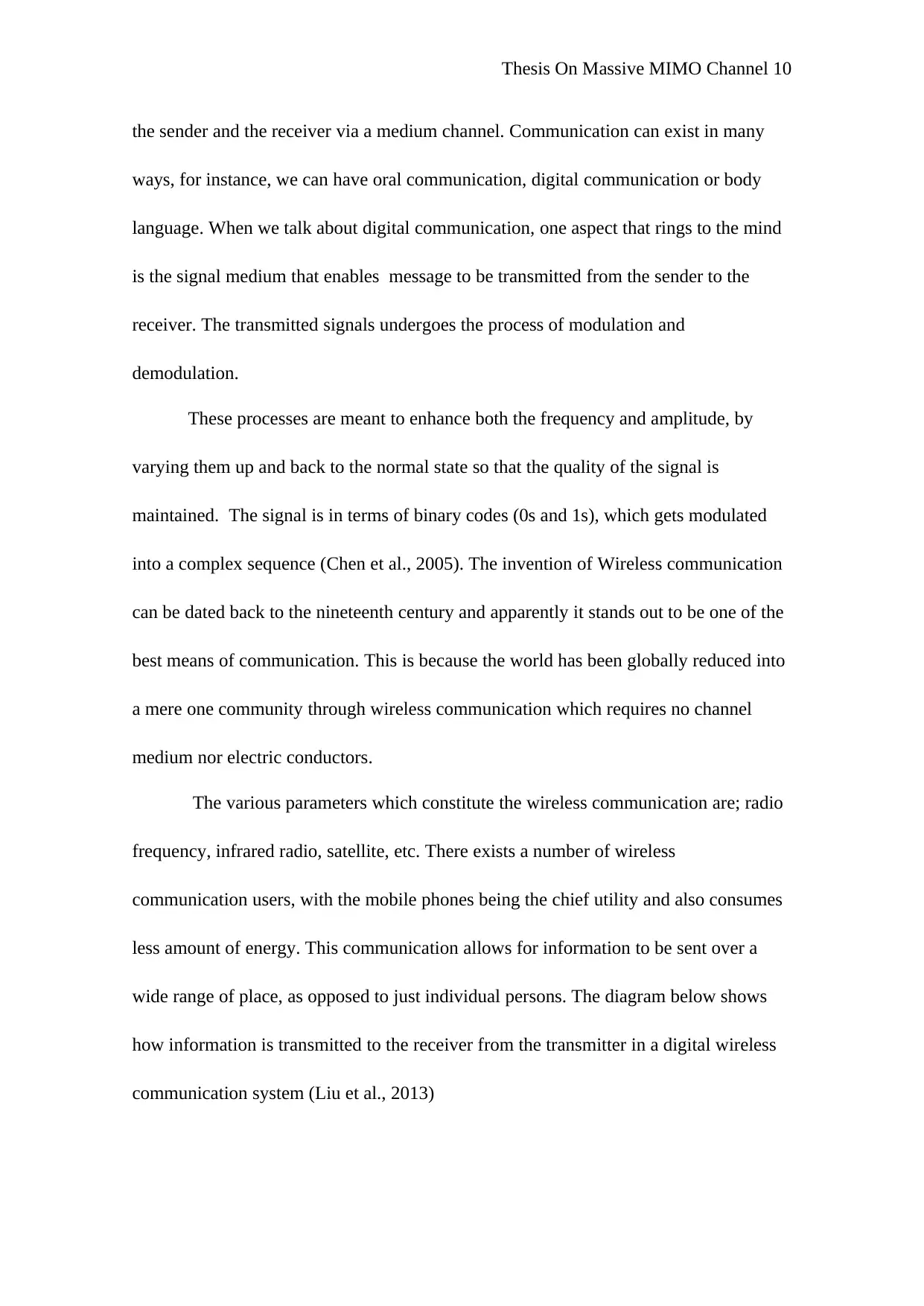
Thesis On Massive MIMO Channel 10
the sender and the receiver via a medium channel. Communication can exist in many
ways, for instance, we can have oral communication, digital communication or body
language. When we talk about digital communication, one aspect that rings to the mind
is the signal medium that enables message to be transmitted from the sender to the
receiver. The transmitted signals undergoes the process of modulation and
demodulation.
These processes are meant to enhance both the frequency and amplitude, by
varying them up and back to the normal state so that the quality of the signal is
maintained. The signal is in terms of binary codes (0s and 1s), which gets modulated
into a complex sequence (Chen et al., 2005). The invention of Wireless communication
can be dated back to the nineteenth century and apparently it stands out to be one of the
best means of communication. This is because the world has been globally reduced into
a mere one community through wireless communication which requires no channel
medium nor electric conductors.
The various parameters which constitute the wireless communication are; radio
frequency, infrared radio, satellite, etc. There exists a number of wireless
communication users, with the mobile phones being the chief utility and also consumes
less amount of energy. This communication allows for information to be sent over a
wide range of place, as opposed to just individual persons. The diagram below shows
how information is transmitted to the receiver from the transmitter in a digital wireless
communication system (Liu et al., 2013)
the sender and the receiver via a medium channel. Communication can exist in many
ways, for instance, we can have oral communication, digital communication or body
language. When we talk about digital communication, one aspect that rings to the mind
is the signal medium that enables message to be transmitted from the sender to the
receiver. The transmitted signals undergoes the process of modulation and
demodulation.
These processes are meant to enhance both the frequency and amplitude, by
varying them up and back to the normal state so that the quality of the signal is
maintained. The signal is in terms of binary codes (0s and 1s), which gets modulated
into a complex sequence (Chen et al., 2005). The invention of Wireless communication
can be dated back to the nineteenth century and apparently it stands out to be one of the
best means of communication. This is because the world has been globally reduced into
a mere one community through wireless communication which requires no channel
medium nor electric conductors.
The various parameters which constitute the wireless communication are; radio
frequency, infrared radio, satellite, etc. There exists a number of wireless
communication users, with the mobile phones being the chief utility and also consumes
less amount of energy. This communication allows for information to be sent over a
wide range of place, as opposed to just individual persons. The diagram below shows
how information is transmitted to the receiver from the transmitter in a digital wireless
communication system (Liu et al., 2013)
Secure Best Marks with AI Grader
Need help grading? Try our AI Grader for instant feedback on your assignments.
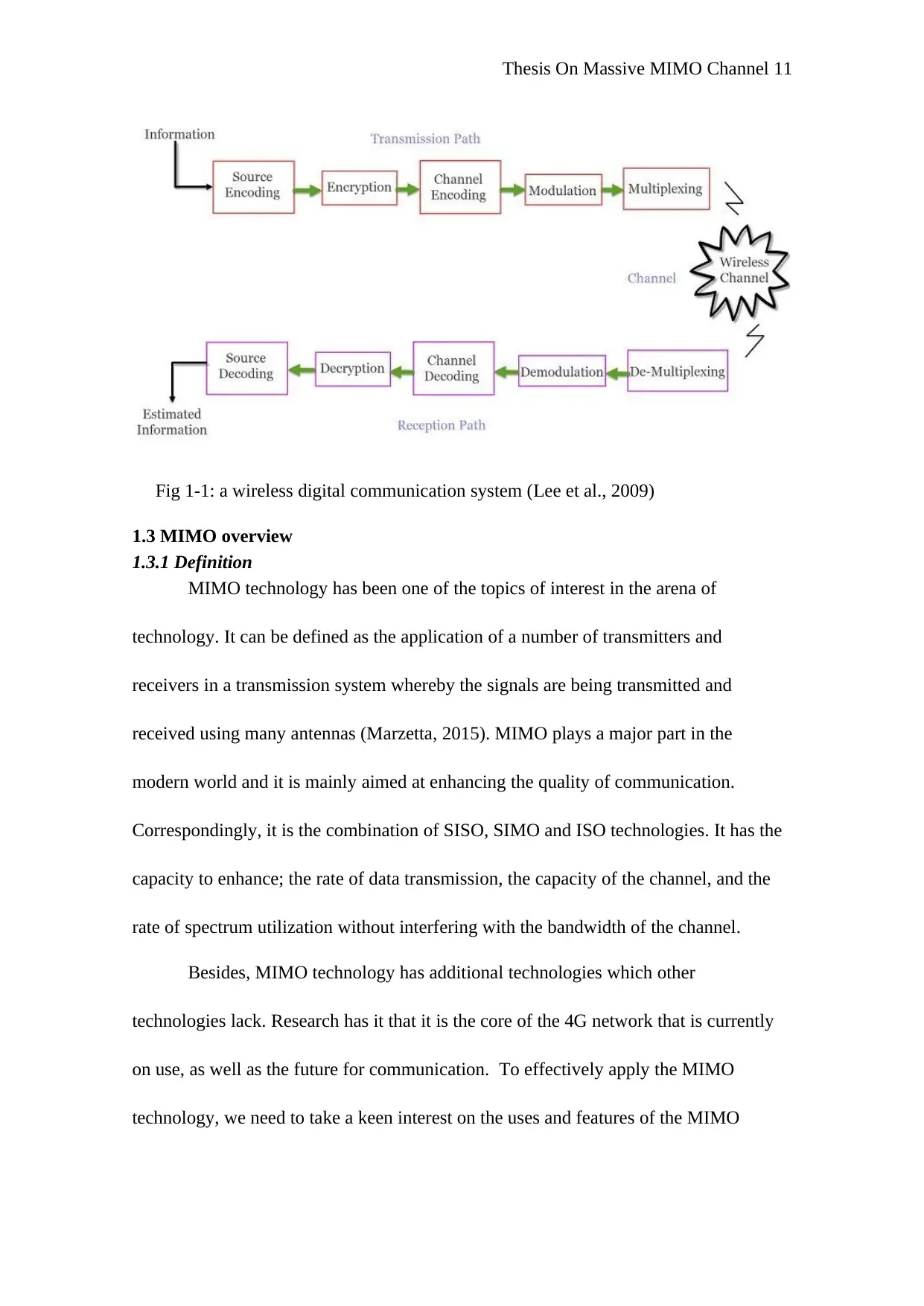
Thesis On Massive MIMO Channel 11
Fig 1-1: a wireless digital communication system (Lee et al., 2009)
1.3 MIMO overview
1.3.1 Definition
MIMO technology has been one of the topics of interest in the arena of
technology. It can be defined as the application of a number of transmitters and
receivers in a transmission system whereby the signals are being transmitted and
received using many antennas (Marzetta, 2015). MIMO plays a major part in the
modern world and it is mainly aimed at enhancing the quality of communication.
Correspondingly, it is the combination of SISO, SIMO and ISO technologies. It has the
capacity to enhance; the rate of data transmission, the capacity of the channel, and the
rate of spectrum utilization without interfering with the bandwidth of the channel.
Besides, MIMO technology has additional technologies which other
technologies lack. Research has it that it is the core of the 4G network that is currently
on use, as well as the future for communication. To effectively apply the MIMO
technology, we need to take a keen interest on the uses and features of the MIMO
Fig 1-1: a wireless digital communication system (Lee et al., 2009)
1.3 MIMO overview
1.3.1 Definition
MIMO technology has been one of the topics of interest in the arena of
technology. It can be defined as the application of a number of transmitters and
receivers in a transmission system whereby the signals are being transmitted and
received using many antennas (Marzetta, 2015). MIMO plays a major part in the
modern world and it is mainly aimed at enhancing the quality of communication.
Correspondingly, it is the combination of SISO, SIMO and ISO technologies. It has the
capacity to enhance; the rate of data transmission, the capacity of the channel, and the
rate of spectrum utilization without interfering with the bandwidth of the channel.
Besides, MIMO technology has additional technologies which other
technologies lack. Research has it that it is the core of the 4G network that is currently
on use, as well as the future for communication. To effectively apply the MIMO
technology, we need to take a keen interest on the uses and features of the MIMO
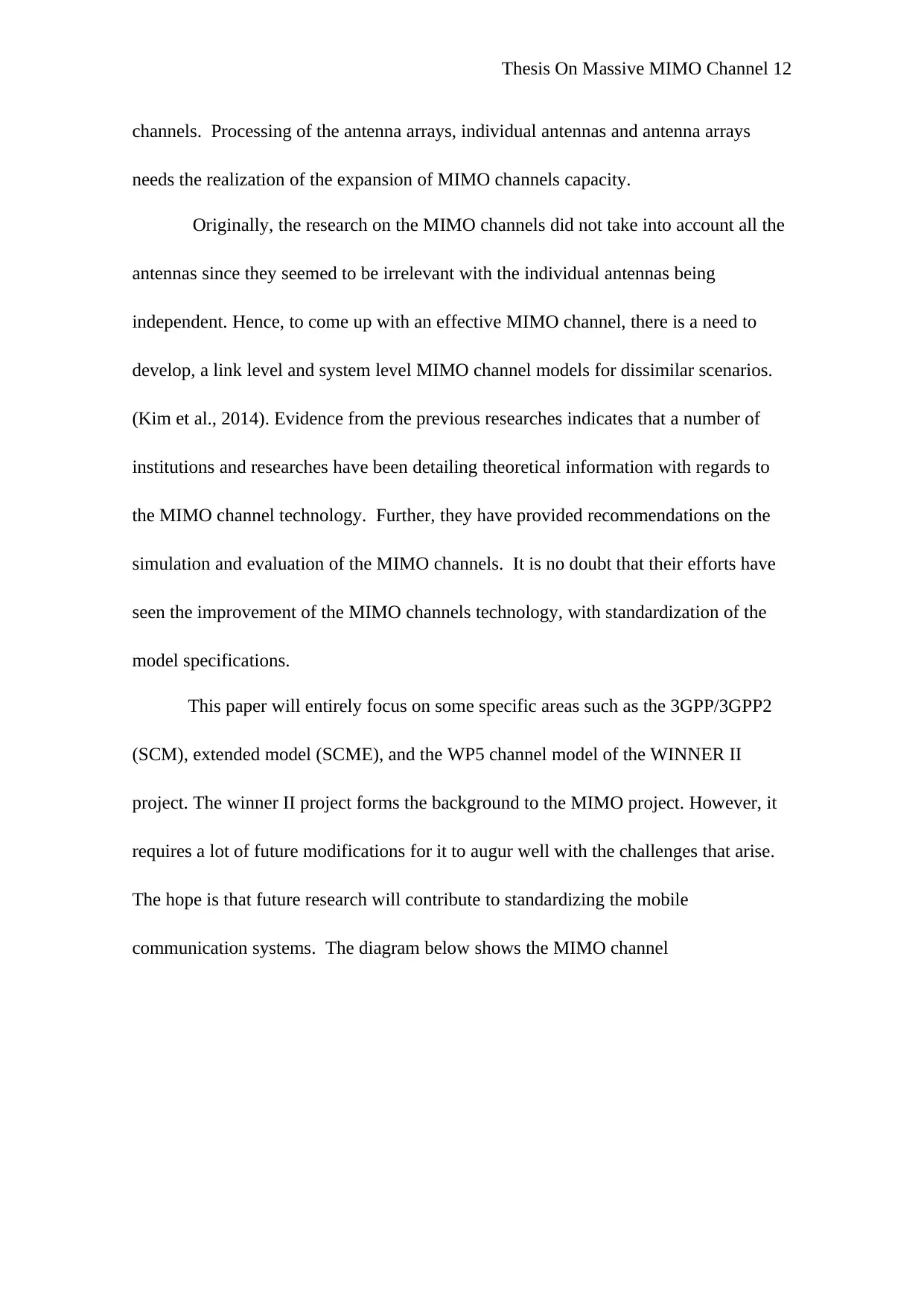
Thesis On Massive MIMO Channel 12
channels. Processing of the antenna arrays, individual antennas and antenna arrays
needs the realization of the expansion of MIMO channels capacity.
Originally, the research on the MIMO channels did not take into account all the
antennas since they seemed to be irrelevant with the individual antennas being
independent. Hence, to come up with an effective MIMO channel, there is a need to
develop, a link level and system level MIMO channel models for dissimilar scenarios.
(Kim et al., 2014). Evidence from the previous researches indicates that a number of
institutions and researches have been detailing theoretical information with regards to
the MIMO channel technology. Further, they have provided recommendations on the
simulation and evaluation of the MIMO channels. It is no doubt that their efforts have
seen the improvement of the MIMO channels technology, with standardization of the
model specifications.
This paper will entirely focus on some specific areas such as the 3GPP/3GPP2
(SCM), extended model (SCME), and the WP5 channel model of the WINNER II
project. The winner II project forms the background to the MIMO project. However, it
requires a lot of future modifications for it to augur well with the challenges that arise.
The hope is that future research will contribute to standardizing the mobile
communication systems. The diagram below shows the MIMO channel
channels. Processing of the antenna arrays, individual antennas and antenna arrays
needs the realization of the expansion of MIMO channels capacity.
Originally, the research on the MIMO channels did not take into account all the
antennas since they seemed to be irrelevant with the individual antennas being
independent. Hence, to come up with an effective MIMO channel, there is a need to
develop, a link level and system level MIMO channel models for dissimilar scenarios.
(Kim et al., 2014). Evidence from the previous researches indicates that a number of
institutions and researches have been detailing theoretical information with regards to
the MIMO channel technology. Further, they have provided recommendations on the
simulation and evaluation of the MIMO channels. It is no doubt that their efforts have
seen the improvement of the MIMO channels technology, with standardization of the
model specifications.
This paper will entirely focus on some specific areas such as the 3GPP/3GPP2
(SCM), extended model (SCME), and the WP5 channel model of the WINNER II
project. The winner II project forms the background to the MIMO project. However, it
requires a lot of future modifications for it to augur well with the challenges that arise.
The hope is that future research will contribute to standardizing the mobile
communication systems. The diagram below shows the MIMO channel
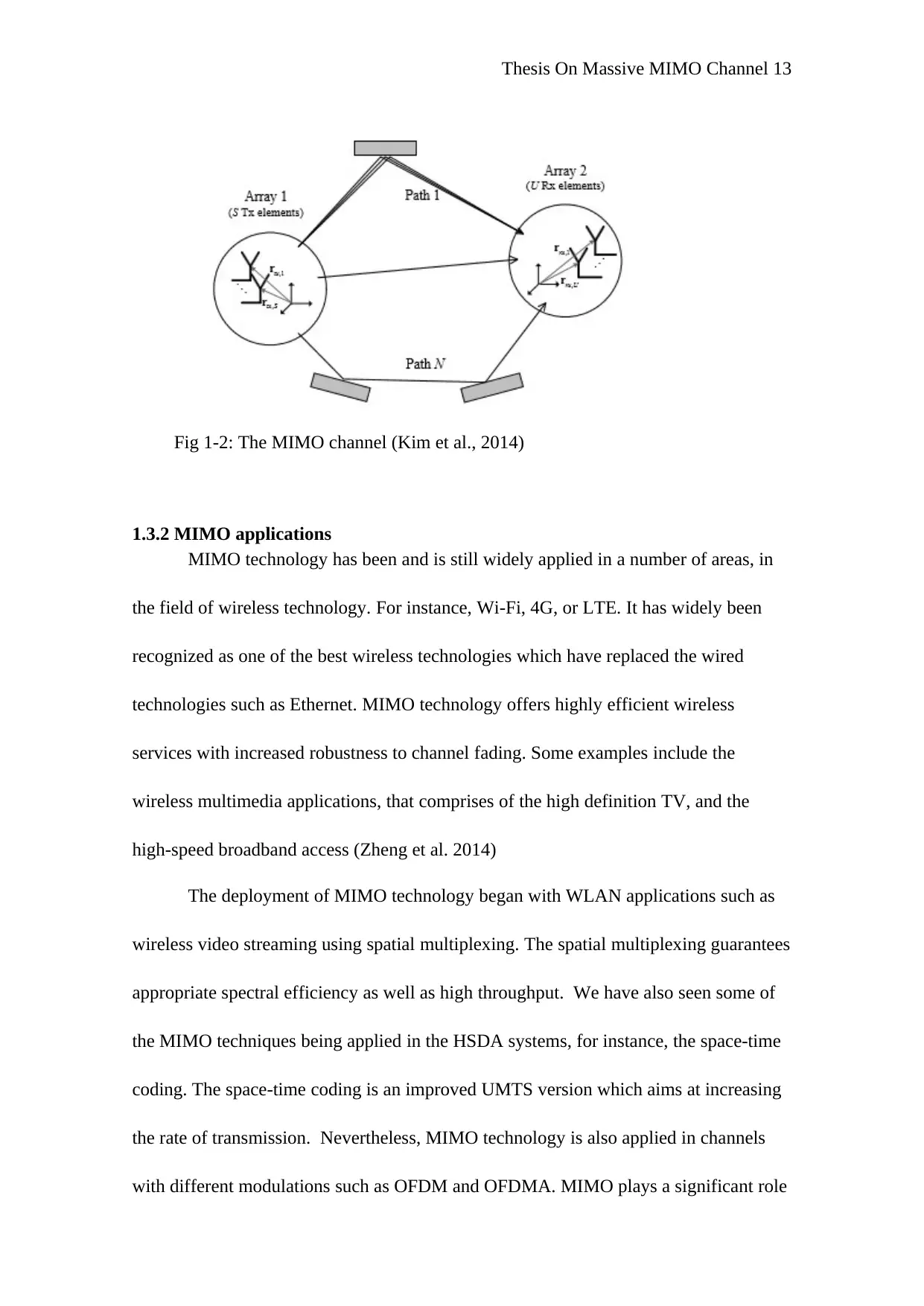
Thesis On Massive MIMO Channel 13
Fig 1-2: The MIMO channel (Kim et al., 2014)
1.3.2 MIMO applications
MIMO technology has been and is still widely applied in a number of areas, in
the field of wireless technology. For instance, Wi-Fi, 4G, or LTE. It has widely been
recognized as one of the best wireless technologies which have replaced the wired
technologies such as Ethernet. MIMO technology offers highly efficient wireless
services with increased robustness to channel fading. Some examples include the
wireless multimedia applications, that comprises of the high definition TV, and the
high-speed broadband access (Zheng et al. 2014)
The deployment of MIMO technology began with WLAN applications such as
wireless video streaming using spatial multiplexing. The spatial multiplexing guarantees
appropriate spectral efficiency as well as high throughput. We have also seen some of
the MIMO techniques being applied in the HSDA systems, for instance, the space-time
coding. The space-time coding is an improved UMTS version which aims at increasing
the rate of transmission. Nevertheless, MIMO technology is also applied in channels
with different modulations such as OFDM and OFDMA. MIMO plays a significant role
Fig 1-2: The MIMO channel (Kim et al., 2014)
1.3.2 MIMO applications
MIMO technology has been and is still widely applied in a number of areas, in
the field of wireless technology. For instance, Wi-Fi, 4G, or LTE. It has widely been
recognized as one of the best wireless technologies which have replaced the wired
technologies such as Ethernet. MIMO technology offers highly efficient wireless
services with increased robustness to channel fading. Some examples include the
wireless multimedia applications, that comprises of the high definition TV, and the
high-speed broadband access (Zheng et al. 2014)
The deployment of MIMO technology began with WLAN applications such as
wireless video streaming using spatial multiplexing. The spatial multiplexing guarantees
appropriate spectral efficiency as well as high throughput. We have also seen some of
the MIMO techniques being applied in the HSDA systems, for instance, the space-time
coding. The space-time coding is an improved UMTS version which aims at increasing
the rate of transmission. Nevertheless, MIMO technology is also applied in channels
with different modulations such as OFDM and OFDMA. MIMO plays a significant role
Paraphrase This Document
Need a fresh take? Get an instant paraphrase of this document with our AI Paraphraser
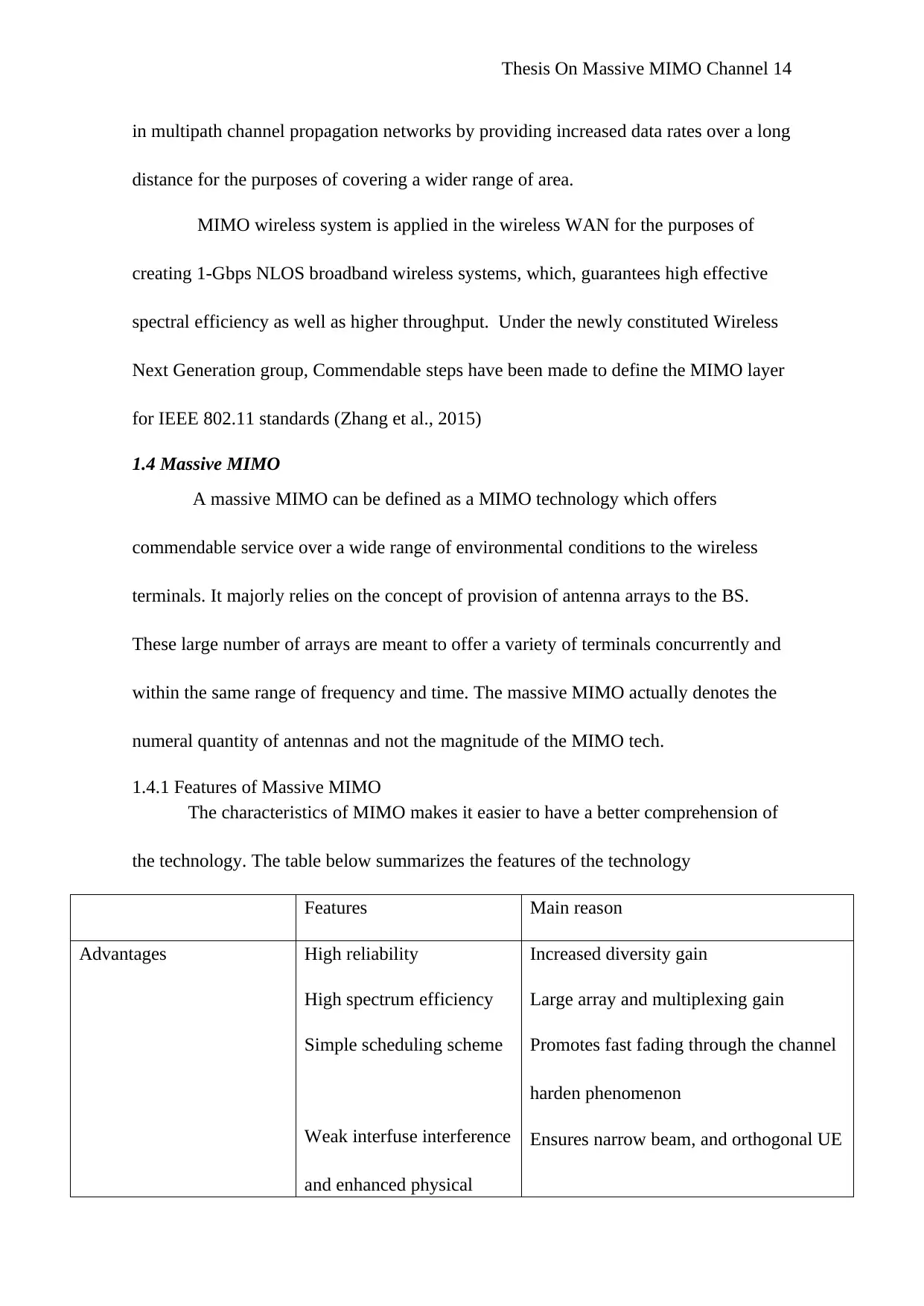
Thesis On Massive MIMO Channel 14
in multipath channel propagation networks by providing increased data rates over a long
distance for the purposes of covering a wider range of area.
MIMO wireless system is applied in the wireless WAN for the purposes of
creating 1-Gbps NLOS broadband wireless systems, which, guarantees high effective
spectral efficiency as well as higher throughput. Under the newly constituted Wireless
Next Generation group, Commendable steps have been made to define the MIMO layer
for IEEE 802.11 standards (Zhang et al., 2015)
1.4 Massive MIMO
A massive MIMO can be defined as a MIMO technology which offers
commendable service over a wide range of environmental conditions to the wireless
terminals. It majorly relies on the concept of provision of antenna arrays to the BS.
These large number of arrays are meant to offer a variety of terminals concurrently and
within the same range of frequency and time. The massive MIMO actually denotes the
numeral quantity of antennas and not the magnitude of the MIMO tech.
1.4.1 Features of Massive MIMO
The characteristics of MIMO makes it easier to have a better comprehension of
the technology. The table below summarizes the features of the technology
Features Main reason
Advantages High reliability
High spectrum efficiency
Simple scheduling scheme
Weak interfuse interference
and enhanced physical
Increased diversity gain
Large array and multiplexing gain
Promotes fast fading through the channel
harden phenomenon
Ensures narrow beam, and orthogonal UE
in multipath channel propagation networks by providing increased data rates over a long
distance for the purposes of covering a wider range of area.
MIMO wireless system is applied in the wireless WAN for the purposes of
creating 1-Gbps NLOS broadband wireless systems, which, guarantees high effective
spectral efficiency as well as higher throughput. Under the newly constituted Wireless
Next Generation group, Commendable steps have been made to define the MIMO layer
for IEEE 802.11 standards (Zhang et al., 2015)
1.4 Massive MIMO
A massive MIMO can be defined as a MIMO technology which offers
commendable service over a wide range of environmental conditions to the wireless
terminals. It majorly relies on the concept of provision of antenna arrays to the BS.
These large number of arrays are meant to offer a variety of terminals concurrently and
within the same range of frequency and time. The massive MIMO actually denotes the
numeral quantity of antennas and not the magnitude of the MIMO tech.
1.4.1 Features of Massive MIMO
The characteristics of MIMO makes it easier to have a better comprehension of
the technology. The table below summarizes the features of the technology
Features Main reason
Advantages High reliability
High spectrum efficiency
Simple scheduling scheme
Weak interfuse interference
and enhanced physical
Increased diversity gain
Large array and multiplexing gain
Promotes fast fading through the channel
harden phenomenon
Ensures narrow beam, and orthogonal UE
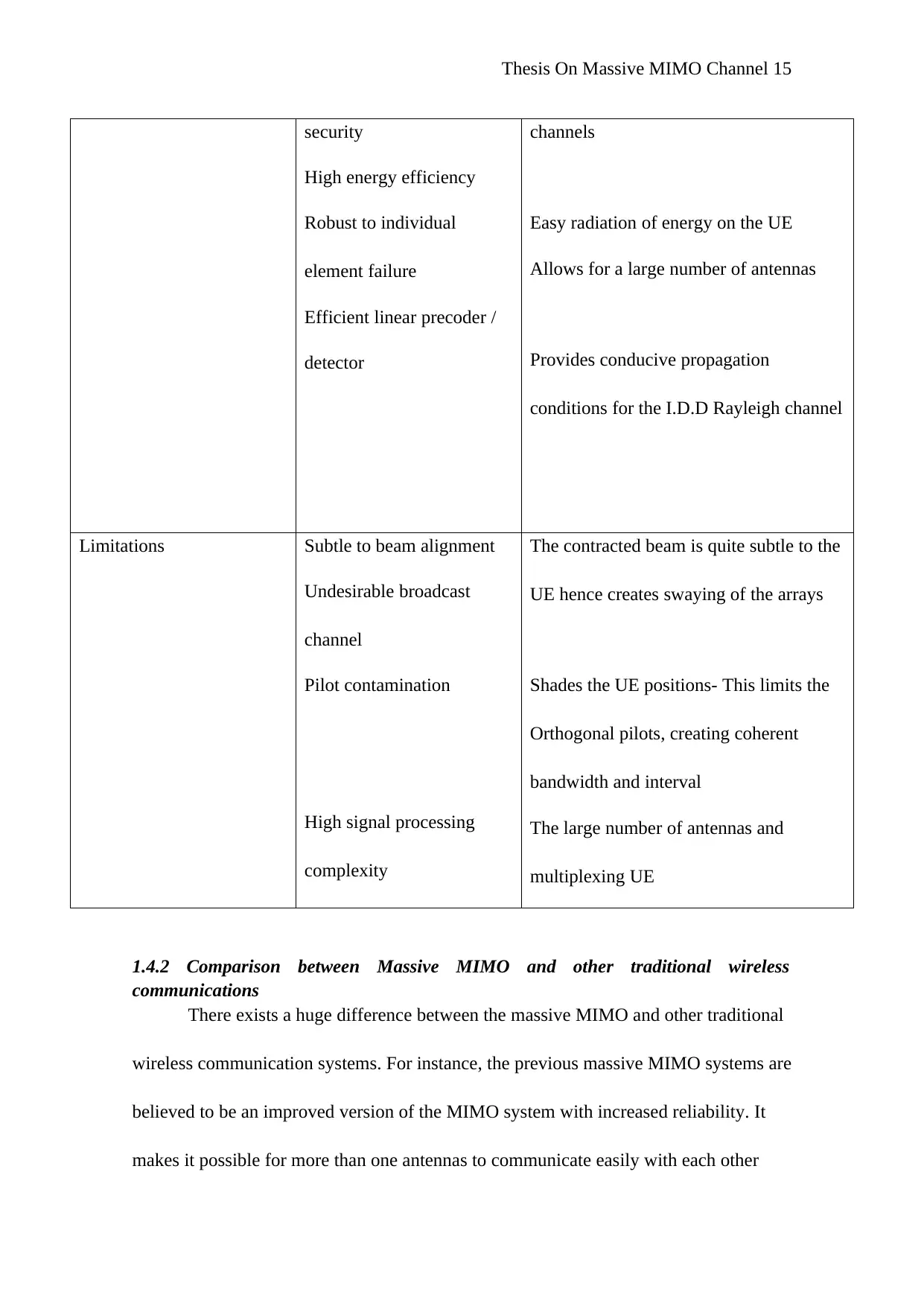
Thesis On Massive MIMO Channel 15
security
High energy efficiency
Robust to individual
element failure
Efficient linear precoder /
detector
channels
Easy radiation of energy on the UE
Allows for a large number of antennas
Provides conducive propagation
conditions for the I.D.D Rayleigh channel
Limitations Subtle to beam alignment
Undesirable broadcast
channel
Pilot contamination
High signal processing
complexity
The contracted beam is quite subtle to the
UE hence creates swaying of the arrays
Shades the UE positions- This limits the
Orthogonal pilots, creating coherent
bandwidth and interval
The large number of antennas and
multiplexing UE
1.4.2 Comparison between Massive MIMO and other traditional wireless
communications
There exists a huge difference between the massive MIMO and other traditional
wireless communication systems. For instance, the previous massive MIMO systems are
believed to be an improved version of the MIMO system with increased reliability. It
makes it possible for more than one antennas to communicate easily with each other
security
High energy efficiency
Robust to individual
element failure
Efficient linear precoder /
detector
channels
Easy radiation of energy on the UE
Allows for a large number of antennas
Provides conducive propagation
conditions for the I.D.D Rayleigh channel
Limitations Subtle to beam alignment
Undesirable broadcast
channel
Pilot contamination
High signal processing
complexity
The contracted beam is quite subtle to the
UE hence creates swaying of the arrays
Shades the UE positions- This limits the
Orthogonal pilots, creating coherent
bandwidth and interval
The large number of antennas and
multiplexing UE
1.4.2 Comparison between Massive MIMO and other traditional wireless
communications
There exists a huge difference between the massive MIMO and other traditional
wireless communication systems. For instance, the previous massive MIMO systems are
believed to be an improved version of the MIMO system with increased reliability. It
makes it possible for more than one antennas to communicate easily with each other
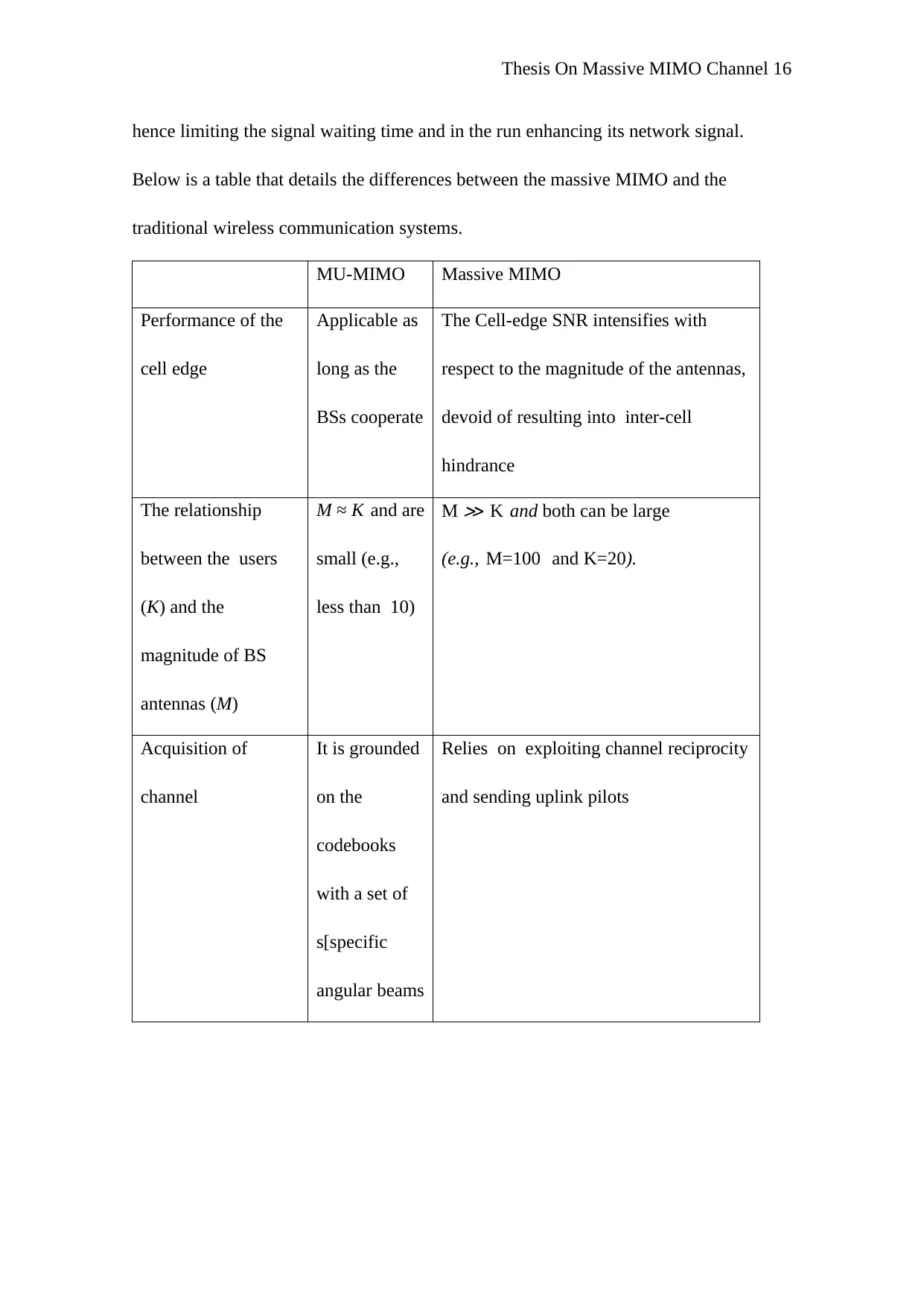
Thesis On Massive MIMO Channel 16
hence limiting the signal waiting time and in the run enhancing its network signal.
Below is a table that details the differences between the massive MIMO and the
traditional wireless communication systems.
MU-MIMO Massive MIMO
Performance of the
cell edge
Applicable as
long as the
BSs cooperate
The Cell-edge SNR intensifies with
respect to the magnitude of the antennas,
devoid of resulting into inter-cell
hindrance
The relationship
between the users
(K) and the
magnitude of BS
antennas (M)
M ≈ K and are
small (e.g.,
less than 10)
M
≫ K and both can be large
(e.g., M=100 and K=20).
Acquisition of
channel
It is grounded
on the
codebooks
with a set of
s[specific
angular beams
Relies on exploiting channel reciprocity
and sending uplink pilots
hence limiting the signal waiting time and in the run enhancing its network signal.
Below is a table that details the differences between the massive MIMO and the
traditional wireless communication systems.
MU-MIMO Massive MIMO
Performance of the
cell edge
Applicable as
long as the
BSs cooperate
The Cell-edge SNR intensifies with
respect to the magnitude of the antennas,
devoid of resulting into inter-cell
hindrance
The relationship
between the users
(K) and the
magnitude of BS
antennas (M)
M ≈ K and are
small (e.g.,
less than 10)
M
≫ K and both can be large
(e.g., M=100 and K=20).
Acquisition of
channel
It is grounded
on the
codebooks
with a set of
s[specific
angular beams
Relies on exploiting channel reciprocity
and sending uplink pilots
Secure Best Marks with AI Grader
Need help grading? Try our AI Grader for instant feedback on your assignments.
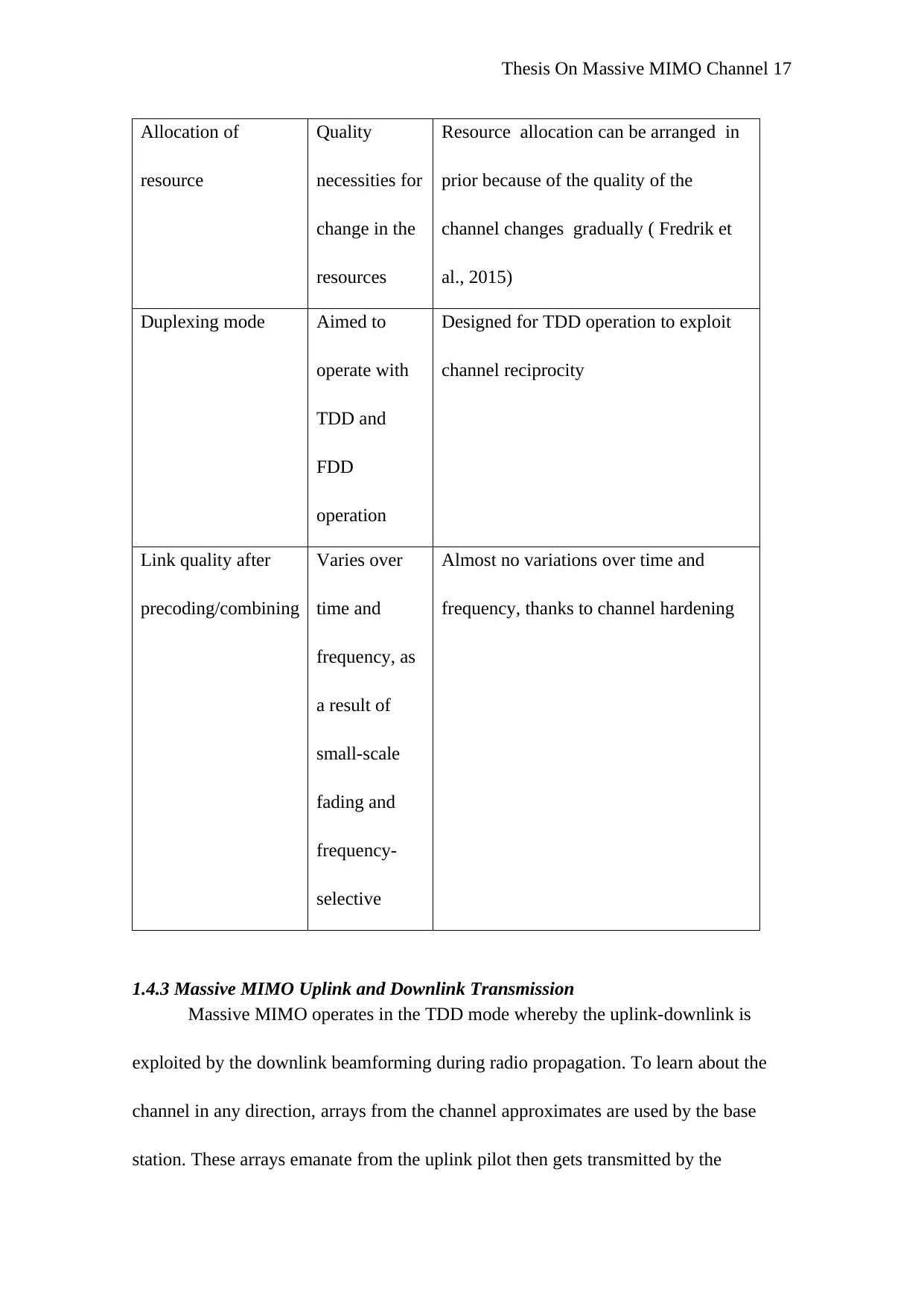
Thesis On Massive MIMO Channel 17
Allocation of
resource
Quality
necessities for
change in the
resources
Resource allocation can be arranged in
prior because of the quality of the
channel changes gradually ( Fredrik et
al., 2015)
Duplexing mode Aimed to
operate with
TDD and
FDD
operation
Designed for TDD operation to exploit
channel reciprocity
Link quality after
precoding/combining
Varies over
time and
frequency, as
a result of
small-scale
fading and
frequency-
selective
Almost no variations over time and
frequency, thanks to channel hardening
1.4.3 Massive MIMO Uplink and Downlink Transmission
Massive MIMO operates in the TDD mode whereby the uplink-downlink is
exploited by the downlink beamforming during radio propagation. To learn about the
channel in any direction, arrays from the channel approximates are used by the base
station. These arrays emanate from the uplink pilot then gets transmitted by the
Allocation of
resource
Quality
necessities for
change in the
resources
Resource allocation can be arranged in
prior because of the quality of the
channel changes gradually ( Fredrik et
al., 2015)
Duplexing mode Aimed to
operate with
TDD and
FDD
operation
Designed for TDD operation to exploit
channel reciprocity
Link quality after
precoding/combining
Varies over
time and
frequency, as
a result of
small-scale
fading and
frequency-
selective
Almost no variations over time and
frequency, thanks to channel hardening
1.4.3 Massive MIMO Uplink and Downlink Transmission
Massive MIMO operates in the TDD mode whereby the uplink-downlink is
exploited by the downlink beamforming during radio propagation. To learn about the
channel in any direction, arrays from the channel approximates are used by the base
station. These arrays emanate from the uplink pilot then gets transmitted by the
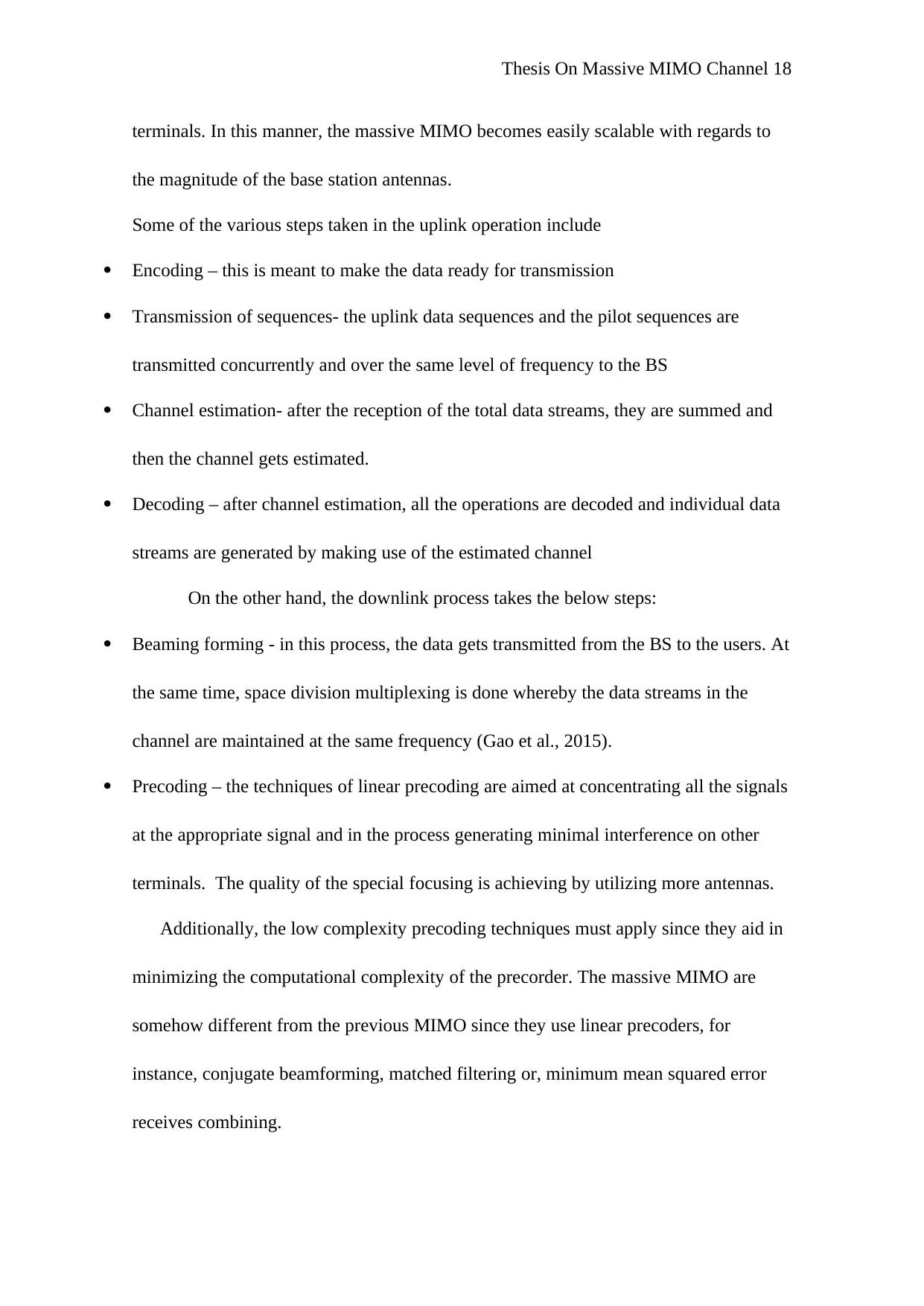
Thesis On Massive MIMO Channel 18
terminals. In this manner, the massive MIMO becomes easily scalable with regards to
the magnitude of the base station antennas.
Some of the various steps taken in the uplink operation include
Encoding – this is meant to make the data ready for transmission
Transmission of sequences- the uplink data sequences and the pilot sequences are
transmitted concurrently and over the same level of frequency to the BS
Channel estimation- after the reception of the total data streams, they are summed and
then the channel gets estimated.
Decoding – after channel estimation, all the operations are decoded and individual data
streams are generated by making use of the estimated channel
On the other hand, the downlink process takes the below steps:
Beaming forming - in this process, the data gets transmitted from the BS to the users. At
the same time, space division multiplexing is done whereby the data streams in the
channel are maintained at the same frequency (Gao et al., 2015).
Precoding – the techniques of linear precoding are aimed at concentrating all the signals
at the appropriate signal and in the process generating minimal interference on other
terminals. The quality of the special focusing is achieving by utilizing more antennas.
Additionally, the low complexity precoding techniques must apply since they aid in
minimizing the computational complexity of the precorder. The massive MIMO are
somehow different from the previous MIMO since they use linear precoders, for
instance, conjugate beamforming, matched filtering or, minimum mean squared error
receives combining.
terminals. In this manner, the massive MIMO becomes easily scalable with regards to
the magnitude of the base station antennas.
Some of the various steps taken in the uplink operation include
Encoding – this is meant to make the data ready for transmission
Transmission of sequences- the uplink data sequences and the pilot sequences are
transmitted concurrently and over the same level of frequency to the BS
Channel estimation- after the reception of the total data streams, they are summed and
then the channel gets estimated.
Decoding – after channel estimation, all the operations are decoded and individual data
streams are generated by making use of the estimated channel
On the other hand, the downlink process takes the below steps:
Beaming forming - in this process, the data gets transmitted from the BS to the users. At
the same time, space division multiplexing is done whereby the data streams in the
channel are maintained at the same frequency (Gao et al., 2015).
Precoding – the techniques of linear precoding are aimed at concentrating all the signals
at the appropriate signal and in the process generating minimal interference on other
terminals. The quality of the special focusing is achieving by utilizing more antennas.
Additionally, the low complexity precoding techniques must apply since they aid in
minimizing the computational complexity of the precorder. The massive MIMO are
somehow different from the previous MIMO since they use linear precoders, for
instance, conjugate beamforming, matched filtering or, minimum mean squared error
receives combining.
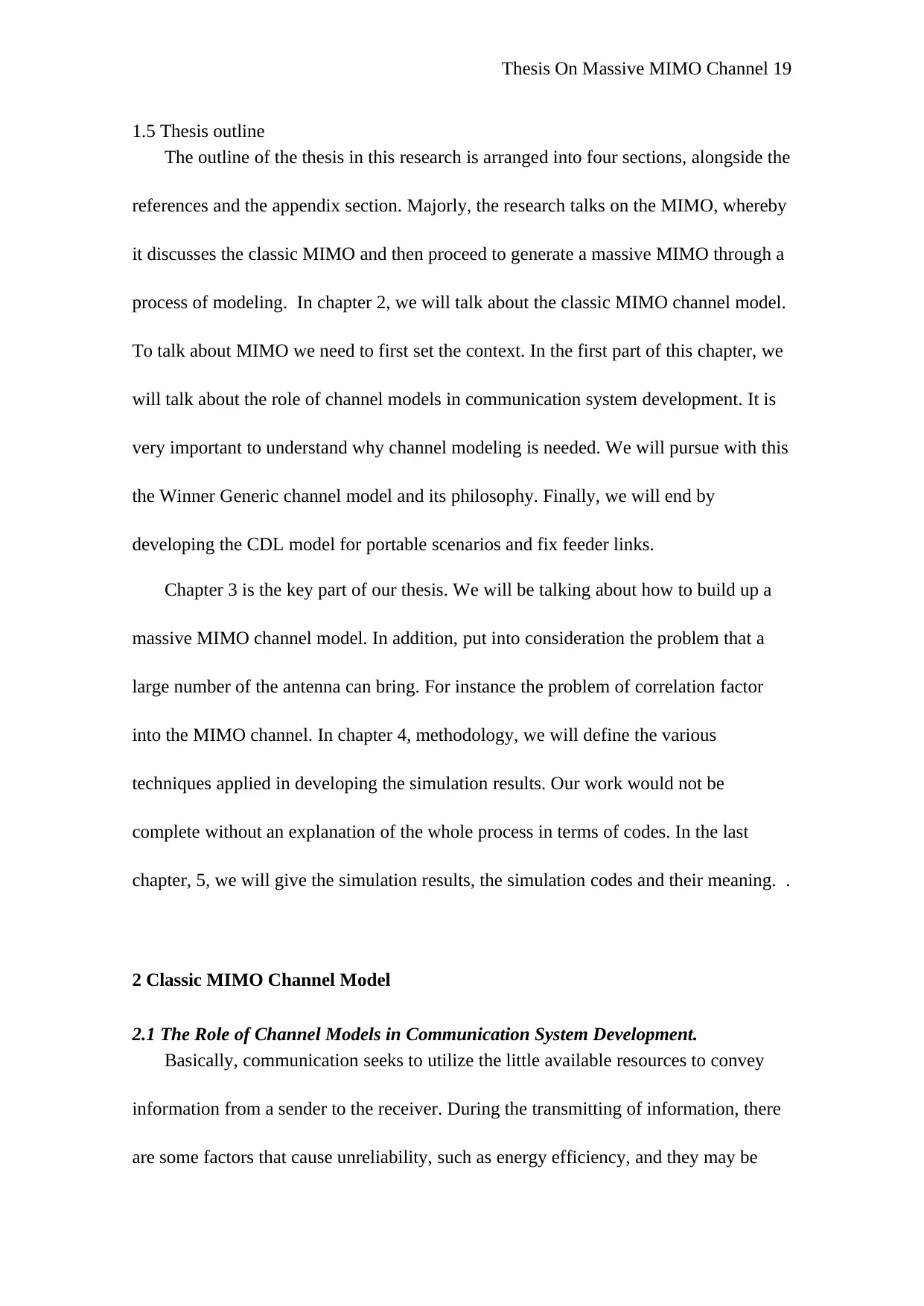
Thesis On Massive MIMO Channel 19
1.5 Thesis outline
The outline of the thesis in this research is arranged into four sections, alongside the
references and the appendix section. Majorly, the research talks on the MIMO, whereby
it discusses the classic MIMO and then proceed to generate a massive MIMO through a
process of modeling. In chapter 2, we will talk about the classic MIMO channel model.
To talk about MIMO we need to first set the context. In the first part of this chapter, we
will talk about the role of channel models in communication system development. It is
very important to understand why channel modeling is needed. We will pursue with this
the Winner Generic channel model and its philosophy. Finally, we will end by
developing the CDL model for portable scenarios and fix feeder links.
Chapter 3 is the key part of our thesis. We will be talking about how to build up a
massive MIMO channel model. In addition, put into consideration the problem that a
large number of the antenna can bring. For instance the problem of correlation factor
into the MIMO channel. In chapter 4, methodology, we will define the various
techniques applied in developing the simulation results. Our work would not be
complete without an explanation of the whole process in terms of codes. In the last
chapter, 5, we will give the simulation results, the simulation codes and their meaning. .
2 Classic MIMO Channel Model
2.1 The Role of Channel Models in Communication System Development.
Basically, communication seeks to utilize the little available resources to convey
information from a sender to the receiver. During the transmitting of information, there
are some factors that cause unreliability, such as energy efficiency, and they may be
1.5 Thesis outline
The outline of the thesis in this research is arranged into four sections, alongside the
references and the appendix section. Majorly, the research talks on the MIMO, whereby
it discusses the classic MIMO and then proceed to generate a massive MIMO through a
process of modeling. In chapter 2, we will talk about the classic MIMO channel model.
To talk about MIMO we need to first set the context. In the first part of this chapter, we
will talk about the role of channel models in communication system development. It is
very important to understand why channel modeling is needed. We will pursue with this
the Winner Generic channel model and its philosophy. Finally, we will end by
developing the CDL model for portable scenarios and fix feeder links.
Chapter 3 is the key part of our thesis. We will be talking about how to build up a
massive MIMO channel model. In addition, put into consideration the problem that a
large number of the antenna can bring. For instance the problem of correlation factor
into the MIMO channel. In chapter 4, methodology, we will define the various
techniques applied in developing the simulation results. Our work would not be
complete without an explanation of the whole process in terms of codes. In the last
chapter, 5, we will give the simulation results, the simulation codes and their meaning. .
2 Classic MIMO Channel Model
2.1 The Role of Channel Models in Communication System Development.
Basically, communication seeks to utilize the little available resources to convey
information from a sender to the receiver. During the transmitting of information, there
are some factors that cause unreliability, such as energy efficiency, and they may be
Paraphrase This Document
Need a fresh take? Get an instant paraphrase of this document with our AI Paraphraser
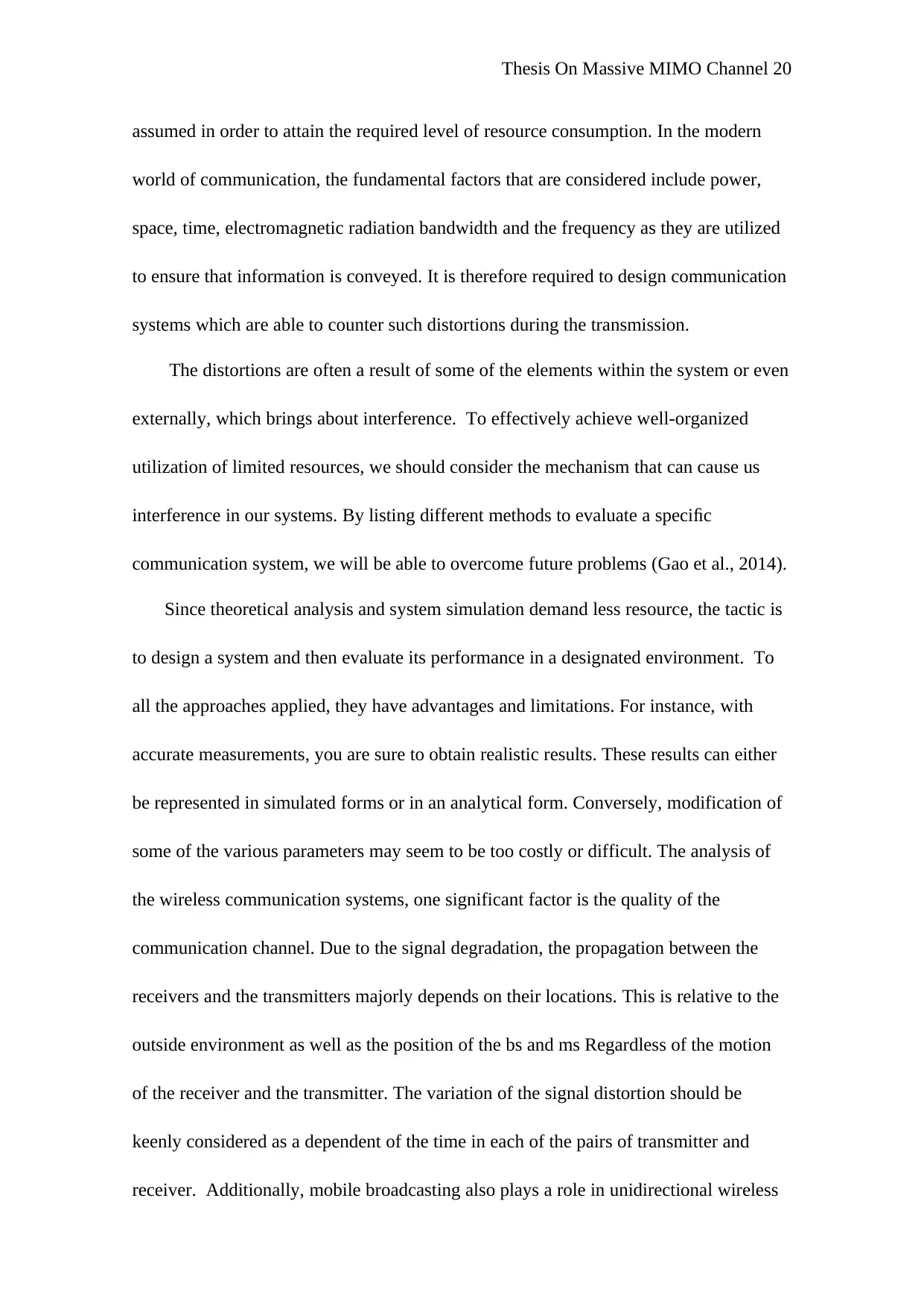
Thesis On Massive MIMO Channel 20
assumed in order to attain the required level of resource consumption. In the modern
world of communication, the fundamental factors that are considered include power,
space, time, electromagnetic radiation bandwidth and the frequency as they are utilized
to ensure that information is conveyed. It is therefore required to design communication
systems which are able to counter such distortions during the transmission.
The distortions are often a result of some of the elements within the system or even
externally, which brings about interference. To effectively achieve well-organized
utilization of limited resources, we should consider the mechanism that can cause us
interference in our systems. By listing different methods to evaluate a specific
communication system, we will be able to overcome future problems (Gao et al., 2014).
Since theoretical analysis and system simulation demand less resource, the tactic is
to design a system and then evaluate its performance in a designated environment. To
all the approaches applied, they have advantages and limitations. For instance, with
accurate measurements, you are sure to obtain realistic results. These results can either
be represented in simulated forms or in an analytical form. Conversely, modification of
some of the various parameters may seem to be too costly or difficult. The analysis of
the wireless communication systems, one significant factor is the quality of the
communication channel. Due to the signal degradation, the propagation between the
receivers and the transmitters majorly depends on their locations. This is relative to the
outside environment as well as the position of the bs and ms Regardless of the motion
of the receiver and the transmitter. The variation of the signal distortion should be
keenly considered as a dependent of the time in each of the pairs of transmitter and
receiver. Additionally, mobile broadcasting also plays a role in unidirectional wireless
assumed in order to attain the required level of resource consumption. In the modern
world of communication, the fundamental factors that are considered include power,
space, time, electromagnetic radiation bandwidth and the frequency as they are utilized
to ensure that information is conveyed. It is therefore required to design communication
systems which are able to counter such distortions during the transmission.
The distortions are often a result of some of the elements within the system or even
externally, which brings about interference. To effectively achieve well-organized
utilization of limited resources, we should consider the mechanism that can cause us
interference in our systems. By listing different methods to evaluate a specific
communication system, we will be able to overcome future problems (Gao et al., 2014).
Since theoretical analysis and system simulation demand less resource, the tactic is
to design a system and then evaluate its performance in a designated environment. To
all the approaches applied, they have advantages and limitations. For instance, with
accurate measurements, you are sure to obtain realistic results. These results can either
be represented in simulated forms or in an analytical form. Conversely, modification of
some of the various parameters may seem to be too costly or difficult. The analysis of
the wireless communication systems, one significant factor is the quality of the
communication channel. Due to the signal degradation, the propagation between the
receivers and the transmitters majorly depends on their locations. This is relative to the
outside environment as well as the position of the bs and ms Regardless of the motion
of the receiver and the transmitter. The variation of the signal distortion should be
keenly considered as a dependent of the time in each of the pairs of transmitter and
receiver. Additionally, mobile broadcasting also plays a role in unidirectional wireless
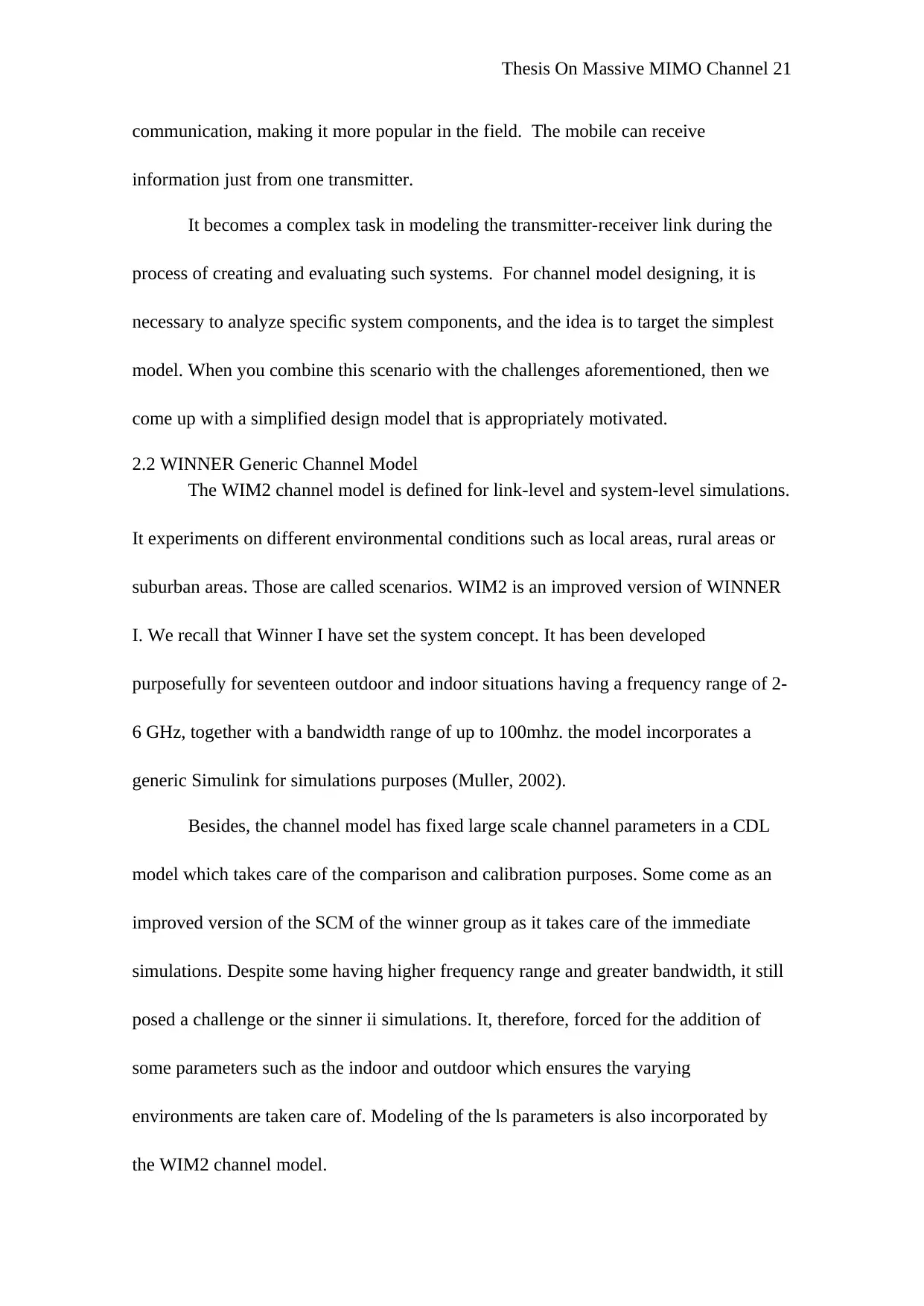
Thesis On Massive MIMO Channel 21
communication, making it more popular in the field. The mobile can receive
information just from one transmitter.
It becomes a complex task in modeling the transmitter-receiver link during the
process of creating and evaluating such systems. For channel model designing, it is
necessary to analyze specific system components, and the idea is to target the simplest
model. When you combine this scenario with the challenges aforementioned, then we
come up with a simplified design model that is appropriately motivated.
2.2 WINNER Generic Channel Model
The WIM2 channel model is defined for link-level and system-level simulations.
It experiments on different environmental conditions such as local areas, rural areas or
suburban areas. Those are called scenarios. WIM2 is an improved version of WINNER
I. We recall that Winner I have set the system concept. It has been developed
purposefully for seventeen outdoor and indoor situations having a frequency range of 2-
6 GHz, together with a bandwidth range of up to 100mhz. the model incorporates a
generic Simulink for simulations purposes (Muller, 2002).
Besides, the channel model has fixed large scale channel parameters in a CDL
model which takes care of the comparison and calibration purposes. Some come as an
improved version of the SCM of the winner group as it takes care of the immediate
simulations. Despite some having higher frequency range and greater bandwidth, it still
posed a challenge or the sinner ii simulations. It, therefore, forced for the addition of
some parameters such as the indoor and outdoor which ensures the varying
environments are taken care of. Modeling of the ls parameters is also incorporated by
the WIM2 channel model.
communication, making it more popular in the field. The mobile can receive
information just from one transmitter.
It becomes a complex task in modeling the transmitter-receiver link during the
process of creating and evaluating such systems. For channel model designing, it is
necessary to analyze specific system components, and the idea is to target the simplest
model. When you combine this scenario with the challenges aforementioned, then we
come up with a simplified design model that is appropriately motivated.
2.2 WINNER Generic Channel Model
The WIM2 channel model is defined for link-level and system-level simulations.
It experiments on different environmental conditions such as local areas, rural areas or
suburban areas. Those are called scenarios. WIM2 is an improved version of WINNER
I. We recall that Winner I have set the system concept. It has been developed
purposefully for seventeen outdoor and indoor situations having a frequency range of 2-
6 GHz, together with a bandwidth range of up to 100mhz. the model incorporates a
generic Simulink for simulations purposes (Muller, 2002).
Besides, the channel model has fixed large scale channel parameters in a CDL
model which takes care of the comparison and calibration purposes. Some come as an
improved version of the SCM of the winner group as it takes care of the immediate
simulations. Despite some having higher frequency range and greater bandwidth, it still
posed a challenge or the sinner ii simulations. It, therefore, forced for the addition of
some parameters such as the indoor and outdoor which ensures the varying
environments are taken care of. Modeling of the ls parameters is also incorporated by
the WIM2 channel model.
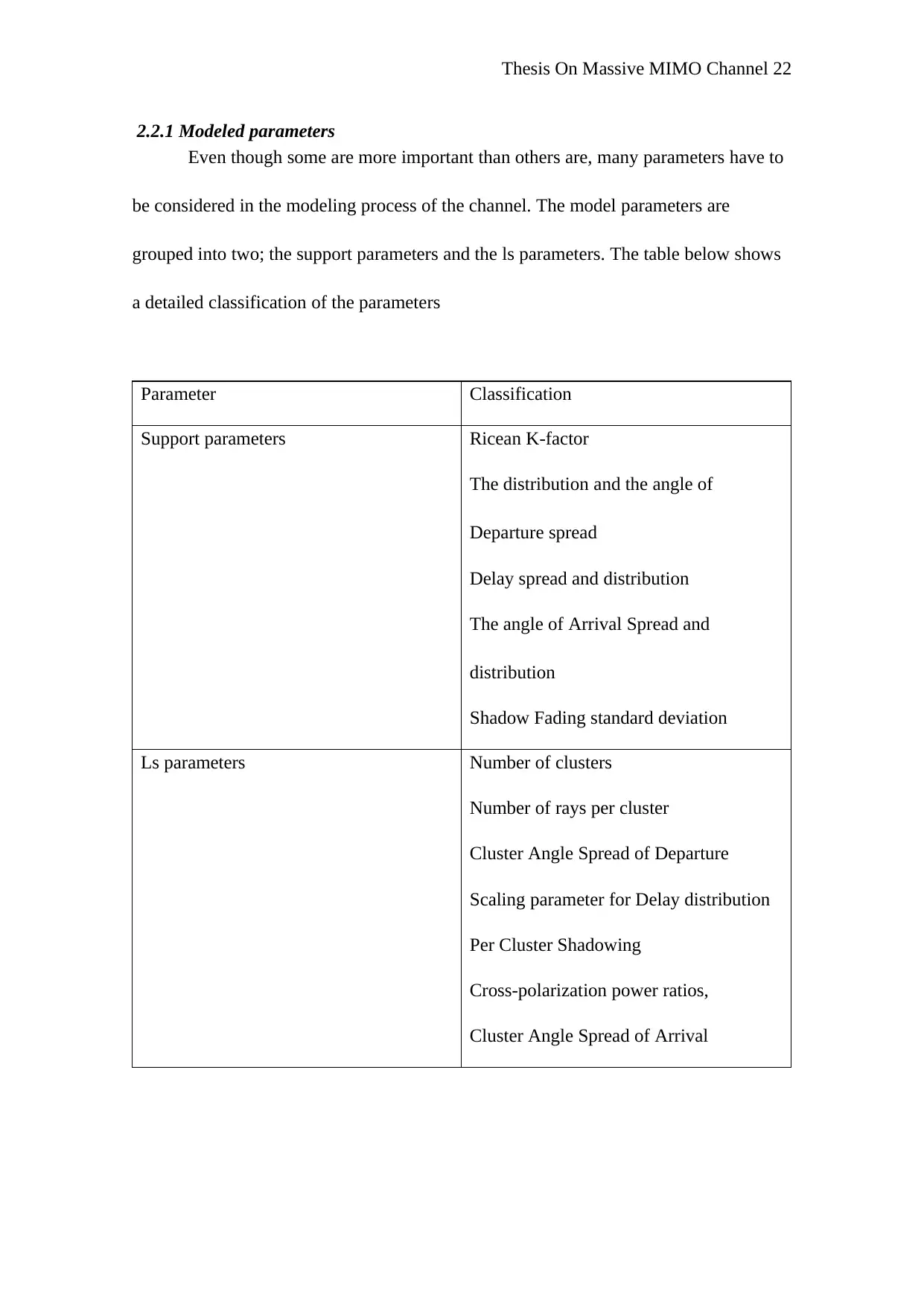
Thesis On Massive MIMO Channel 22
2.2.1 Modeled parameters
Even though some are more important than others are, many parameters have to
be considered in the modeling process of the channel. The model parameters are
grouped into two; the support parameters and the ls parameters. The table below shows
a detailed classification of the parameters
Parameter Classification
Support parameters Ricean K-factor
The distribution and the angle of
Departure spread
Delay spread and distribution
The angle of Arrival Spread and
distribution
Shadow Fading standard deviation
Ls parameters Number of clusters
Number of rays per cluster
Cluster Angle Spread of Departure
Scaling parameter for Delay distribution
Per Cluster Shadowing
Cross-polarization power ratios,
Cluster Angle Spread of Arrival
2.2.1 Modeled parameters
Even though some are more important than others are, many parameters have to
be considered in the modeling process of the channel. The model parameters are
grouped into two; the support parameters and the ls parameters. The table below shows
a detailed classification of the parameters
Parameter Classification
Support parameters Ricean K-factor
The distribution and the angle of
Departure spread
Delay spread and distribution
The angle of Arrival Spread and
distribution
Shadow Fading standard deviation
Ls parameters Number of clusters
Number of rays per cluster
Cluster Angle Spread of Departure
Scaling parameter for Delay distribution
Per Cluster Shadowing
Cross-polarization power ratios,
Cluster Angle Spread of Arrival
Secure Best Marks with AI Grader
Need help grading? Try our AI Grader for instant feedback on your assignments.
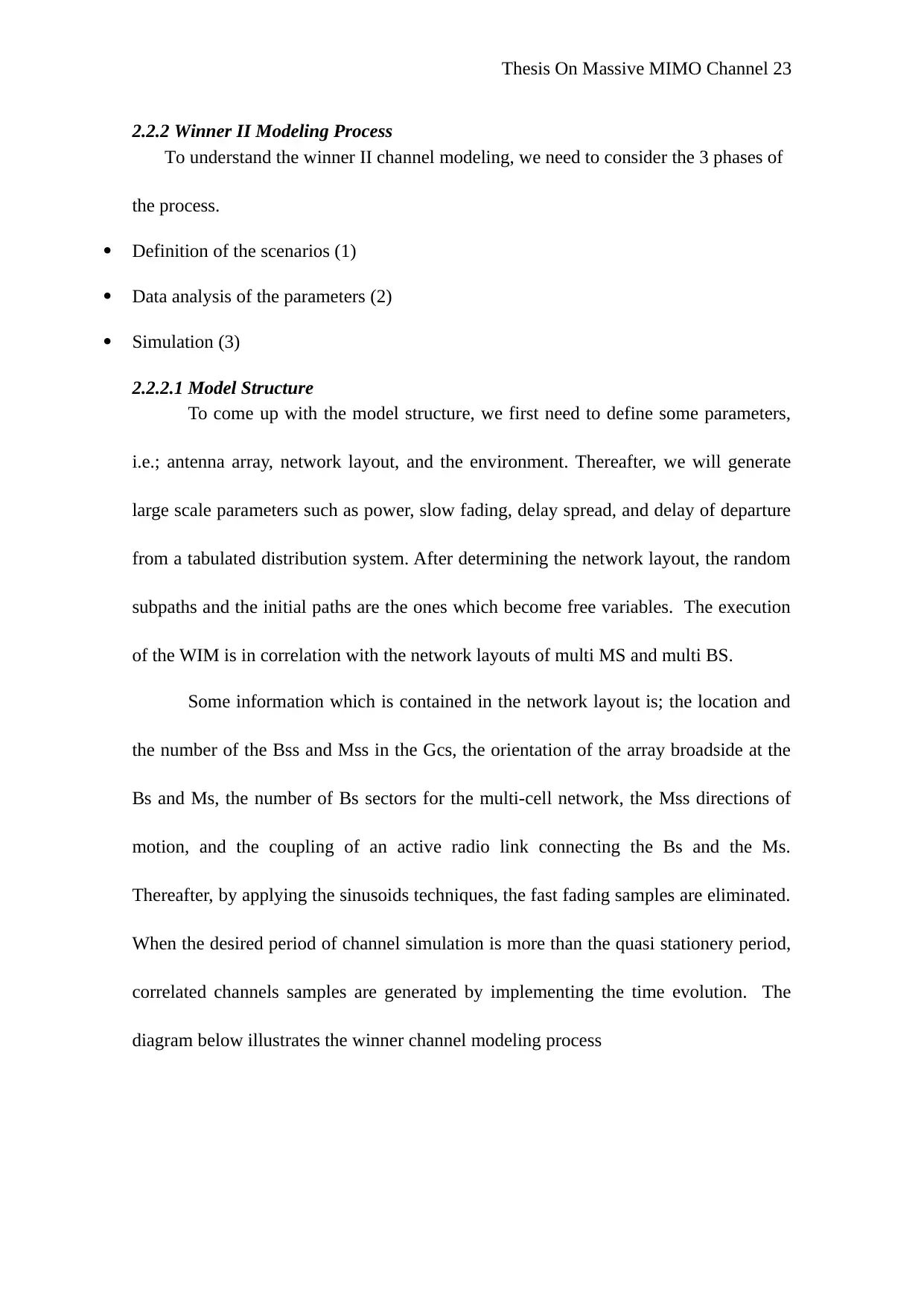
Thesis On Massive MIMO Channel 23
2.2.2 Winner II Modeling Process
To understand the winner II channel modeling, we need to consider the 3 phases of
the process.
Definition of the scenarios (1)
Data analysis of the parameters (2)
Simulation (3)
2.2.2.1 Model Structure
To come up with the model structure, we first need to define some parameters,
i.e.; antenna array, network layout, and the environment. Thereafter, we will generate
large scale parameters such as power, slow fading, delay spread, and delay of departure
from a tabulated distribution system. After determining the network layout, the random
subpaths and the initial paths are the ones which become free variables. The execution
of the WIM is in correlation with the network layouts of multi MS and multi BS.
Some information which is contained in the network layout is; the location and
the number of the Bss and Mss in the Gcs, the orientation of the array broadside at the
Bs and Ms, the number of Bs sectors for the multi-cell network, the Mss directions of
motion, and the coupling of an active radio link connecting the Bs and the Ms.
Thereafter, by applying the sinusoids techniques, the fast fading samples are eliminated.
When the desired period of channel simulation is more than the quasi stationery period,
correlated channels samples are generated by implementing the time evolution. The
diagram below illustrates the winner channel modeling process
2.2.2 Winner II Modeling Process
To understand the winner II channel modeling, we need to consider the 3 phases of
the process.
Definition of the scenarios (1)
Data analysis of the parameters (2)
Simulation (3)
2.2.2.1 Model Structure
To come up with the model structure, we first need to define some parameters,
i.e.; antenna array, network layout, and the environment. Thereafter, we will generate
large scale parameters such as power, slow fading, delay spread, and delay of departure
from a tabulated distribution system. After determining the network layout, the random
subpaths and the initial paths are the ones which become free variables. The execution
of the WIM is in correlation with the network layouts of multi MS and multi BS.
Some information which is contained in the network layout is; the location and
the number of the Bss and Mss in the Gcs, the orientation of the array broadside at the
Bs and Ms, the number of Bs sectors for the multi-cell network, the Mss directions of
motion, and the coupling of an active radio link connecting the Bs and the Ms.
Thereafter, by applying the sinusoids techniques, the fast fading samples are eliminated.
When the desired period of channel simulation is more than the quasi stationery period,
correlated channels samples are generated by implementing the time evolution. The
diagram below illustrates the winner channel modeling process
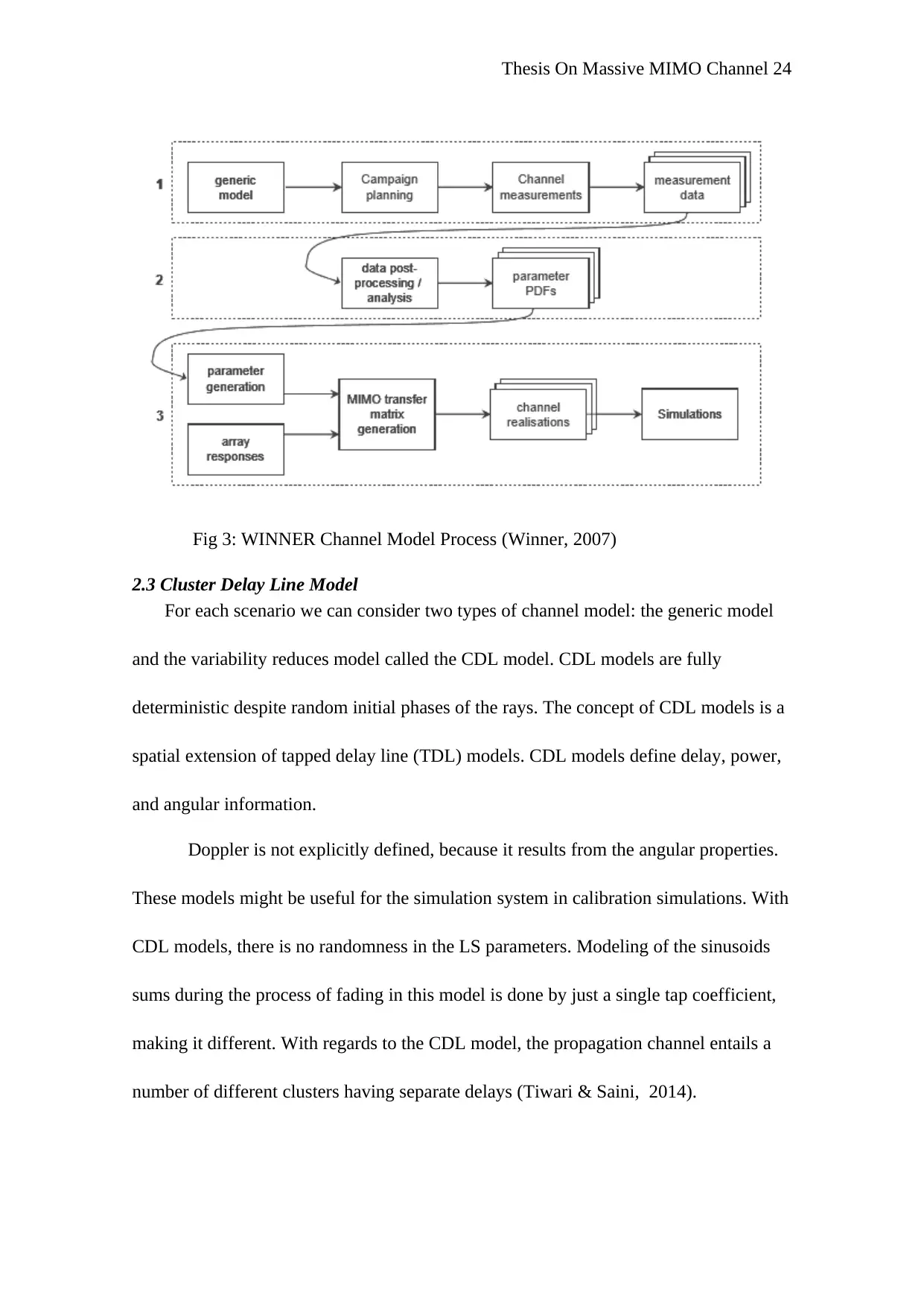
Thesis On Massive MIMO Channel 24
Fig 3: WINNER Channel Model Process (Winner, 2007)
2.3 Cluster Delay Line Model
For each scenario we can consider two types of channel model: the generic model
and the variability reduces model called the CDL model. CDL models are fully
deterministic despite random initial phases of the rays. The concept of CDL models is a
spatial extension of tapped delay line (TDL) models. CDL models define delay, power,
and angular information.
Doppler is not explicitly defined, because it results from the angular properties.
These models might be useful for the simulation system in calibration simulations. With
CDL models, there is no randomness in the LS parameters. Modeling of the sinusoids
sums during the process of fading in this model is done by just a single tap coefficient,
making it different. With regards to the CDL model, the propagation channel entails a
number of different clusters having separate delays (Tiwari & Saini, 2014).
Fig 3: WINNER Channel Model Process (Winner, 2007)
2.3 Cluster Delay Line Model
For each scenario we can consider two types of channel model: the generic model
and the variability reduces model called the CDL model. CDL models are fully
deterministic despite random initial phases of the rays. The concept of CDL models is a
spatial extension of tapped delay line (TDL) models. CDL models define delay, power,
and angular information.
Doppler is not explicitly defined, because it results from the angular properties.
These models might be useful for the simulation system in calibration simulations. With
CDL models, there is no randomness in the LS parameters. Modeling of the sinusoids
sums during the process of fading in this model is done by just a single tap coefficient,
making it different. With regards to the CDL model, the propagation channel entails a
number of different clusters having separate delays (Tiwari & Saini, 2014).
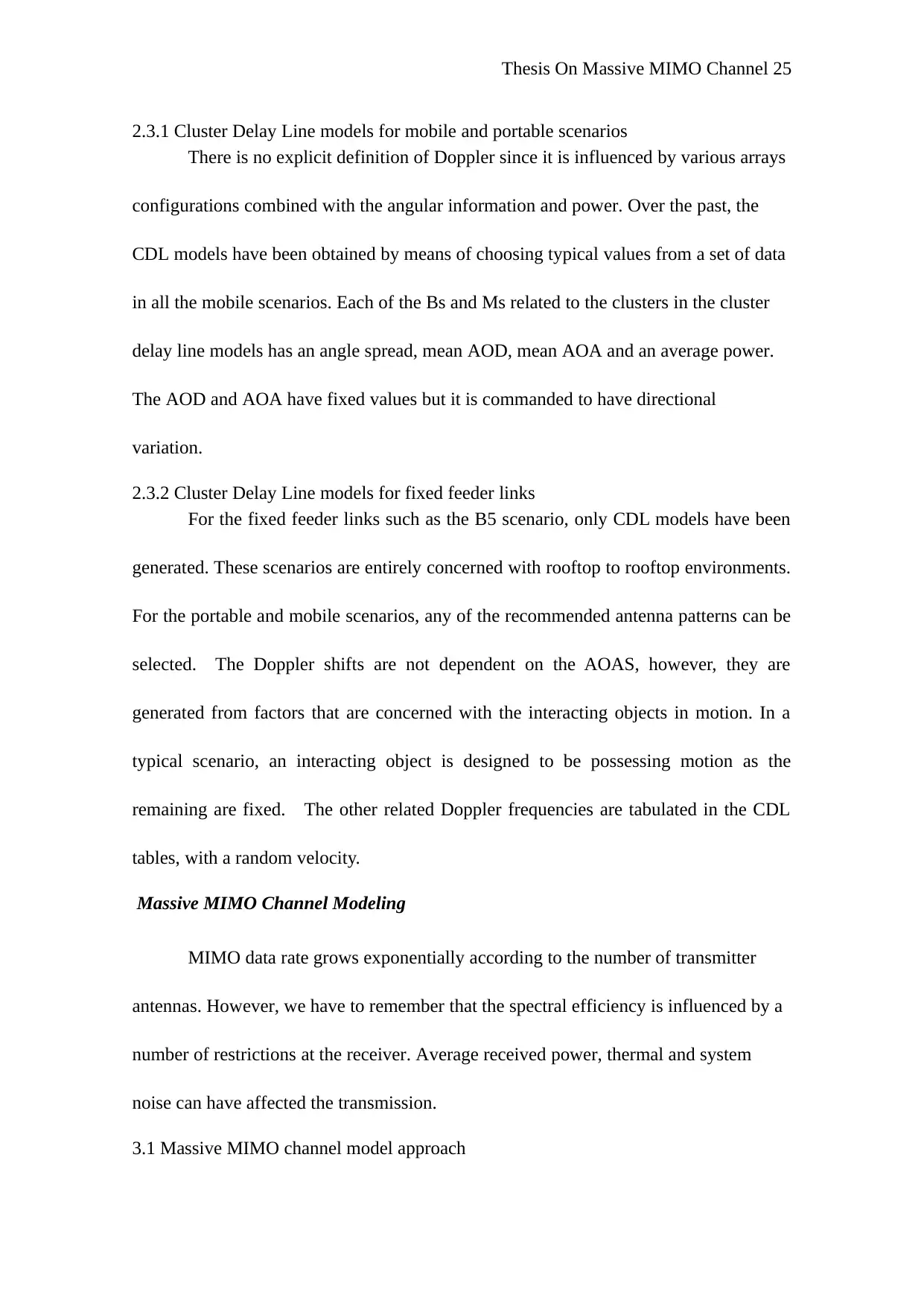
Thesis On Massive MIMO Channel 25
2.3.1 Cluster Delay Line models for mobile and portable scenarios
There is no explicit definition of Doppler since it is influenced by various arrays
configurations combined with the angular information and power. Over the past, the
CDL models have been obtained by means of choosing typical values from a set of data
in all the mobile scenarios. Each of the Bs and Ms related to the clusters in the cluster
delay line models has an angle spread, mean AOD, mean AOA and an average power.
The AOD and AOA have fixed values but it is commanded to have directional
variation.
2.3.2 Cluster Delay Line models for fixed feeder links
For the fixed feeder links such as the B5 scenario, only CDL models have been
generated. These scenarios are entirely concerned with rooftop to rooftop environments.
For the portable and mobile scenarios, any of the recommended antenna patterns can be
selected. The Doppler shifts are not dependent on the AOAS, however, they are
generated from factors that are concerned with the interacting objects in motion. In a
typical scenario, an interacting object is designed to be possessing motion as the
remaining are fixed. The other related Doppler frequencies are tabulated in the CDL
tables, with a random velocity.
Massive MIMO Channel Modeling
MIMO data rate grows exponentially according to the number of transmitter
antennas. However, we have to remember that the spectral efficiency is influenced by a
number of restrictions at the receiver. Average received power, thermal and system
noise can have affected the transmission.
3.1 Massive MIMO channel model approach
2.3.1 Cluster Delay Line models for mobile and portable scenarios
There is no explicit definition of Doppler since it is influenced by various arrays
configurations combined with the angular information and power. Over the past, the
CDL models have been obtained by means of choosing typical values from a set of data
in all the mobile scenarios. Each of the Bs and Ms related to the clusters in the cluster
delay line models has an angle spread, mean AOD, mean AOA and an average power.
The AOD and AOA have fixed values but it is commanded to have directional
variation.
2.3.2 Cluster Delay Line models for fixed feeder links
For the fixed feeder links such as the B5 scenario, only CDL models have been
generated. These scenarios are entirely concerned with rooftop to rooftop environments.
For the portable and mobile scenarios, any of the recommended antenna patterns can be
selected. The Doppler shifts are not dependent on the AOAS, however, they are
generated from factors that are concerned with the interacting objects in motion. In a
typical scenario, an interacting object is designed to be possessing motion as the
remaining are fixed. The other related Doppler frequencies are tabulated in the CDL
tables, with a random velocity.
Massive MIMO Channel Modeling
MIMO data rate grows exponentially according to the number of transmitter
antennas. However, we have to remember that the spectral efficiency is influenced by a
number of restrictions at the receiver. Average received power, thermal and system
noise can have affected the transmission.
3.1 Massive MIMO channel model approach
Paraphrase This Document
Need a fresh take? Get an instant paraphrase of this document with our AI Paraphraser
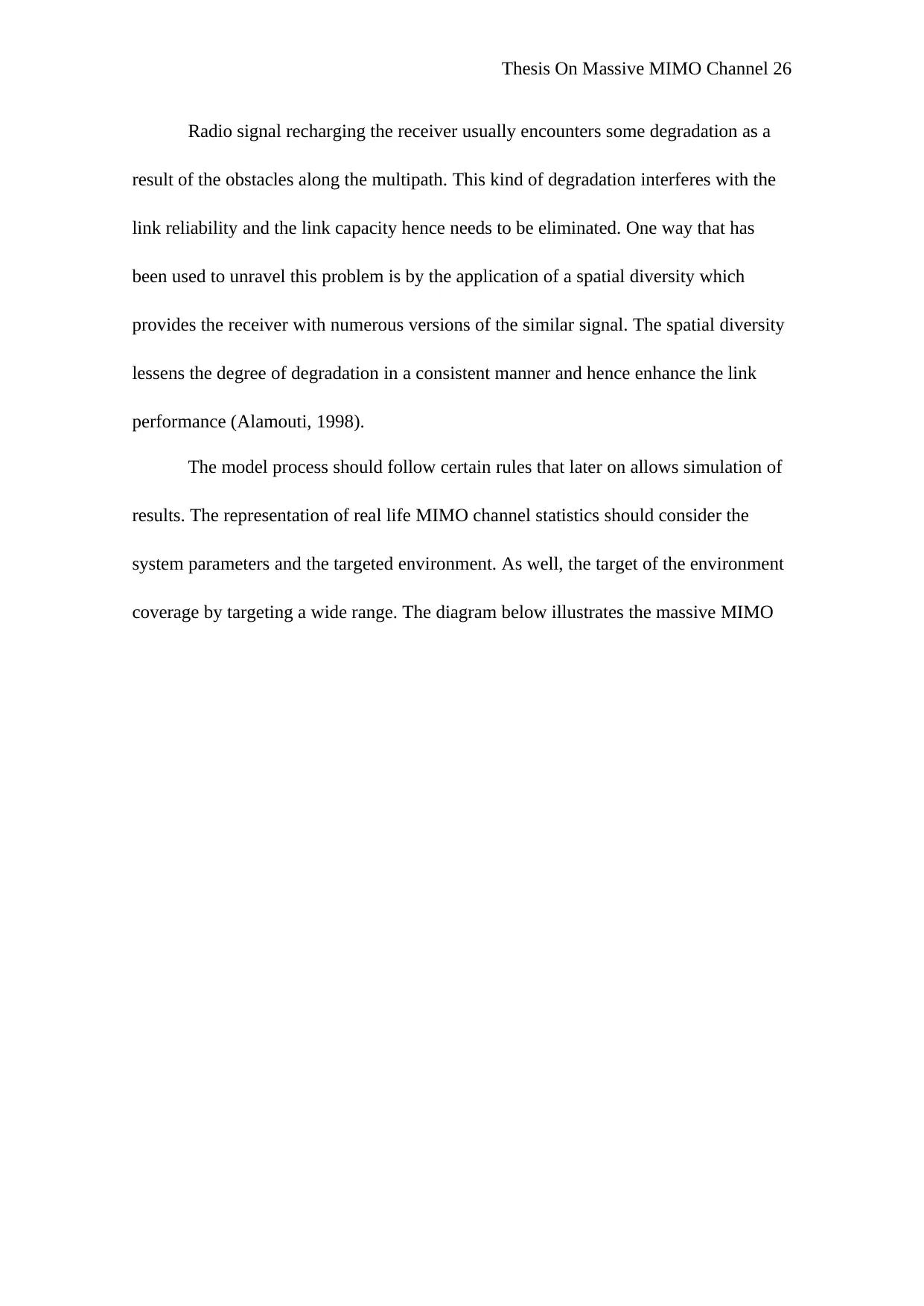
Thesis On Massive MIMO Channel 26
Radio signal recharging the receiver usually encounters some degradation as a
result of the obstacles along the multipath. This kind of degradation interferes with the
link reliability and the link capacity hence needs to be eliminated. One way that has
been used to unravel this problem is by the application of a spatial diversity which
provides the receiver with numerous versions of the similar signal. The spatial diversity
lessens the degree of degradation in a consistent manner and hence enhance the link
performance (Alamouti, 1998).
The model process should follow certain rules that later on allows simulation of
results. The representation of real life MIMO channel statistics should consider the
system parameters and the targeted environment. As well, the target of the environment
coverage by targeting a wide range. The diagram below illustrates the massive MIMO
Radio signal recharging the receiver usually encounters some degradation as a
result of the obstacles along the multipath. This kind of degradation interferes with the
link reliability and the link capacity hence needs to be eliminated. One way that has
been used to unravel this problem is by the application of a spatial diversity which
provides the receiver with numerous versions of the similar signal. The spatial diversity
lessens the degree of degradation in a consistent manner and hence enhance the link
performance (Alamouti, 1998).
The model process should follow certain rules that later on allows simulation of
results. The representation of real life MIMO channel statistics should consider the
system parameters and the targeted environment. As well, the target of the environment
coverage by targeting a wide range. The diagram below illustrates the massive MIMO
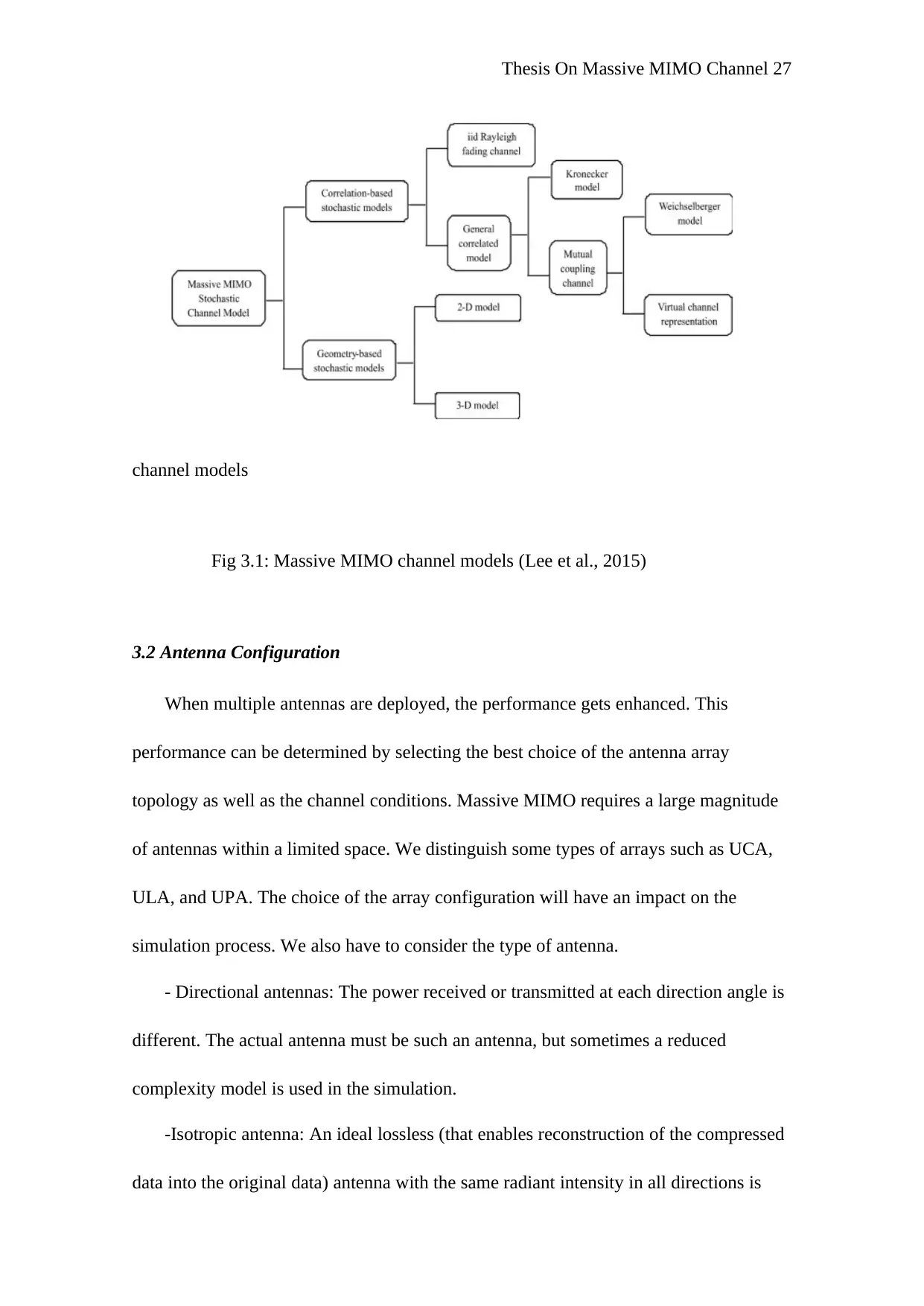
Thesis On Massive MIMO Channel 27
channel models
Fig 3.1: Massive MIMO channel models (Lee et al., 2015)
3.2 Antenna Configuration
When multiple antennas are deployed, the performance gets enhanced. This
performance can be determined by selecting the best choice of the antenna array
topology as well as the channel conditions. Massive MIMO requires a large magnitude
of antennas within a limited space. We distinguish some types of arrays such as UCA,
ULA, and UPA. The choice of the array configuration will have an impact on the
simulation process. We also have to consider the type of antenna.
- Directional antennas: The power received or transmitted at each direction angle is
different. The actual antenna must be such an antenna, but sometimes a reduced
complexity model is used in the simulation.
-Isotropic antenna: An ideal lossless (that enables reconstruction of the compressed
data into the original data) antenna with the same radiant intensity in all directions is
channel models
Fig 3.1: Massive MIMO channel models (Lee et al., 2015)
3.2 Antenna Configuration
When multiple antennas are deployed, the performance gets enhanced. This
performance can be determined by selecting the best choice of the antenna array
topology as well as the channel conditions. Massive MIMO requires a large magnitude
of antennas within a limited space. We distinguish some types of arrays such as UCA,
ULA, and UPA. The choice of the array configuration will have an impact on the
simulation process. We also have to consider the type of antenna.
- Directional antennas: The power received or transmitted at each direction angle is
different. The actual antenna must be such an antenna, but sometimes a reduced
complexity model is used in the simulation.
-Isotropic antenna: An ideal lossless (that enables reconstruction of the compressed
data into the original data) antenna with the same radiant intensity in all directions is
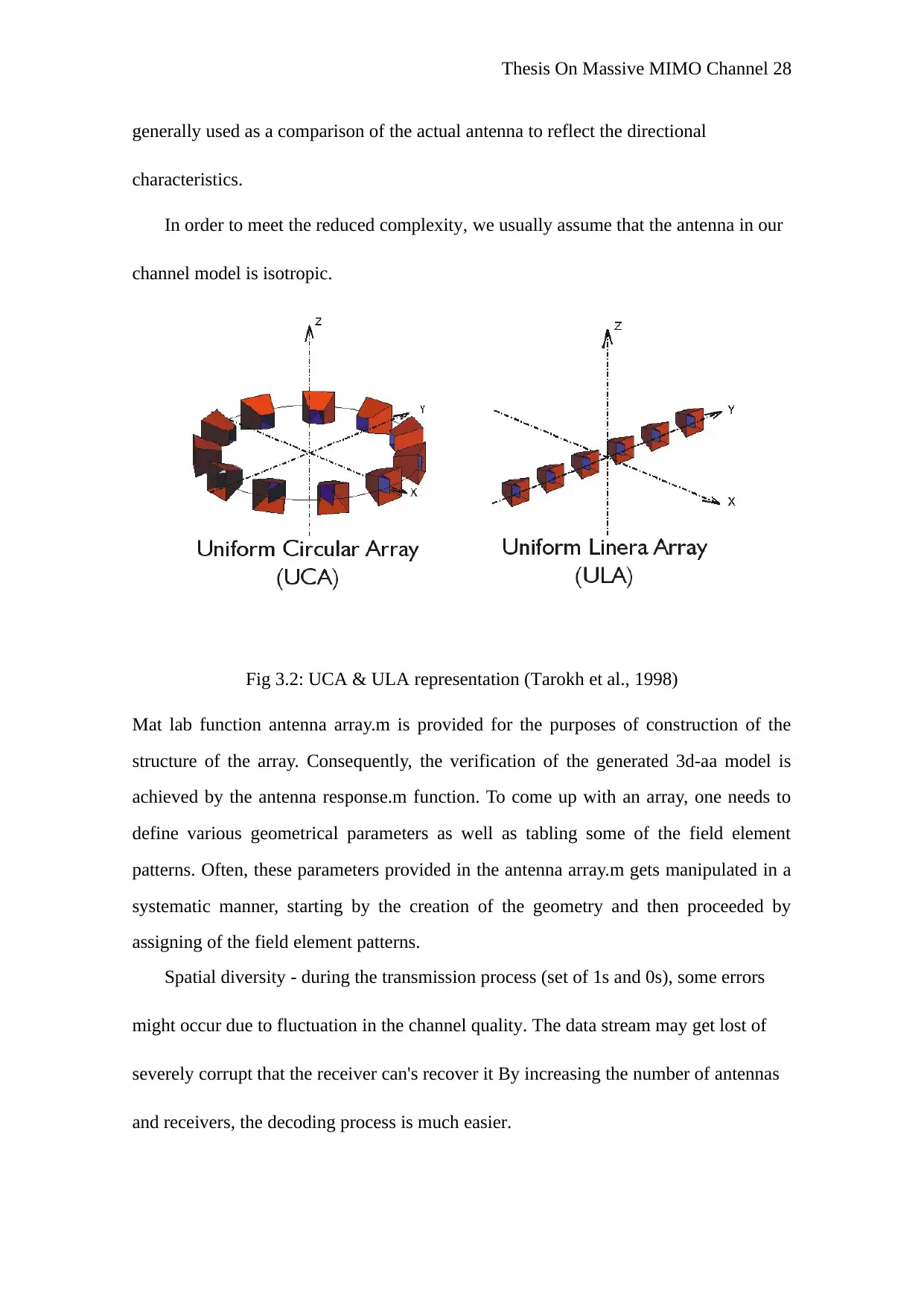
Thesis On Massive MIMO Channel 28
generally used as a comparison of the actual antenna to reflect the directional
characteristics.
In order to meet the reduced complexity, we usually assume that the antenna in our
channel model is isotropic.
Fig 3.2: UCA & ULA representation (Tarokh et al., 1998)
Mat lab function antenna array.m is provided for the purposes of construction of the
structure of the array. Consequently, the verification of the generated 3d-aa model is
achieved by the antenna response.m function. To come up with an array, one needs to
define various geometrical parameters as well as tabling some of the field element
patterns. Often, these parameters provided in the antenna array.m gets manipulated in a
systematic manner, starting by the creation of the geometry and then proceeded by
assigning of the field element patterns.
Spatial diversity - during the transmission process (set of 1s and 0s), some errors
might occur due to fluctuation in the channel quality. The data stream may get lost of
severely corrupt that the receiver can's recover it By increasing the number of antennas
and receivers, the decoding process is much easier.
generally used as a comparison of the actual antenna to reflect the directional
characteristics.
In order to meet the reduced complexity, we usually assume that the antenna in our
channel model is isotropic.
Fig 3.2: UCA & ULA representation (Tarokh et al., 1998)
Mat lab function antenna array.m is provided for the purposes of construction of the
structure of the array. Consequently, the verification of the generated 3d-aa model is
achieved by the antenna response.m function. To come up with an array, one needs to
define various geometrical parameters as well as tabling some of the field element
patterns. Often, these parameters provided in the antenna array.m gets manipulated in a
systematic manner, starting by the creation of the geometry and then proceeded by
assigning of the field element patterns.
Spatial diversity - during the transmission process (set of 1s and 0s), some errors
might occur due to fluctuation in the channel quality. The data stream may get lost of
severely corrupt that the receiver can's recover it By increasing the number of antennas
and receivers, the decoding process is much easier.
Secure Best Marks with AI Grader
Need help grading? Try our AI Grader for instant feedback on your assignments.
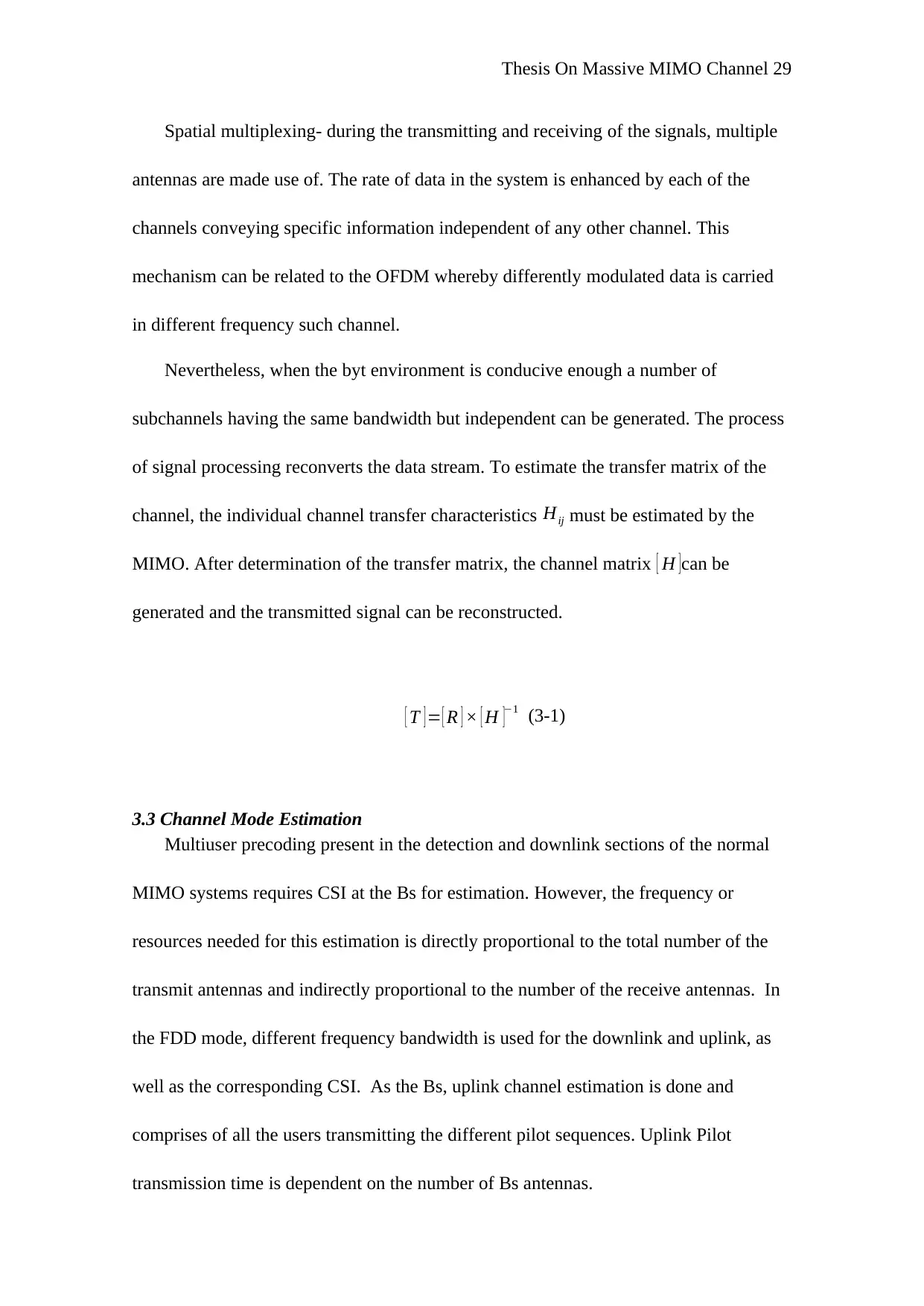
Thesis On Massive MIMO Channel 29
Spatial multiplexing- during the transmitting and receiving of the signals, multiple
antennas are made use of. The rate of data in the system is enhanced by each of the
channels conveying specific information independent of any other channel. This
mechanism can be related to the OFDM whereby differently modulated data is carried
in different frequency such channel.
Nevertheless, when the byt environment is conducive enough a number of
subchannels having the same bandwidth but independent can be generated. The process
of signal processing reconverts the data stream. To estimate the transfer matrix of the
channel, the individual channel transfer characteristics Hij must be estimated by the
MIMO. After determination of the transfer matrix, the channel matrix [ H ]can be
generated and the transmitted signal can be reconstructed.
[ T ] = [ R ] × [ H ]−1 (3-1)
3.3 Channel Mode Estimation
Multiuser precoding present in the detection and downlink sections of the normal
MIMO systems requires CSI at the Bs for estimation. However, the frequency or
resources needed for this estimation is directly proportional to the total number of the
transmit antennas and indirectly proportional to the number of the receive antennas. In
the FDD mode, different frequency bandwidth is used for the downlink and uplink, as
well as the corresponding CSI. As the Bs, uplink channel estimation is done and
comprises of all the users transmitting the different pilot sequences. Uplink Pilot
transmission time is dependent on the number of Bs antennas.
Spatial multiplexing- during the transmitting and receiving of the signals, multiple
antennas are made use of. The rate of data in the system is enhanced by each of the
channels conveying specific information independent of any other channel. This
mechanism can be related to the OFDM whereby differently modulated data is carried
in different frequency such channel.
Nevertheless, when the byt environment is conducive enough a number of
subchannels having the same bandwidth but independent can be generated. The process
of signal processing reconverts the data stream. To estimate the transfer matrix of the
channel, the individual channel transfer characteristics Hij must be estimated by the
MIMO. After determination of the transfer matrix, the channel matrix [ H ]can be
generated and the transmitted signal can be reconstructed.
[ T ] = [ R ] × [ H ]−1 (3-1)
3.3 Channel Mode Estimation
Multiuser precoding present in the detection and downlink sections of the normal
MIMO systems requires CSI at the Bs for estimation. However, the frequency or
resources needed for this estimation is directly proportional to the total number of the
transmit antennas and indirectly proportional to the number of the receive antennas. In
the FDD mode, different frequency bandwidth is used for the downlink and uplink, as
well as the corresponding CSI. As the Bs, uplink channel estimation is done and
comprises of all the users transmitting the different pilot sequences. Uplink Pilot
transmission time is dependent on the number of Bs antennas.
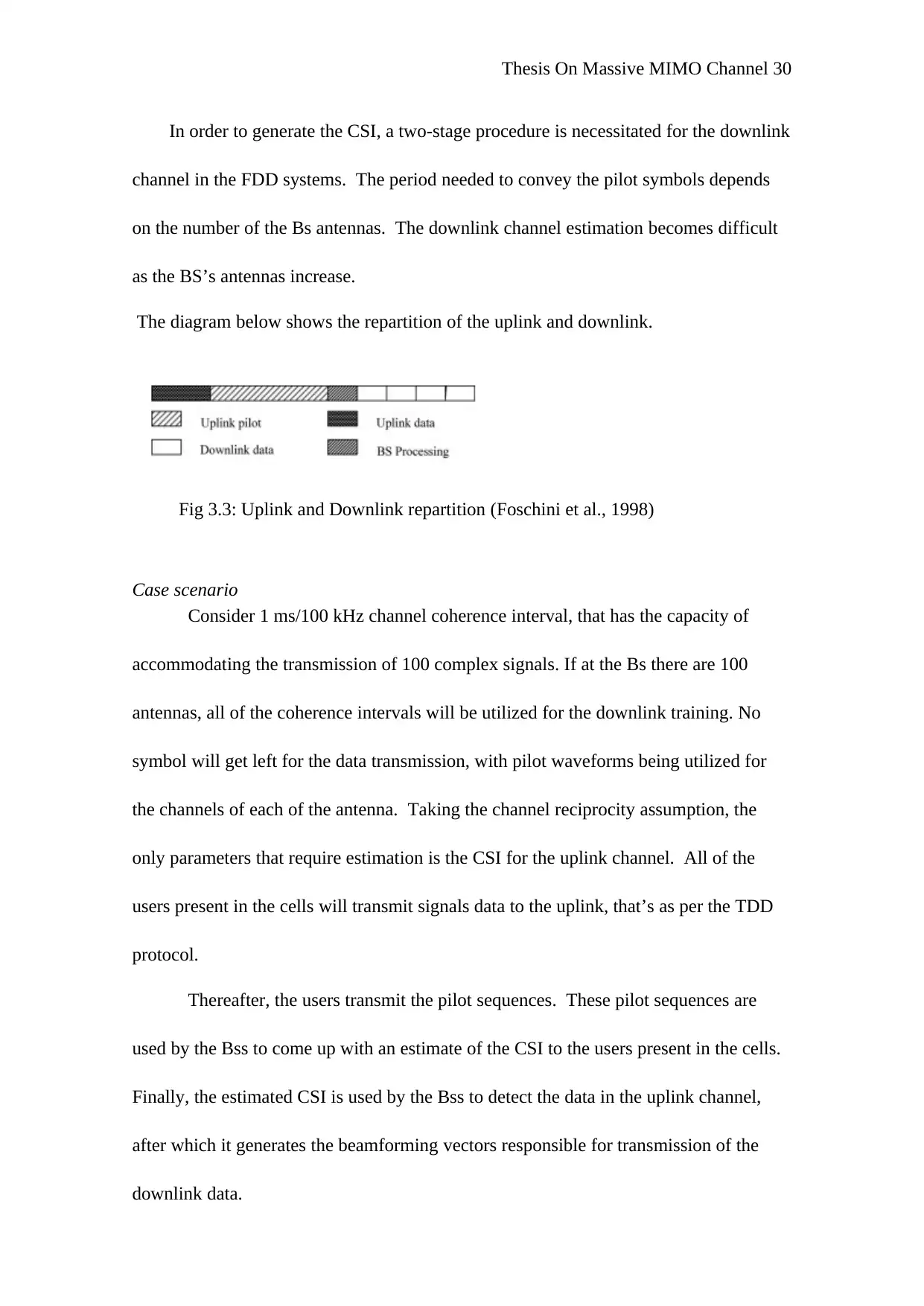
Thesis On Massive MIMO Channel 30
In order to generate the CSI, a two-stage procedure is necessitated for the downlink
channel in the FDD systems. The period needed to convey the pilot symbols depends
on the number of the Bs antennas. The downlink channel estimation becomes difficult
as the BS’s antennas increase.
The diagram below shows the repartition of the uplink and downlink.
Fig 3.3: Uplink and Downlink repartition (Foschini et al., 1998)
Case scenario
Consider 1 ms/100 kHz channel coherence interval, that has the capacity of
accommodating the transmission of 100 complex signals. If at the Bs there are 100
antennas, all of the coherence intervals will be utilized for the downlink training. No
symbol will get left for the data transmission, with pilot waveforms being utilized for
the channels of each of the antenna. Taking the channel reciprocity assumption, the
only parameters that require estimation is the CSI for the uplink channel. All of the
users present in the cells will transmit signals data to the uplink, that’s as per the TDD
protocol.
Thereafter, the users transmit the pilot sequences. These pilot sequences are
used by the Bss to come up with an estimate of the CSI to the users present in the cells.
Finally, the estimated CSI is used by the Bss to detect the data in the uplink channel,
after which it generates the beamforming vectors responsible for transmission of the
downlink data.
In order to generate the CSI, a two-stage procedure is necessitated for the downlink
channel in the FDD systems. The period needed to convey the pilot symbols depends
on the number of the Bs antennas. The downlink channel estimation becomes difficult
as the BS’s antennas increase.
The diagram below shows the repartition of the uplink and downlink.
Fig 3.3: Uplink and Downlink repartition (Foschini et al., 1998)
Case scenario
Consider 1 ms/100 kHz channel coherence interval, that has the capacity of
accommodating the transmission of 100 complex signals. If at the Bs there are 100
antennas, all of the coherence intervals will be utilized for the downlink training. No
symbol will get left for the data transmission, with pilot waveforms being utilized for
the channels of each of the antenna. Taking the channel reciprocity assumption, the
only parameters that require estimation is the CSI for the uplink channel. All of the
users present in the cells will transmit signals data to the uplink, that’s as per the TDD
protocol.
Thereafter, the users transmit the pilot sequences. These pilot sequences are
used by the Bss to come up with an estimate of the CSI to the users present in the cells.
Finally, the estimated CSI is used by the Bss to detect the data in the uplink channel,
after which it generates the beamforming vectors responsible for transmission of the
downlink data.
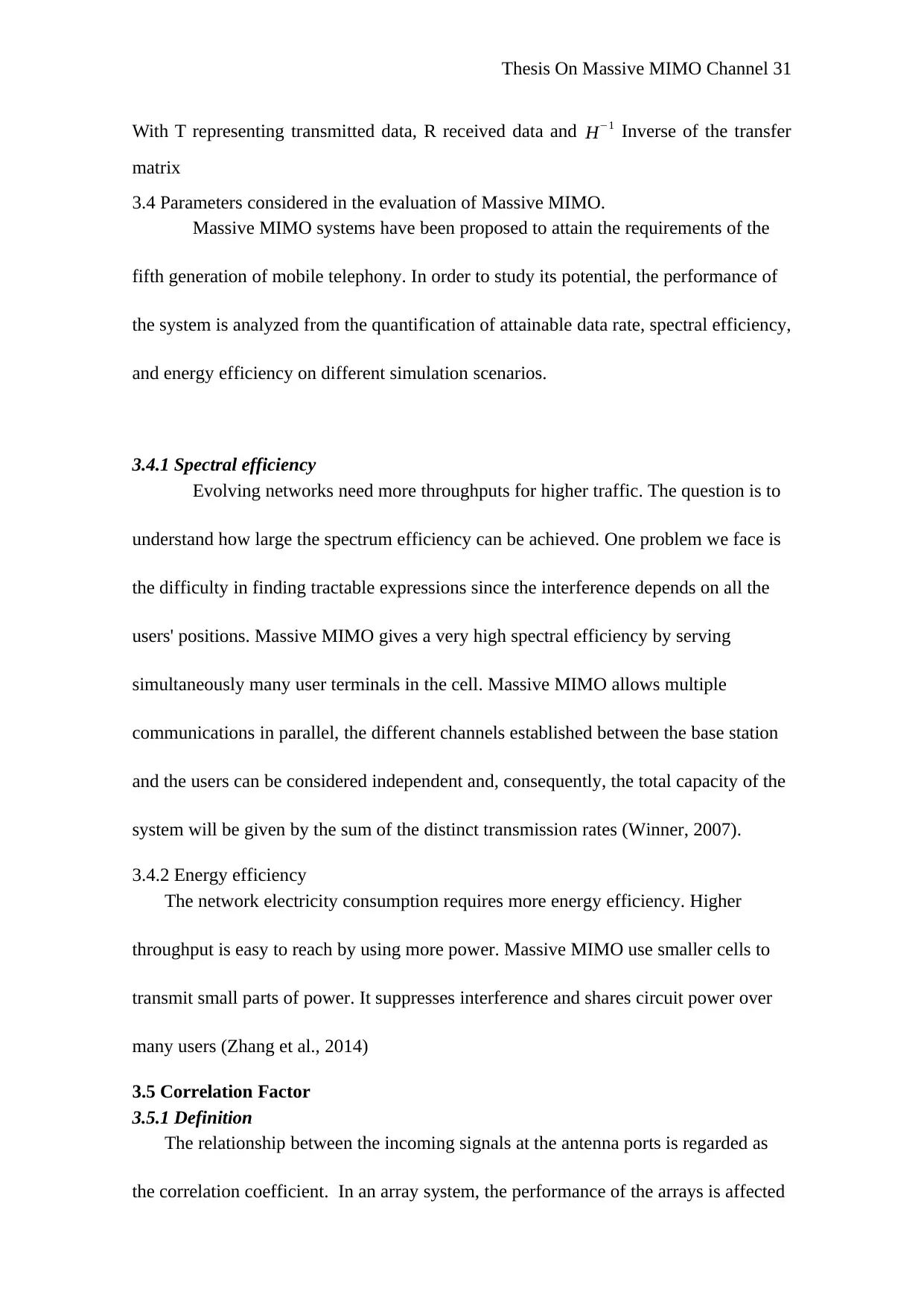
Thesis On Massive MIMO Channel 31
With T representing transmitted data, R received data and H−1 Inverse of the transfer
matrix
3.4 Parameters considered in the evaluation of Massive MIMO.
Massive MIMO systems have been proposed to attain the requirements of the
fifth generation of mobile telephony. In order to study its potential, the performance of
the system is analyzed from the quantification of attainable data rate, spectral efficiency,
and energy efficiency on different simulation scenarios.
3.4.1 Spectral efficiency
Evolving networks need more throughputs for higher traffic. The question is to
understand how large the spectrum efficiency can be achieved. One problem we face is
the difficulty in finding tractable expressions since the interference depends on all the
users' positions. Massive MIMO gives a very high spectral efficiency by serving
simultaneously many user terminals in the cell. Massive MIMO allows multiple
communications in parallel, the different channels established between the base station
and the users can be considered independent and, consequently, the total capacity of the
system will be given by the sum of the distinct transmission rates (Winner, 2007).
3.4.2 Energy efficiency
The network electricity consumption requires more energy efficiency. Higher
throughput is easy to reach by using more power. Massive MIMO use smaller cells to
transmit small parts of power. It suppresses interference and shares circuit power over
many users (Zhang et al., 2014)
3.5 Correlation Factor
3.5.1 Definition
The relationship between the incoming signals at the antenna ports is regarded as
the correlation coefficient. In an array system, the performance of the arrays is affected
With T representing transmitted data, R received data and H−1 Inverse of the transfer
matrix
3.4 Parameters considered in the evaluation of Massive MIMO.
Massive MIMO systems have been proposed to attain the requirements of the
fifth generation of mobile telephony. In order to study its potential, the performance of
the system is analyzed from the quantification of attainable data rate, spectral efficiency,
and energy efficiency on different simulation scenarios.
3.4.1 Spectral efficiency
Evolving networks need more throughputs for higher traffic. The question is to
understand how large the spectrum efficiency can be achieved. One problem we face is
the difficulty in finding tractable expressions since the interference depends on all the
users' positions. Massive MIMO gives a very high spectral efficiency by serving
simultaneously many user terminals in the cell. Massive MIMO allows multiple
communications in parallel, the different channels established between the base station
and the users can be considered independent and, consequently, the total capacity of the
system will be given by the sum of the distinct transmission rates (Winner, 2007).
3.4.2 Energy efficiency
The network electricity consumption requires more energy efficiency. Higher
throughput is easy to reach by using more power. Massive MIMO use smaller cells to
transmit small parts of power. It suppresses interference and shares circuit power over
many users (Zhang et al., 2014)
3.5 Correlation Factor
3.5.1 Definition
The relationship between the incoming signals at the antenna ports is regarded as
the correlation coefficient. In an array system, the performance of the arrays is affected
Paraphrase This Document
Need a fresh take? Get an instant paraphrase of this document with our AI Paraphraser
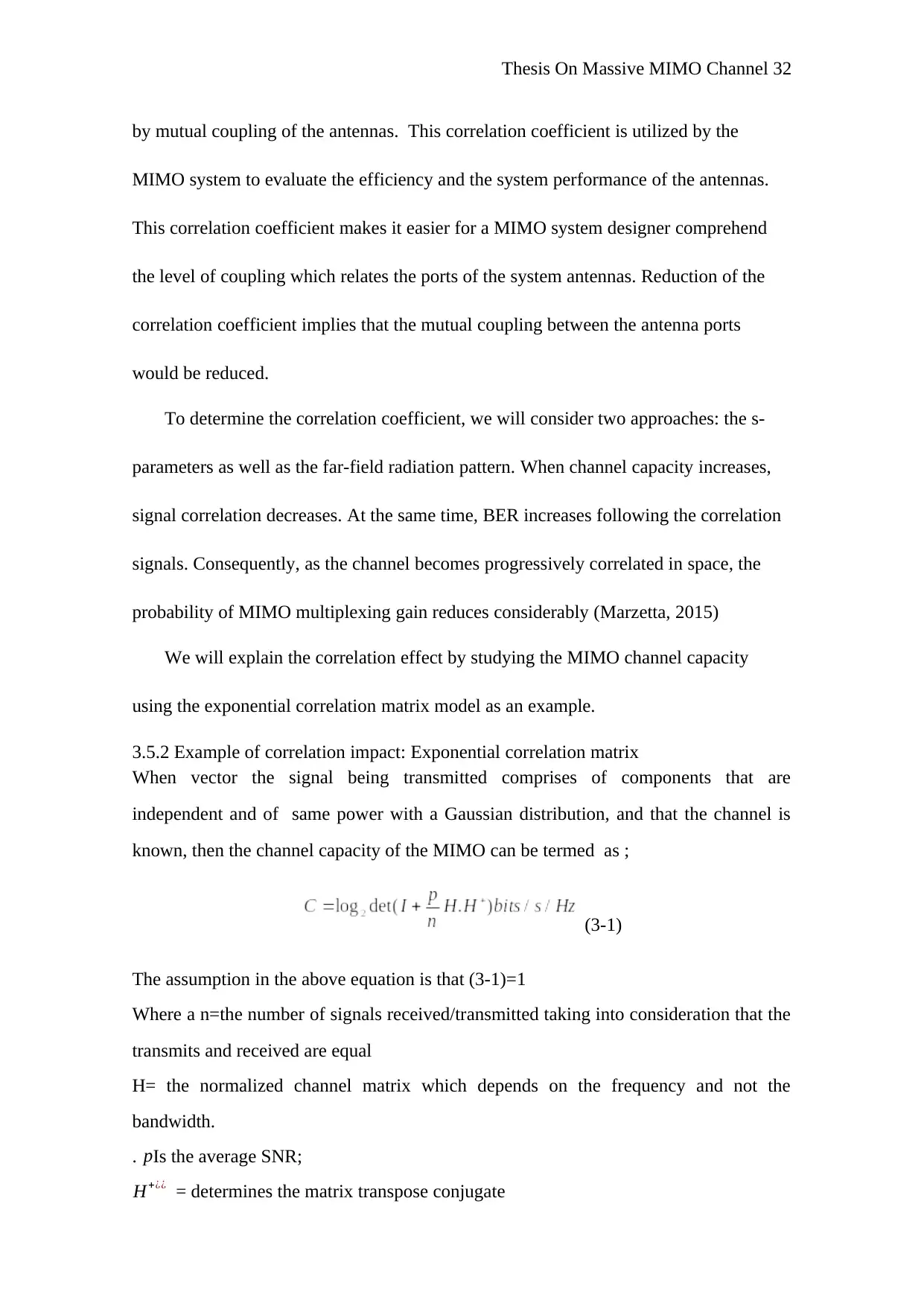
Thesis On Massive MIMO Channel 32
by mutual coupling of the antennas. This correlation coefficient is utilized by the
MIMO system to evaluate the efficiency and the system performance of the antennas.
This correlation coefficient makes it easier for a MIMO system designer comprehend
the level of coupling which relates the ports of the system antennas. Reduction of the
correlation coefficient implies that the mutual coupling between the antenna ports
would be reduced.
To determine the correlation coefficient, we will consider two approaches: the s-
parameters as well as the far-field radiation pattern. When channel capacity increases,
signal correlation decreases. At the same time, BER increases following the correlation
signals. Consequently, as the channel becomes progressively correlated in space, the
probability of MIMO multiplexing gain reduces considerably (Marzetta, 2015)
We will explain the correlation effect by studying the MIMO channel capacity
using the exponential correlation matrix model as an example.
3.5.2 Example of correlation impact: Exponential correlation matrix
When vector the signal being transmitted comprises of components that are
independent and of same power with a Gaussian distribution, and that the channel is
known, then the channel capacity of the MIMO can be termed as ;
(3-1)
The assumption in the above equation is that (3-1)=1
Where a n=the number of signals received/transmitted taking into consideration that the
transmits and received are equal
H= the normalized channel matrix which depends on the frequency and not the
bandwidth.
. pIs the average SNR;
H+¿¿ = determines the matrix transpose conjugate
by mutual coupling of the antennas. This correlation coefficient is utilized by the
MIMO system to evaluate the efficiency and the system performance of the antennas.
This correlation coefficient makes it easier for a MIMO system designer comprehend
the level of coupling which relates the ports of the system antennas. Reduction of the
correlation coefficient implies that the mutual coupling between the antenna ports
would be reduced.
To determine the correlation coefficient, we will consider two approaches: the s-
parameters as well as the far-field radiation pattern. When channel capacity increases,
signal correlation decreases. At the same time, BER increases following the correlation
signals. Consequently, as the channel becomes progressively correlated in space, the
probability of MIMO multiplexing gain reduces considerably (Marzetta, 2015)
We will explain the correlation effect by studying the MIMO channel capacity
using the exponential correlation matrix model as an example.
3.5.2 Example of correlation impact: Exponential correlation matrix
When vector the signal being transmitted comprises of components that are
independent and of same power with a Gaussian distribution, and that the channel is
known, then the channel capacity of the MIMO can be termed as ;
(3-1)
The assumption in the above equation is that (3-1)=1
Where a n=the number of signals received/transmitted taking into consideration that the
transmits and received are equal
H= the normalized channel matrix which depends on the frequency and not the
bandwidth.
. pIs the average SNR;
H+¿¿ = determines the matrix transpose conjugate
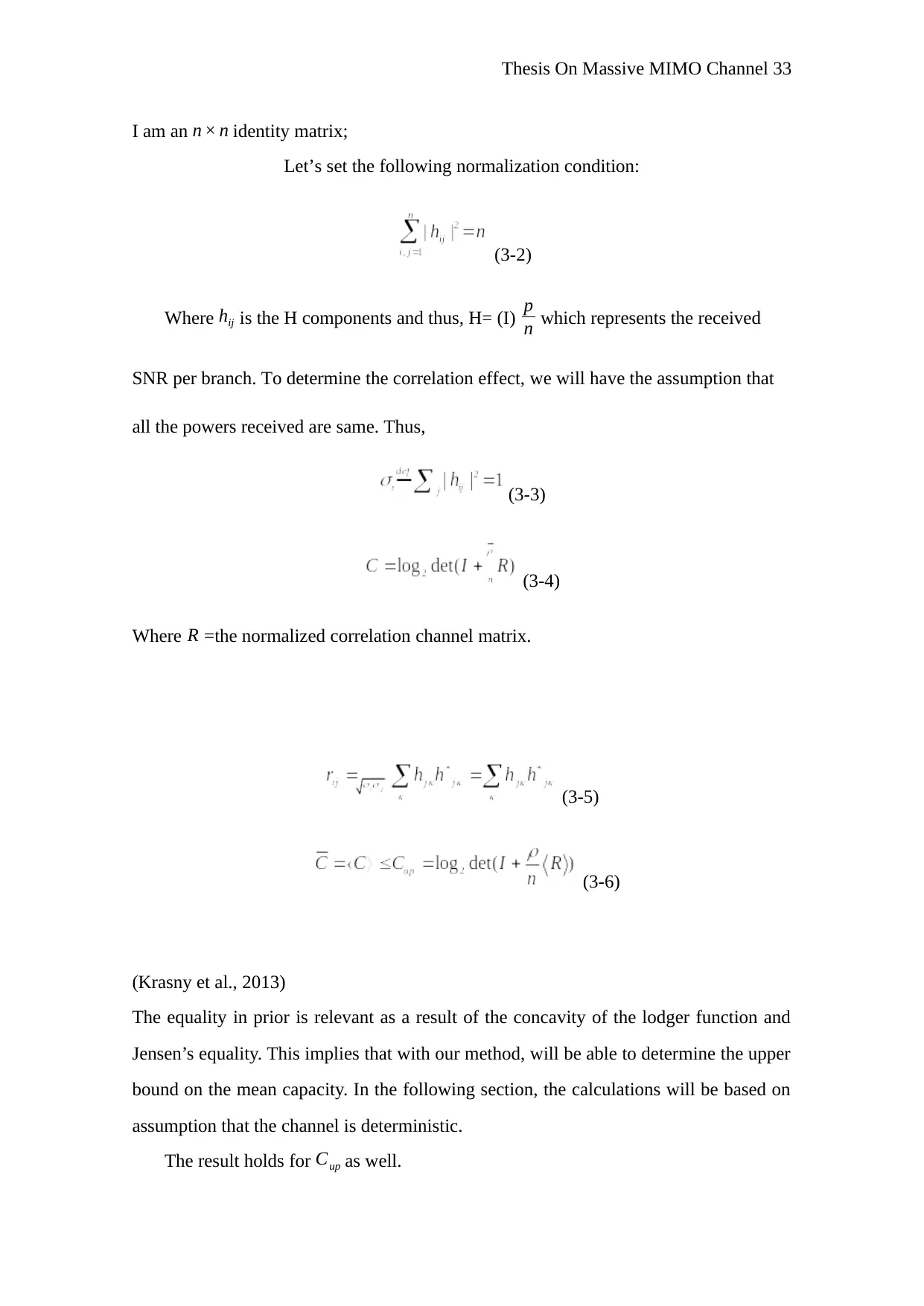
Thesis On Massive MIMO Channel 33
I am an n × n identity matrix;
Let’s set the following normalization condition:
(3-2)
Where hij is the H components and thus, H= (I) p
n which represents the received
SNR per branch. To determine the correlation effect, we will have the assumption that
all the powers received are same. Thus,
(3-3)
(3-4)
Where R =the normalized correlation channel matrix.
(3-5)
(3-6)
(Krasny et al., 2013)
The equality in prior is relevant as a result of the concavity of the lodger function and
Jensen’s equality. This implies that with our method, will be able to determine the upper
bound on the mean capacity. In the following section, the calculations will be based on
assumption that the channel is deterministic.
The result holds for Cup as well.
I am an n × n identity matrix;
Let’s set the following normalization condition:
(3-2)
Where hij is the H components and thus, H= (I) p
n which represents the received
SNR per branch. To determine the correlation effect, we will have the assumption that
all the powers received are same. Thus,
(3-3)
(3-4)
Where R =the normalized correlation channel matrix.
(3-5)
(3-6)
(Krasny et al., 2013)
The equality in prior is relevant as a result of the concavity of the lodger function and
Jensen’s equality. This implies that with our method, will be able to determine the upper
bound on the mean capacity. In the following section, the calculations will be based on
assumption that the channel is deterministic.
The result holds for Cup as well.
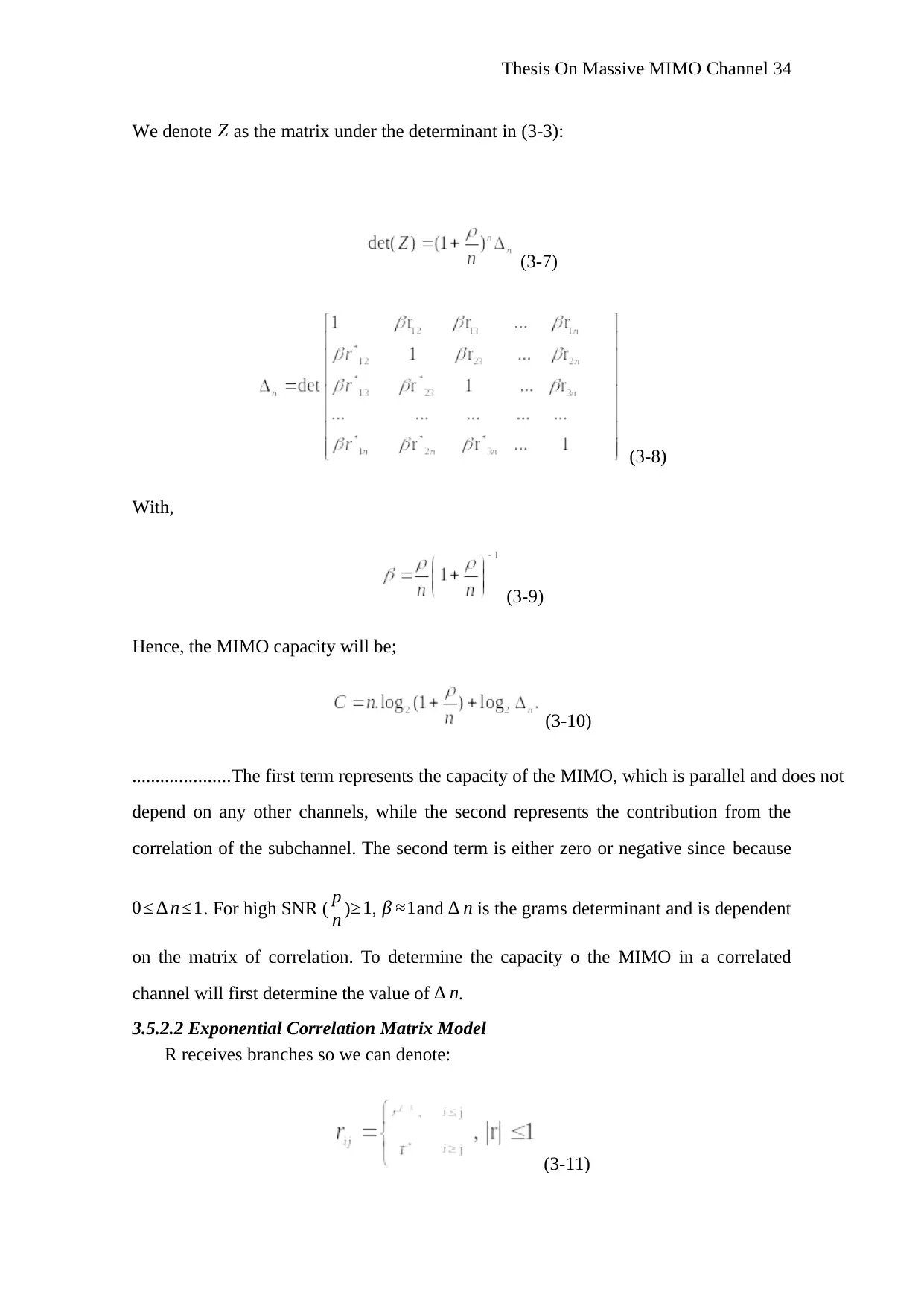
Thesis On Massive MIMO Channel 34
We denote Z as the matrix under the determinant in (3-3):
(3-7)
(3-8)
With,
(3-9)
Hence, the MIMO capacity will be;
(3-10)
.....................The first term represents the capacity of the MIMO, which is parallel and does not
depend on any other channels, while the second represents the contribution from the
correlation of the subchannel. The second term is either zero or negative since because
0 ≤ ∆ n ≤1. For high SNR ( p
n )≥ 1, β ≈1and ∆ n is the grams determinant and is dependent
on the matrix of correlation. To determine the capacity o the MIMO in a correlated
channel will first determine the value of ∆ n.
3.5.2.2 Exponential Correlation Matrix Model
R receives branches so we can denote:
(3-11)
We denote Z as the matrix under the determinant in (3-3):
(3-7)
(3-8)
With,
(3-9)
Hence, the MIMO capacity will be;
(3-10)
.....................The first term represents the capacity of the MIMO, which is parallel and does not
depend on any other channels, while the second represents the contribution from the
correlation of the subchannel. The second term is either zero or negative since because
0 ≤ ∆ n ≤1. For high SNR ( p
n )≥ 1, β ≈1and ∆ n is the grams determinant and is dependent
on the matrix of correlation. To determine the capacity o the MIMO in a correlated
channel will first determine the value of ∆ n.
3.5.2.2 Exponential Correlation Matrix Model
R receives branches so we can denote:
(3-11)
Secure Best Marks with AI Grader
Need help grading? Try our AI Grader for instant feedback on your assignments.
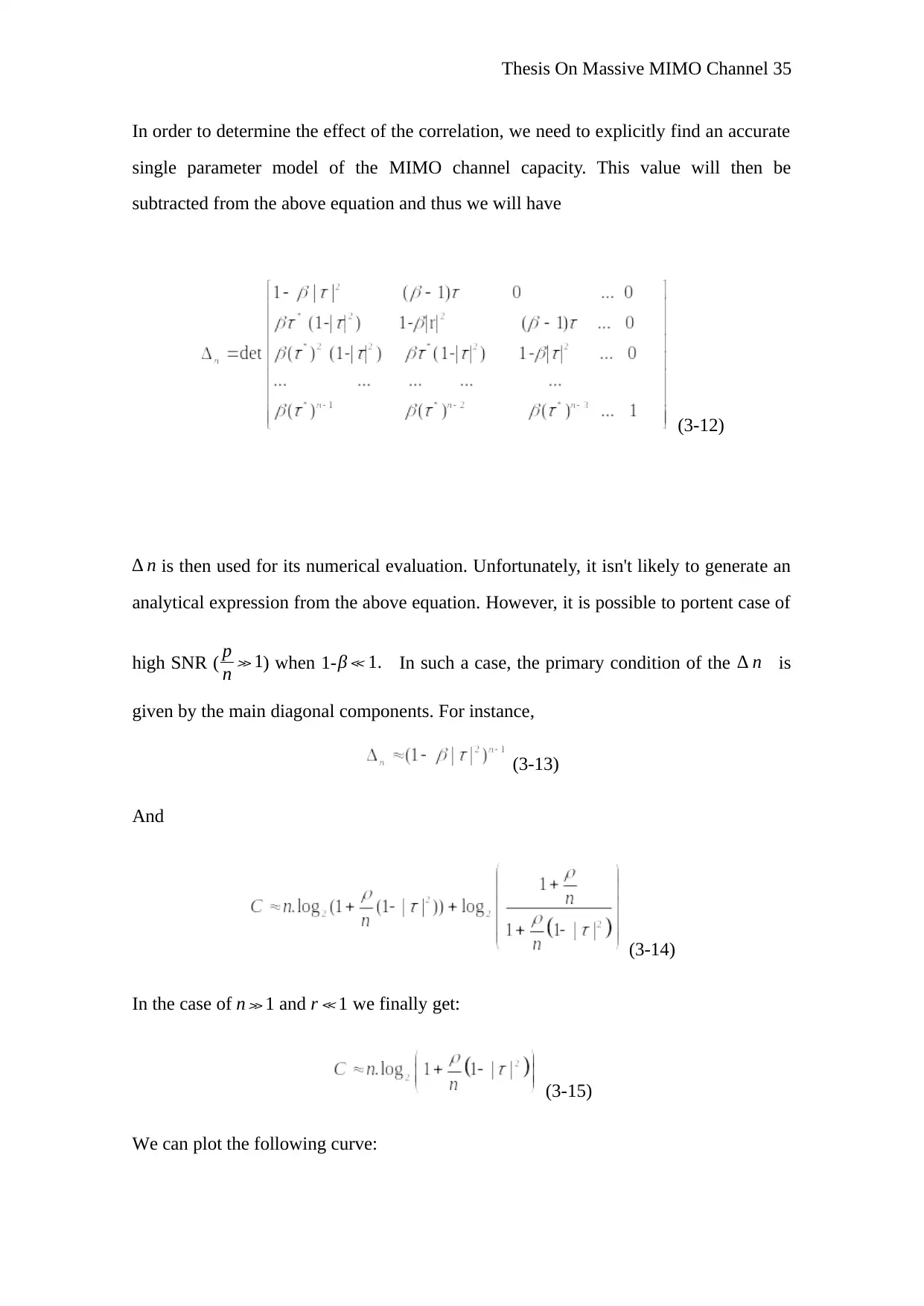
Thesis On Massive MIMO Channel 35
In order to determine the effect of the correlation, we need to explicitly find an accurate
single parameter model of the MIMO channel capacity. This value will then be
subtracted from the above equation and thus we will have
(3-12)
∆ n is then used for its numerical evaluation. Unfortunately, it isn't likely to generate an
analytical expression from the above equation. However, it is possible to portent case of
high SNR ( p
n ≫ 1) when 1-β ≪ 1. In such a case, the primary condition of the ∆ n is
given by the main diagonal components. For instance,
(3-13)
And
(3-14)
In the case of n ≫ 1 and r ≪ 1 we finally get:
(3-15)
We can plot the following curve:
In order to determine the effect of the correlation, we need to explicitly find an accurate
single parameter model of the MIMO channel capacity. This value will then be
subtracted from the above equation and thus we will have
(3-12)
∆ n is then used for its numerical evaluation. Unfortunately, it isn't likely to generate an
analytical expression from the above equation. However, it is possible to portent case of
high SNR ( p
n ≫ 1) when 1-β ≪ 1. In such a case, the primary condition of the ∆ n is
given by the main diagonal components. For instance,
(3-13)
And
(3-14)
In the case of n ≫ 1 and r ≪ 1 we finally get:
(3-15)
We can plot the following curve:
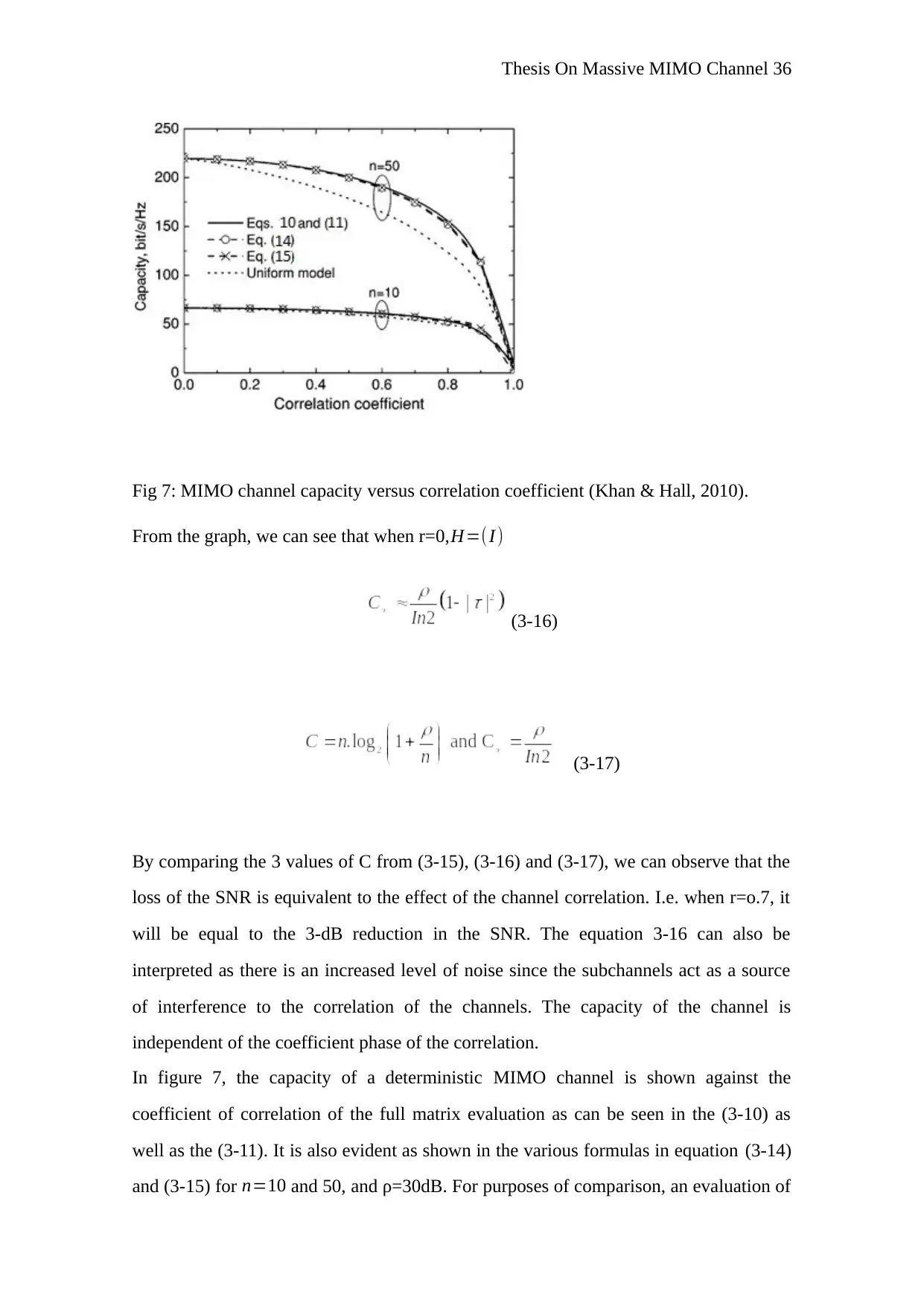
Thesis On Massive MIMO Channel 36
Fig 7: MIMO channel capacity versus correlation coefficient (Khan & Hall, 2010).
From the graph, we can see that when r=0,H=(I )
(3-16)
(3-17)
By comparing the 3 values of C from (3-15), (3-16) and (3-17), we can observe that the
loss of the SNR is equivalent to the effect of the channel correlation. I.e. when r=o.7, it
will be equal to the 3-dB reduction in the SNR. The equation 3-16 can also be
interpreted as there is an increased level of noise since the subchannels act as a source
of interference to the correlation of the channels. The capacity of the channel is
independent of the coefficient phase of the correlation.
In figure 7, the capacity of a deterministic MIMO channel is shown against the
coefficient of correlation of the full matrix evaluation as can be seen in the (3-10) as
well as the (3-11). It is also evident as shown in the various formulas in equation (3-14)
and (3-15) for n=10 and 50, and ρ=30dB. For purposes of comparison, an evaluation of
Fig 7: MIMO channel capacity versus correlation coefficient (Khan & Hall, 2010).
From the graph, we can see that when r=0,H=(I )
(3-16)
(3-17)
By comparing the 3 values of C from (3-15), (3-16) and (3-17), we can observe that the
loss of the SNR is equivalent to the effect of the channel correlation. I.e. when r=o.7, it
will be equal to the 3-dB reduction in the SNR. The equation 3-16 can also be
interpreted as there is an increased level of noise since the subchannels act as a source
of interference to the correlation of the channels. The capacity of the channel is
independent of the coefficient phase of the correlation.
In figure 7, the capacity of a deterministic MIMO channel is shown against the
coefficient of correlation of the full matrix evaluation as can be seen in the (3-10) as
well as the (3-11). It is also evident as shown in the various formulas in equation (3-14)
and (3-15) for n=10 and 50, and ρ=30dB. For purposes of comparison, an evaluation of
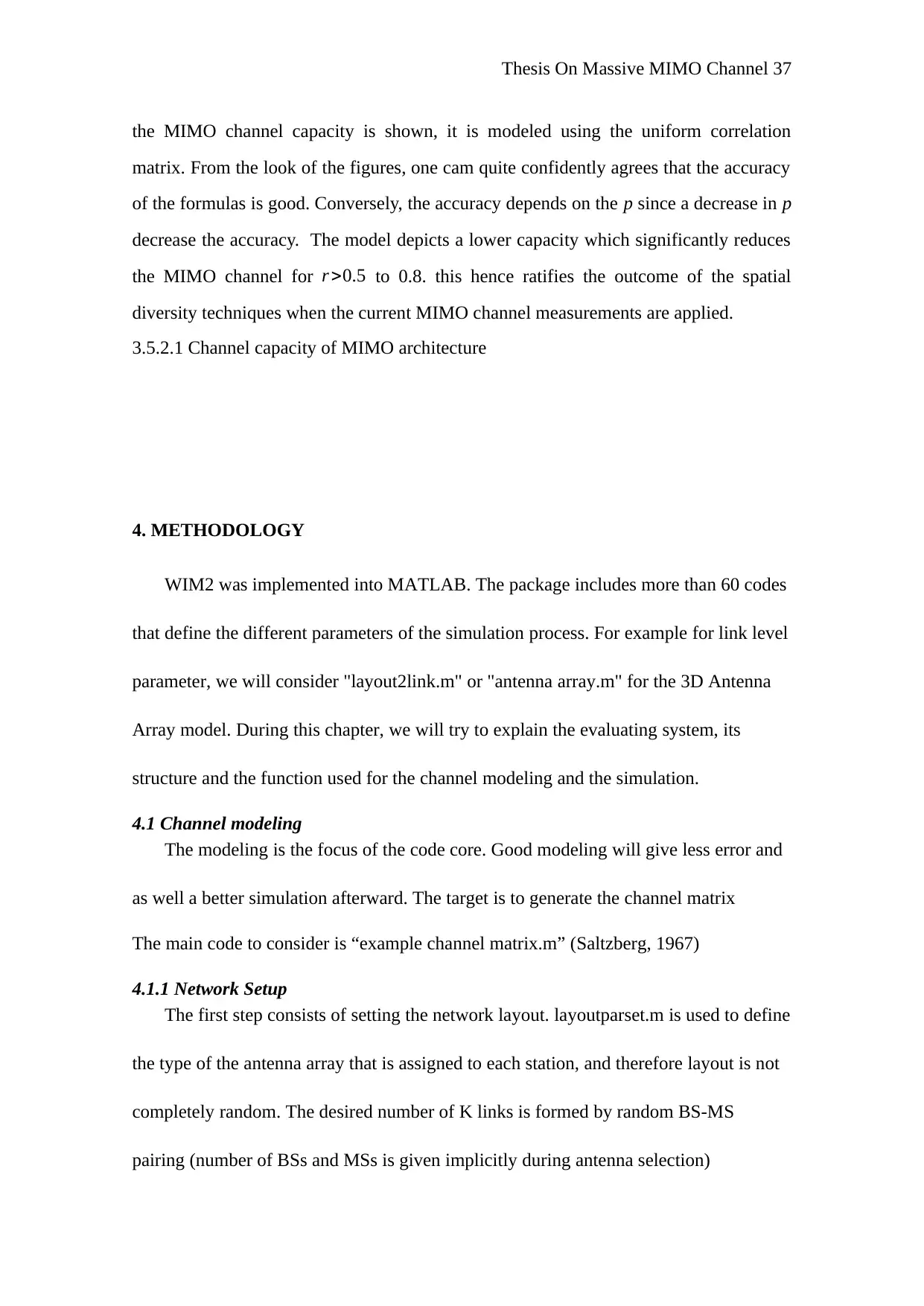
Thesis On Massive MIMO Channel 37
the MIMO channel capacity is shown, it is modeled using the uniform correlation
matrix. From the look of the figures, one cam quite confidently agrees that the accuracy
of the formulas is good. Conversely, the accuracy depends on the p since a decrease in p
decrease the accuracy. The model depicts a lower capacity which significantly reduces
the MIMO channel for r >0.5 to 0.8. this hence ratifies the outcome of the spatial
diversity techniques when the current MIMO channel measurements are applied.
3.5.2.1 Channel capacity of MIMO architecture
4. METHODOLOGY
WIM2 was implemented into MATLAB. The package includes more than 60 codes
that define the different parameters of the simulation process. For example for link level
parameter, we will consider "layout2link.m" or "antenna array.m" for the 3D Antenna
Array model. During this chapter, we will try to explain the evaluating system, its
structure and the function used for the channel modeling and the simulation.
4.1 Channel modeling
The modeling is the focus of the code core. Good modeling will give less error and
as well a better simulation afterward. The target is to generate the channel matrix
The main code to consider is “example channel matrix.m” (Saltzberg, 1967)
4.1.1 Network Setup
The first step consists of setting the network layout. layoutparset.m is used to define
the type of the antenna array that is assigned to each station, and therefore layout is not
completely random. The desired number of K links is formed by random BS-MS
pairing (number of BSs and MSs is given implicitly during antenna selection)
the MIMO channel capacity is shown, it is modeled using the uniform correlation
matrix. From the look of the figures, one cam quite confidently agrees that the accuracy
of the formulas is good. Conversely, the accuracy depends on the p since a decrease in p
decrease the accuracy. The model depicts a lower capacity which significantly reduces
the MIMO channel for r >0.5 to 0.8. this hence ratifies the outcome of the spatial
diversity techniques when the current MIMO channel measurements are applied.
3.5.2.1 Channel capacity of MIMO architecture
4. METHODOLOGY
WIM2 was implemented into MATLAB. The package includes more than 60 codes
that define the different parameters of the simulation process. For example for link level
parameter, we will consider "layout2link.m" or "antenna array.m" for the 3D Antenna
Array model. During this chapter, we will try to explain the evaluating system, its
structure and the function used for the channel modeling and the simulation.
4.1 Channel modeling
The modeling is the focus of the code core. Good modeling will give less error and
as well a better simulation afterward. The target is to generate the channel matrix
The main code to consider is “example channel matrix.m” (Saltzberg, 1967)
4.1.1 Network Setup
The first step consists of setting the network layout. layoutparset.m is used to define
the type of the antenna array that is assigned to each station, and therefore layout is not
completely random. The desired number of K links is formed by random BS-MS
pairing (number of BSs and MSs is given implicitly during antenna selection)
Paraphrase This Document
Need a fresh take? Get an instant paraphrase of this document with our AI Paraphraser
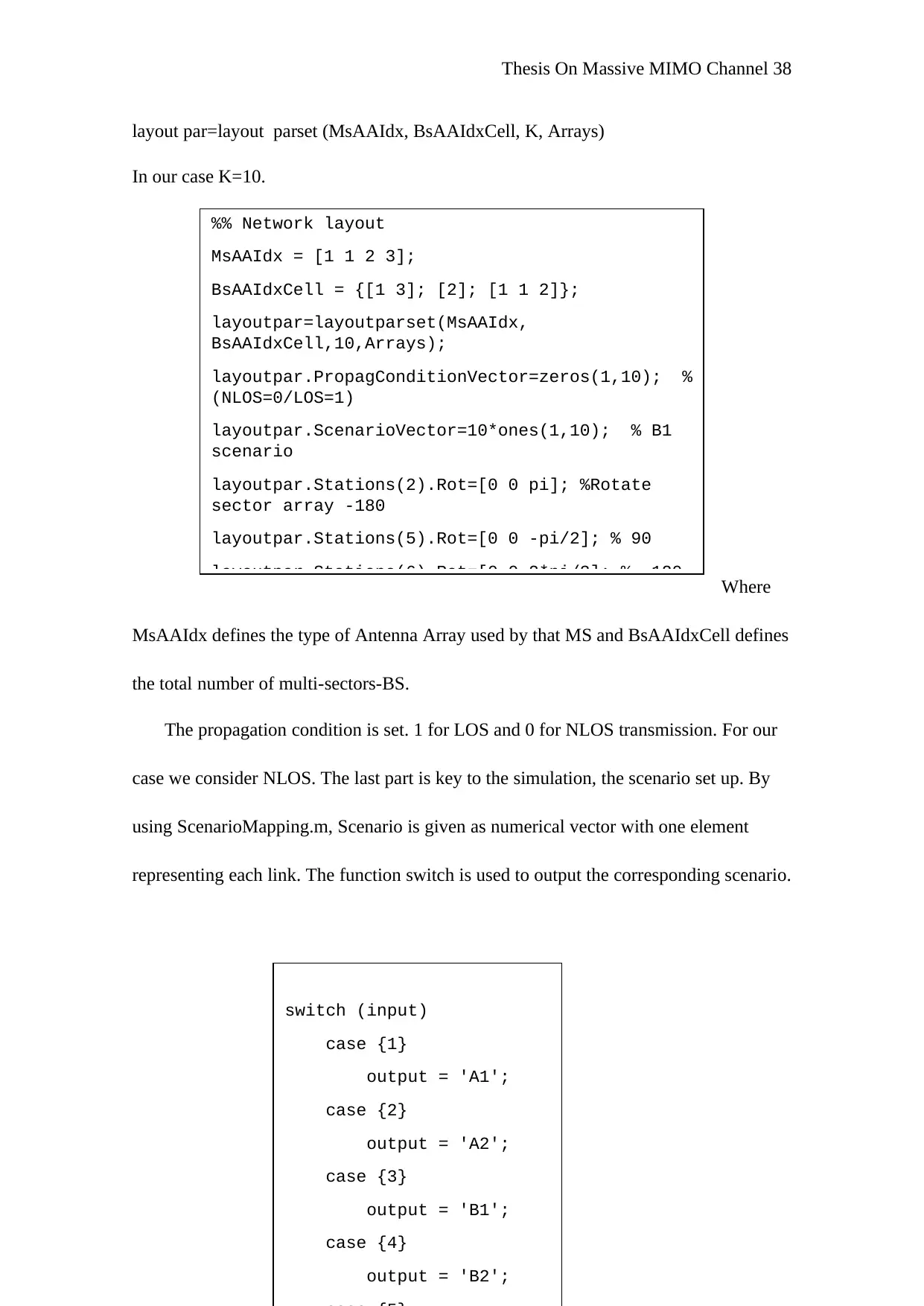
Thesis On Massive MIMO Channel 38
layout par=layout parset (MsAAIdx, BsAAIdxCell, K, Arrays)
In our case K=10.
Where
MsAAIdx defines the type of Antenna Array used by that MS and BsAAIdxCell defines
the total number of multi-sectors-BS.
The propagation condition is set. 1 for LOS and 0 for NLOS transmission. For our
case we consider NLOS. The last part is key to the simulation, the scenario set up. By
using ScenarioMapping.m, Scenario is given as numerical vector with one element
representing each link. The function switch is used to output the corresponding scenario.
%% Network layout
MsAAIdx = [1 1 2 3];
BsAAIdxCell = {[1 3]; [2]; [1 1 2]};
layoutpar=layoutparset(MsAAIdx,
BsAAIdxCell,10,Arrays);
layoutpar.PropagConditionVector=zeros(1,10); %
(NLOS=0/LOS=1)
layoutpar.ScenarioVector=10*ones(1,10); % B1
scenario
layoutpar.Stations(2).Rot=[0 0 pi]; %Rotate
sector array -180
layoutpar.Stations(5).Rot=[0 0 -pi/2]; % 90
layoutpar.Stations(6).Rot=[0 0 2*pi/3]; % -120
switch (input)
case {1}
output = 'A1';
case {2}
output = 'A2';
case {3}
output = 'B1';
case {4}
output = 'B2';
layout par=layout parset (MsAAIdx, BsAAIdxCell, K, Arrays)
In our case K=10.
Where
MsAAIdx defines the type of Antenna Array used by that MS and BsAAIdxCell defines
the total number of multi-sectors-BS.
The propagation condition is set. 1 for LOS and 0 for NLOS transmission. For our
case we consider NLOS. The last part is key to the simulation, the scenario set up. By
using ScenarioMapping.m, Scenario is given as numerical vector with one element
representing each link. The function switch is used to output the corresponding scenario.
%% Network layout
MsAAIdx = [1 1 2 3];
BsAAIdxCell = {[1 3]; [2]; [1 1 2]};
layoutpar=layoutparset(MsAAIdx,
BsAAIdxCell,10,Arrays);
layoutpar.PropagConditionVector=zeros(1,10); %
(NLOS=0/LOS=1)
layoutpar.ScenarioVector=10*ones(1,10); % B1
scenario
layoutpar.Stations(2).Rot=[0 0 pi]; %Rotate
sector array -180
layoutpar.Stations(5).Rot=[0 0 -pi/2]; % 90
layoutpar.Stations(6).Rot=[0 0 2*pi/3]; % -120
switch (input)
case {1}
output = 'A1';
case {2}
output = 'A2';
case {3}
output = 'B1';
case {4}
output = 'B2';
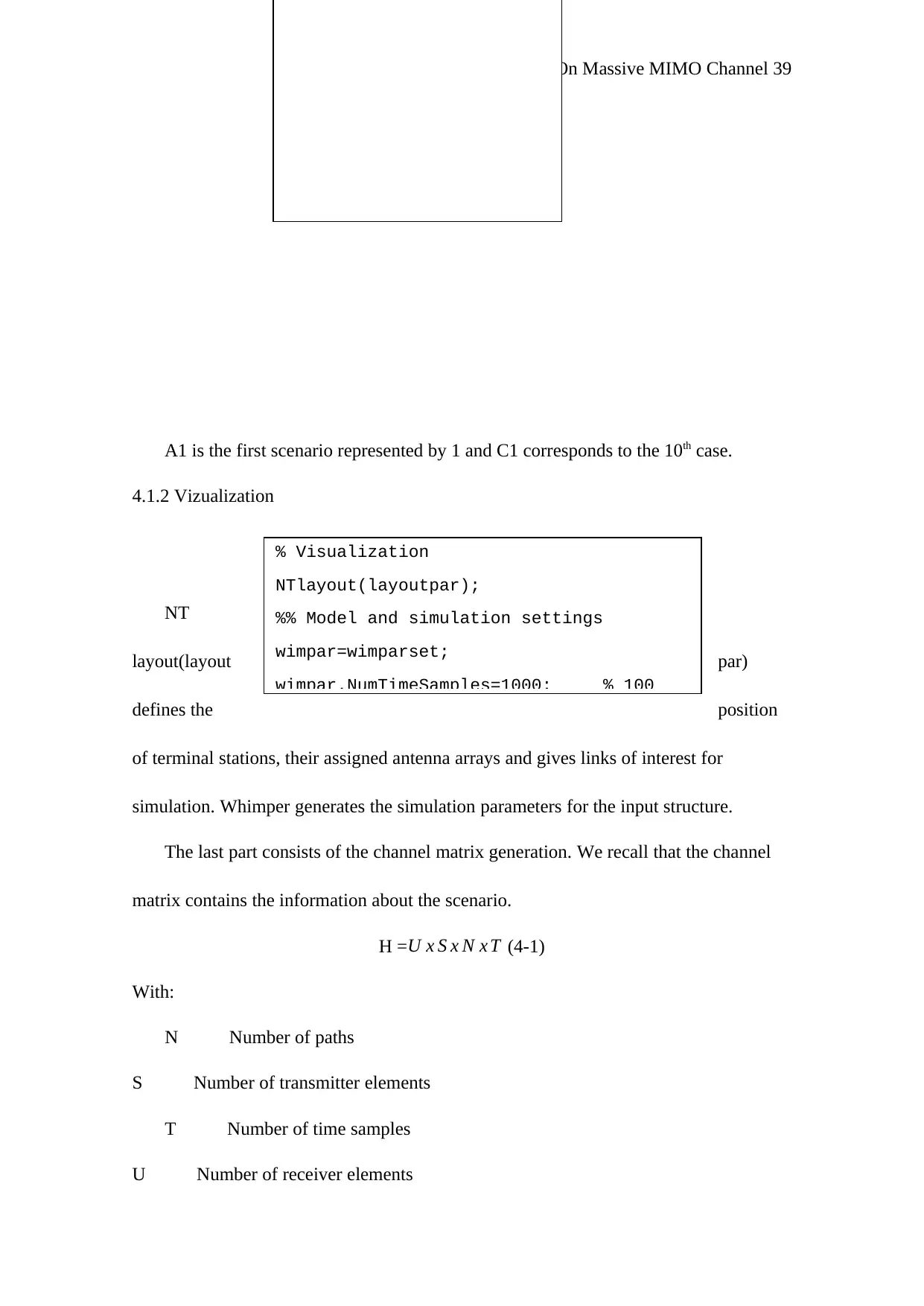
Thesis On Massive MIMO Channel 39
A1 is the first scenario represented by 1 and C1 corresponds to the 10th case.
4.1.2 Vizualization
NT
layout(layout par)
defines the position
of terminal stations, their assigned antenna arrays and gives links of interest for
simulation. Whimper generates the simulation parameters for the input structure.
The last part consists of the channel matrix generation. We recall that the channel
matrix contains the information about the scenario.
H =U x S x N x T (4-1)
With:
N Number of paths
S Number of transmitter elements
T Number of time samples
U Number of receiver elements
% Visualization
NTlayout(layoutpar);
%% Model and simulation settings
wimpar=wimparset;
wimpar.NumTimeSamples=1000; % 100
A1 is the first scenario represented by 1 and C1 corresponds to the 10th case.
4.1.2 Vizualization
NT
layout(layout par)
defines the position
of terminal stations, their assigned antenna arrays and gives links of interest for
simulation. Whimper generates the simulation parameters for the input structure.
The last part consists of the channel matrix generation. We recall that the channel
matrix contains the information about the scenario.
H =U x S x N x T (4-1)
With:
N Number of paths
S Number of transmitter elements
T Number of time samples
U Number of receiver elements
% Visualization
NTlayout(layoutpar);
%% Model and simulation settings
wimpar=wimparset;
wimpar.NumTimeSamples=1000; % 100
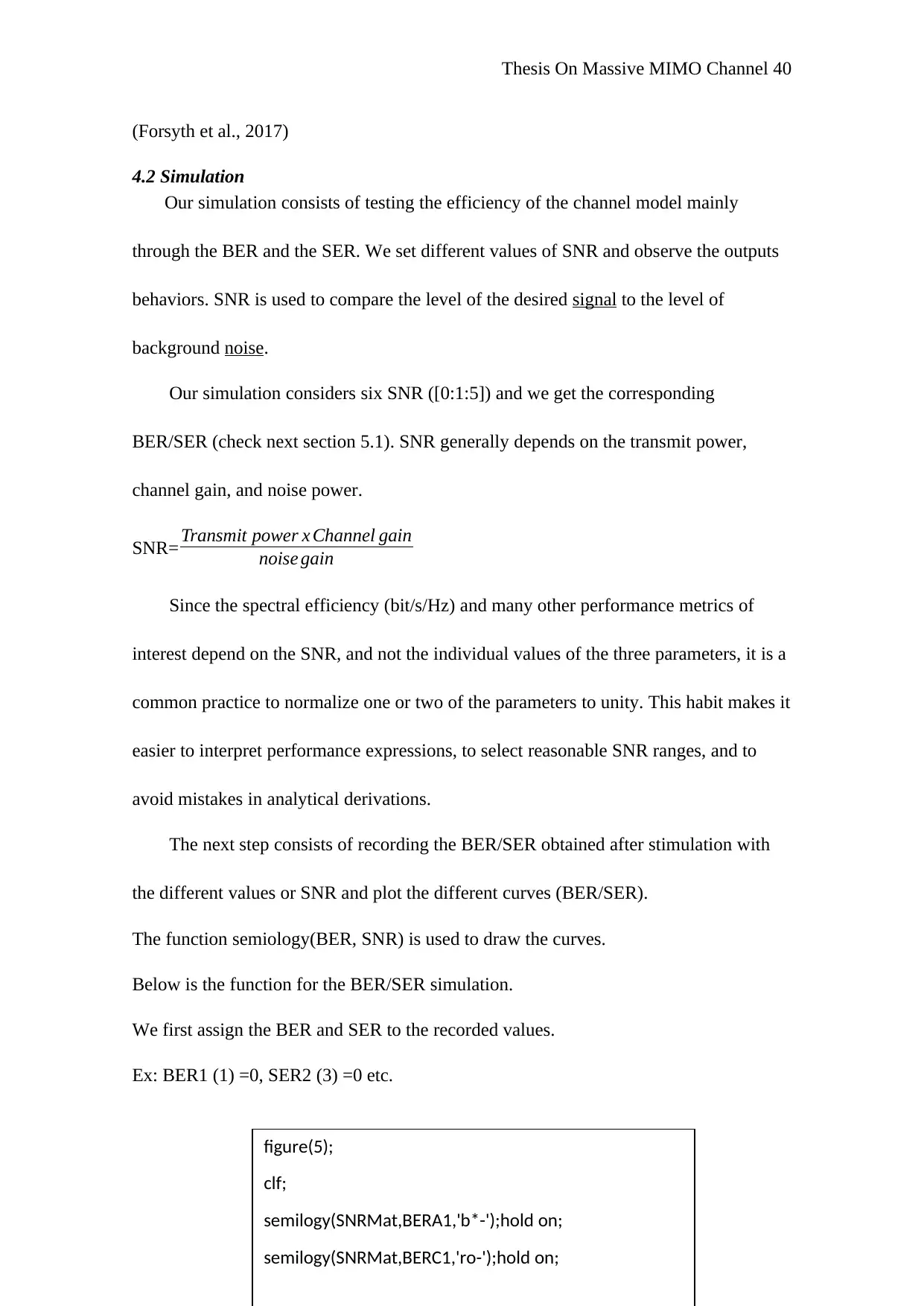
Thesis On Massive MIMO Channel 40
(Forsyth et al., 2017)
4.2 Simulation
Our simulation consists of testing the efficiency of the channel model mainly
through the BER and the SER. We set different values of SNR and observe the outputs
behaviors. SNR is used to compare the level of the desired signal to the level of
background noise.
Our simulation considers six SNR ([0:1:5]) and we get the corresponding
BER/SER (check next section 5.1). SNR generally depends on the transmit power,
channel gain, and noise power.
SNR= Transmit power x Channel gain
noise gain
Since the spectral efficiency (bit/s/Hz) and many other performance metrics of
interest depend on the SNR, and not the individual values of the three parameters, it is a
common practice to normalize one or two of the parameters to unity. This habit makes it
easier to interpret performance expressions, to select reasonable SNR ranges, and to
avoid mistakes in analytical derivations.
The next step consists of recording the BER/SER obtained after stimulation with
the different values or SNR and plot the different curves (BER/SER).
The function semiology(BER, SNR) is used to draw the curves.
Below is the function for the BER/SER simulation.
We first assign the BER and SER to the recorded values.
Ex: BER1 (1) =0, SER2 (3) =0 etc.
figure(5);
clf;
semilogy(SNRMat,BERA1,'b*-');hold on;
semilogy(SNRMat,BERC1,'ro-');hold on;
(Forsyth et al., 2017)
4.2 Simulation
Our simulation consists of testing the efficiency of the channel model mainly
through the BER and the SER. We set different values of SNR and observe the outputs
behaviors. SNR is used to compare the level of the desired signal to the level of
background noise.
Our simulation considers six SNR ([0:1:5]) and we get the corresponding
BER/SER (check next section 5.1). SNR generally depends on the transmit power,
channel gain, and noise power.
SNR= Transmit power x Channel gain
noise gain
Since the spectral efficiency (bit/s/Hz) and many other performance metrics of
interest depend on the SNR, and not the individual values of the three parameters, it is a
common practice to normalize one or two of the parameters to unity. This habit makes it
easier to interpret performance expressions, to select reasonable SNR ranges, and to
avoid mistakes in analytical derivations.
The next step consists of recording the BER/SER obtained after stimulation with
the different values or SNR and plot the different curves (BER/SER).
The function semiology(BER, SNR) is used to draw the curves.
Below is the function for the BER/SER simulation.
We first assign the BER and SER to the recorded values.
Ex: BER1 (1) =0, SER2 (3) =0 etc.
figure(5);
clf;
semilogy(SNRMat,BERA1,'b*-');hold on;
semilogy(SNRMat,BERC1,'ro-');hold on;
Secure Best Marks with AI Grader
Need help grading? Try our AI Grader for instant feedback on your assignments.
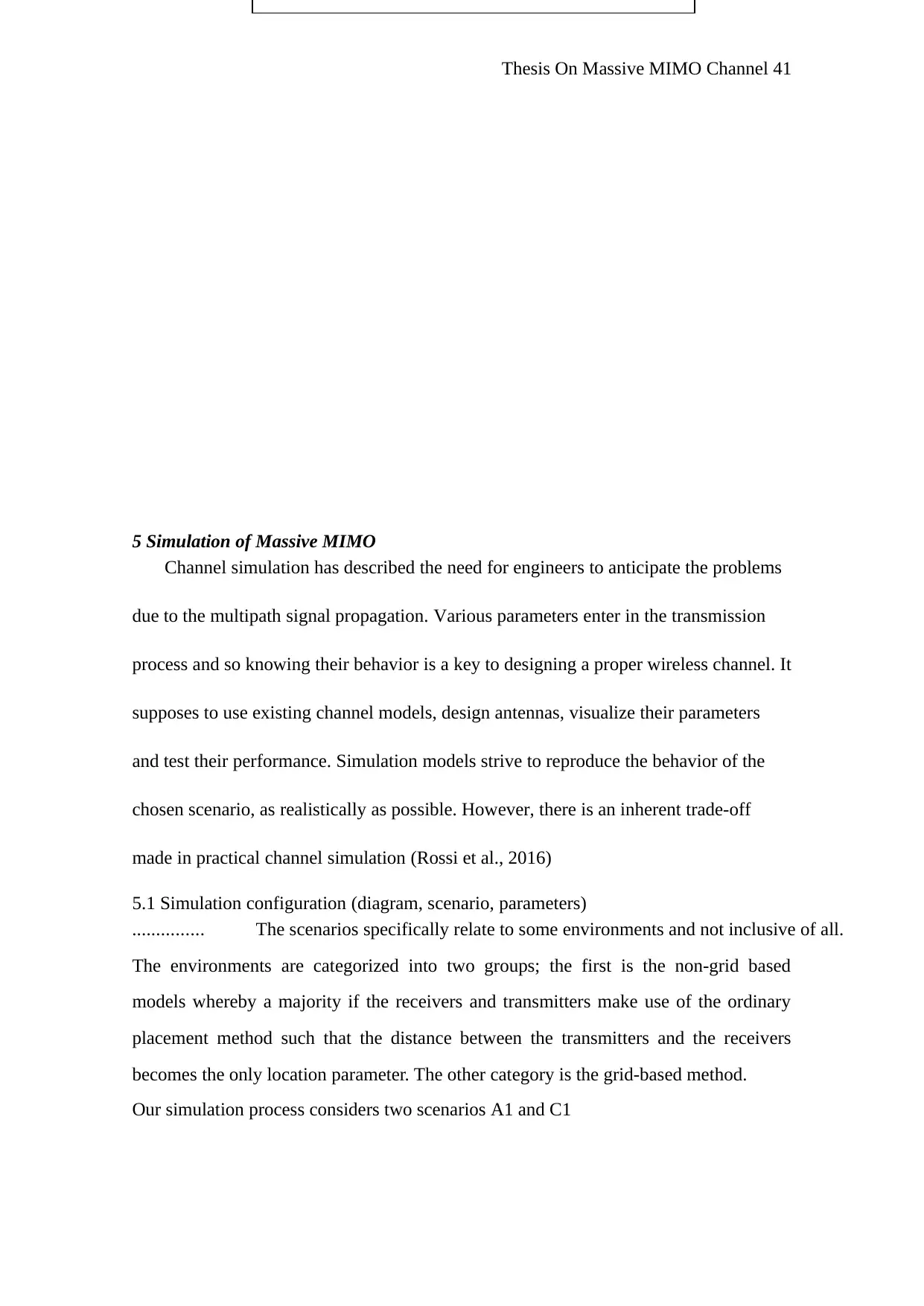
Thesis On Massive MIMO Channel 41
5 Simulation of Massive MIMO
Channel simulation has described the need for engineers to anticipate the problems
due to the multipath signal propagation. Various parameters enter in the transmission
process and so knowing their behavior is a key to designing a proper wireless channel. It
supposes to use existing channel models, design antennas, visualize their parameters
and test their performance. Simulation models strive to reproduce the behavior of the
chosen scenario, as realistically as possible. However, there is an inherent trade-off
made in practical channel simulation (Rossi et al., 2016)
5.1 Simulation configuration (diagram, scenario, parameters)
............... The scenarios specifically relate to some environments and not inclusive of all.
The environments are categorized into two groups; the first is the non-grid based
models whereby a majority if the receivers and transmitters make use of the ordinary
placement method such that the distance between the transmitters and the receivers
becomes the only location parameter. The other category is the grid-based method.
Our simulation process considers two scenarios A1 and C1
legend('A1','C1');
5 Simulation of Massive MIMO
Channel simulation has described the need for engineers to anticipate the problems
due to the multipath signal propagation. Various parameters enter in the transmission
process and so knowing their behavior is a key to designing a proper wireless channel. It
supposes to use existing channel models, design antennas, visualize their parameters
and test their performance. Simulation models strive to reproduce the behavior of the
chosen scenario, as realistically as possible. However, there is an inherent trade-off
made in practical channel simulation (Rossi et al., 2016)
5.1 Simulation configuration (diagram, scenario, parameters)
............... The scenarios specifically relate to some environments and not inclusive of all.
The environments are categorized into two groups; the first is the non-grid based
models whereby a majority if the receivers and transmitters make use of the ordinary
placement method such that the distance between the transmitters and the receivers
becomes the only location parameter. The other category is the grid-based method.
Our simulation process considers two scenarios A1 and C1
legend('A1','C1');
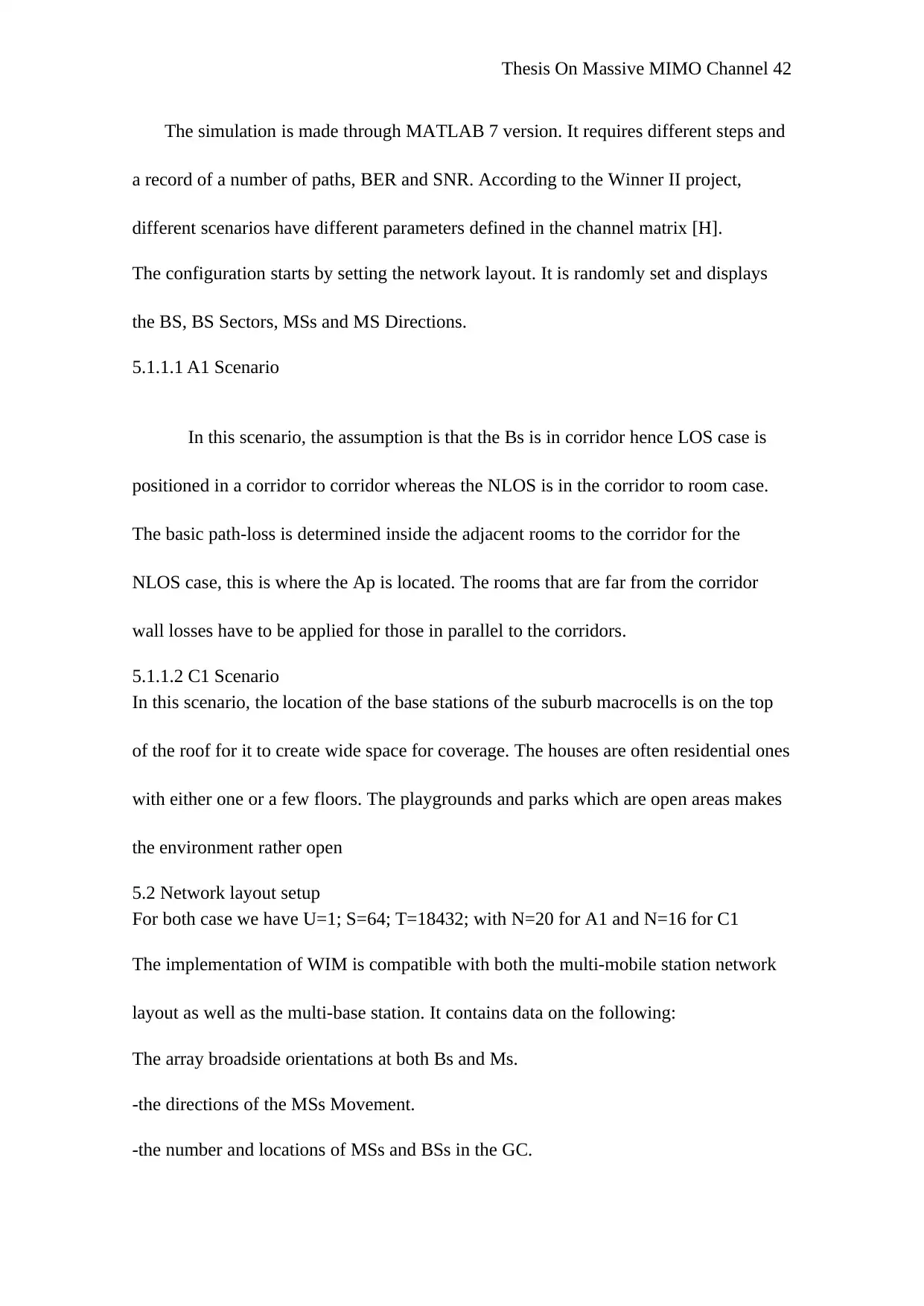
Thesis On Massive MIMO Channel 42
The simulation is made through MATLAB 7 version. It requires different steps and
a record of a number of paths, BER and SNR. According to the Winner II project,
different scenarios have different parameters defined in the channel matrix [H].
The configuration starts by setting the network layout. It is randomly set and displays
the BS, BS Sectors, MSs and MS Directions.
5.1.1.1 A1 Scenario
In this scenario, the assumption is that the Bs is in corridor hence LOS case is
positioned in a corridor to corridor whereas the NLOS is in the corridor to room case.
The basic path-loss is determined inside the adjacent rooms to the corridor for the
NLOS case, this is where the Ap is located. The rooms that are far from the corridor
wall losses have to be applied for those in parallel to the corridors.
5.1.1.2 C1 Scenario
In this scenario, the location of the base stations of the suburb macrocells is on the top
of the roof for it to create wide space for coverage. The houses are often residential ones
with either one or a few floors. The playgrounds and parks which are open areas makes
the environment rather open
5.2 Network layout setup
For both case we have U=1; S=64; T=18432; with N=20 for A1 and N=16 for C1
The implementation of WIM is compatible with both the multi-mobile station network
layout as well as the multi-base station. It contains data on the following:
The array broadside orientations at both Bs and Ms.
-the directions of the MSs Movement.
-the number and locations of MSs and BSs in the GC.
The simulation is made through MATLAB 7 version. It requires different steps and
a record of a number of paths, BER and SNR. According to the Winner II project,
different scenarios have different parameters defined in the channel matrix [H].
The configuration starts by setting the network layout. It is randomly set and displays
the BS, BS Sectors, MSs and MS Directions.
5.1.1.1 A1 Scenario
In this scenario, the assumption is that the Bs is in corridor hence LOS case is
positioned in a corridor to corridor whereas the NLOS is in the corridor to room case.
The basic path-loss is determined inside the adjacent rooms to the corridor for the
NLOS case, this is where the Ap is located. The rooms that are far from the corridor
wall losses have to be applied for those in parallel to the corridors.
5.1.1.2 C1 Scenario
In this scenario, the location of the base stations of the suburb macrocells is on the top
of the roof for it to create wide space for coverage. The houses are often residential ones
with either one or a few floors. The playgrounds and parks which are open areas makes
the environment rather open
5.2 Network layout setup
For both case we have U=1; S=64; T=18432; with N=20 for A1 and N=16 for C1
The implementation of WIM is compatible with both the multi-mobile station network
layout as well as the multi-base station. It contains data on the following:
The array broadside orientations at both Bs and Ms.
-the directions of the MSs Movement.
-the number and locations of MSs and BSs in the GC.
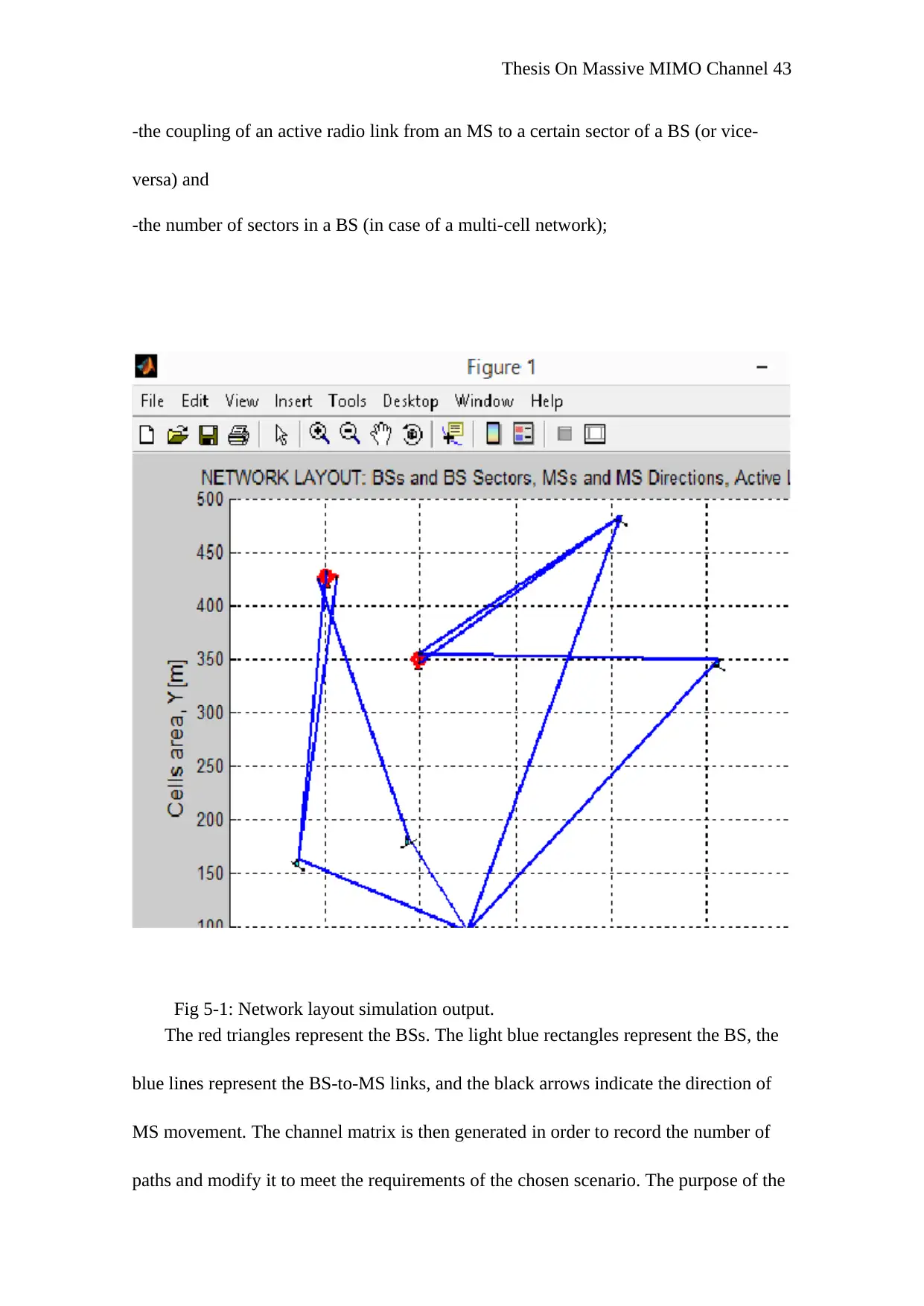
Thesis On Massive MIMO Channel 43
-the coupling of an active radio link from an MS to a certain sector of a BS (or vice-
versa) and
-the number of sectors in a BS (in case of a multi-cell network);
Fig 5-1: Network layout simulation output.
The red triangles represent the BSs. The light blue rectangles represent the BS, the
blue lines represent the BS-to-MS links, and the black arrows indicate the direction of
MS movement. The channel matrix is then generated in order to record the number of
paths and modify it to meet the requirements of the chosen scenario. The purpose of the
-the coupling of an active radio link from an MS to a certain sector of a BS (or vice-
versa) and
-the number of sectors in a BS (in case of a multi-cell network);
Fig 5-1: Network layout simulation output.
The red triangles represent the BSs. The light blue rectangles represent the BS, the
blue lines represent the BS-to-MS links, and the black arrows indicate the direction of
MS movement. The channel matrix is then generated in order to record the number of
paths and modify it to meet the requirements of the chosen scenario. The purpose of the
Paraphrase This Document
Need a fresh take? Get an instant paraphrase of this document with our AI Paraphraser
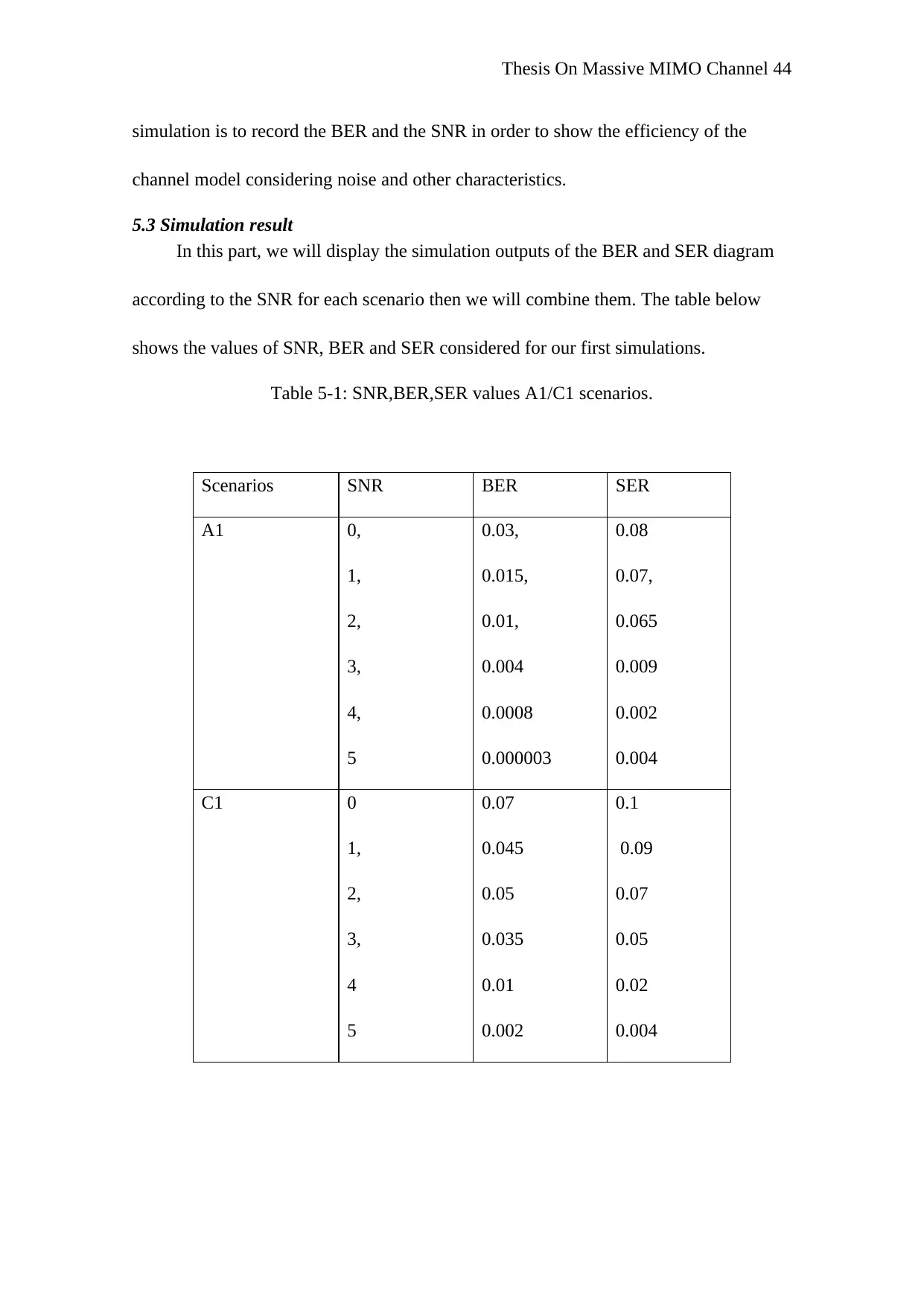
Thesis On Massive MIMO Channel 44
simulation is to record the BER and the SNR in order to show the efficiency of the
channel model considering noise and other characteristics.
5.3 Simulation result
In this part, we will display the simulation outputs of the BER and SER diagram
according to the SNR for each scenario then we will combine them. The table below
shows the values of SNR, BER and SER considered for our first simulations.
Table 5-1: SNR,BER,SER values A1/C1 scenarios.
Scenarios SNR BER SER
A1 0,
1,
2,
3,
4,
5
0.03,
0.015,
0.01,
0.004
0.0008
0.000003
0.08
0.07,
0.065
0.009
0.002
0.004
C1 0
1,
2,
3,
4
5
0.07
0.045
0.05
0.035
0.01
0.002
0.1
0.09
0.07
0.05
0.02
0.004
simulation is to record the BER and the SNR in order to show the efficiency of the
channel model considering noise and other characteristics.
5.3 Simulation result
In this part, we will display the simulation outputs of the BER and SER diagram
according to the SNR for each scenario then we will combine them. The table below
shows the values of SNR, BER and SER considered for our first simulations.
Table 5-1: SNR,BER,SER values A1/C1 scenarios.
Scenarios SNR BER SER
A1 0,
1,
2,
3,
4,
5
0.03,
0.015,
0.01,
0.004
0.0008
0.000003
0.08
0.07,
0.065
0.009
0.002
0.004
C1 0
1,
2,
3,
4
5
0.07
0.045
0.05
0.035
0.01
0.002
0.1
0.09
0.07
0.05
0.02
0.004
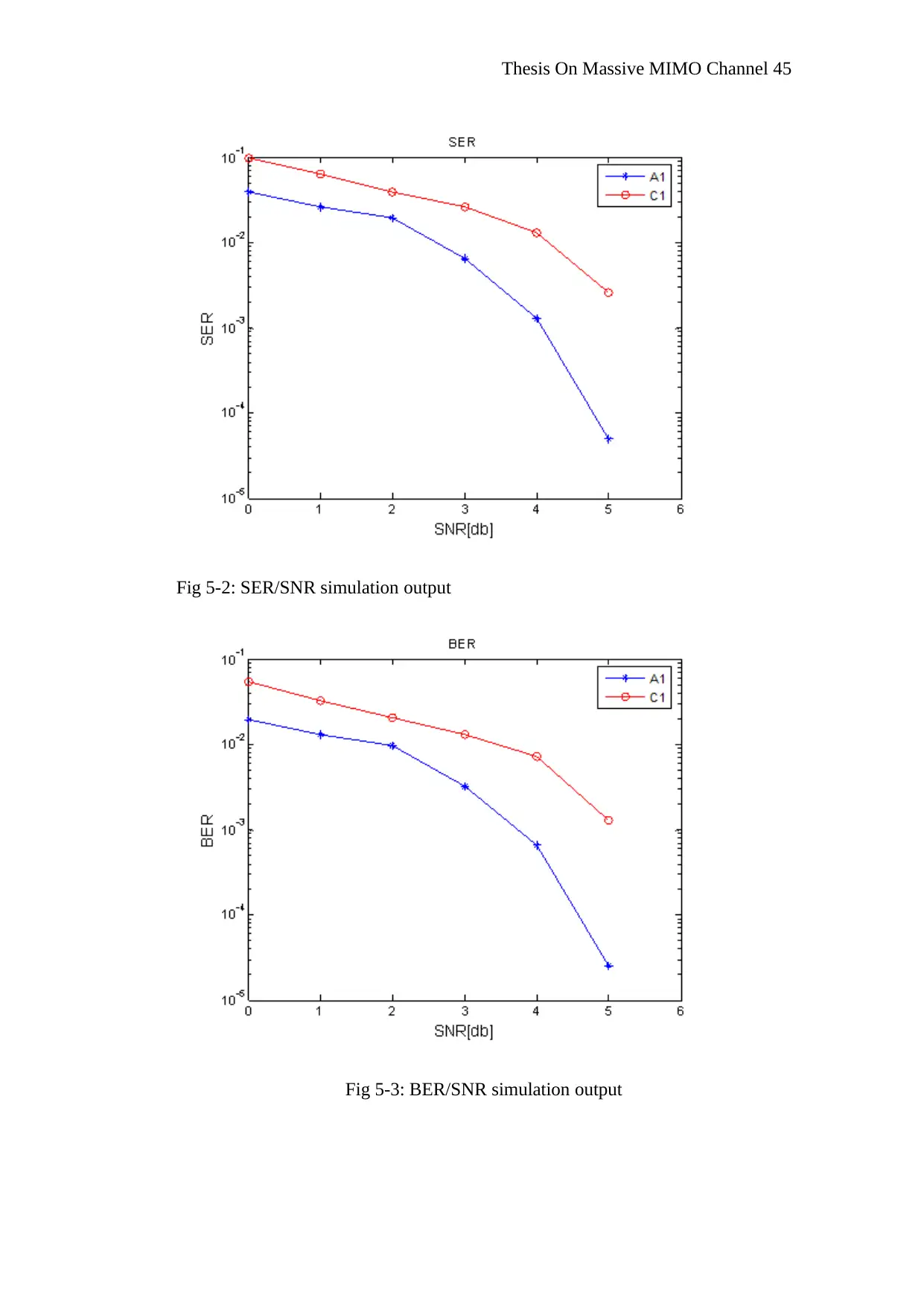
Thesis On Massive MIMO Channel 45
Fig 5-2: SER/SNR simulation output
Fig 5-3: BER/SNR simulation output
Fig 5-2: SER/SNR simulation output
Fig 5-3: BER/SNR simulation output
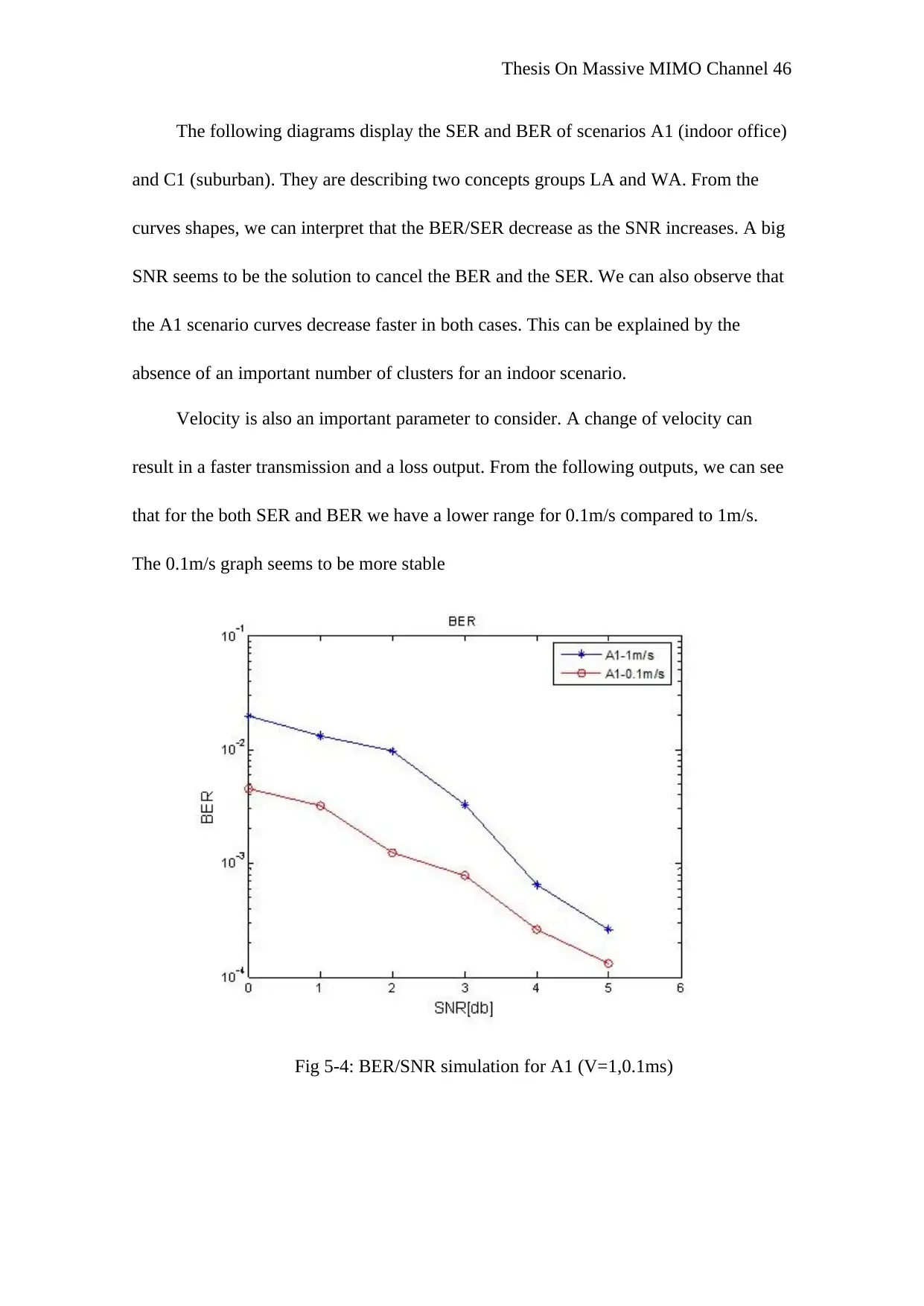
Thesis On Massive MIMO Channel 46
The following diagrams display the SER and BER of scenarios A1 (indoor office)
and C1 (suburban). They are describing two concepts groups LA and WA. From the
curves shapes, we can interpret that the BER/SER decrease as the SNR increases. A big
SNR seems to be the solution to cancel the BER and the SER. We can also observe that
the A1 scenario curves decrease faster in both cases. This can be explained by the
absence of an important number of clusters for an indoor scenario.
Velocity is also an important parameter to consider. A change of velocity can
result in a faster transmission and a loss output. From the following outputs, we can see
that for the both SER and BER we have a lower range for 0.1m/s compared to 1m/s.
The 0.1m/s graph seems to be more stable
Fig 5-4: BER/SNR simulation for A1 (V=1,0.1ms)
The following diagrams display the SER and BER of scenarios A1 (indoor office)
and C1 (suburban). They are describing two concepts groups LA and WA. From the
curves shapes, we can interpret that the BER/SER decrease as the SNR increases. A big
SNR seems to be the solution to cancel the BER and the SER. We can also observe that
the A1 scenario curves decrease faster in both cases. This can be explained by the
absence of an important number of clusters for an indoor scenario.
Velocity is also an important parameter to consider. A change of velocity can
result in a faster transmission and a loss output. From the following outputs, we can see
that for the both SER and BER we have a lower range for 0.1m/s compared to 1m/s.
The 0.1m/s graph seems to be more stable
Fig 5-4: BER/SNR simulation for A1 (V=1,0.1ms)
Secure Best Marks with AI Grader
Need help grading? Try our AI Grader for instant feedback on your assignments.
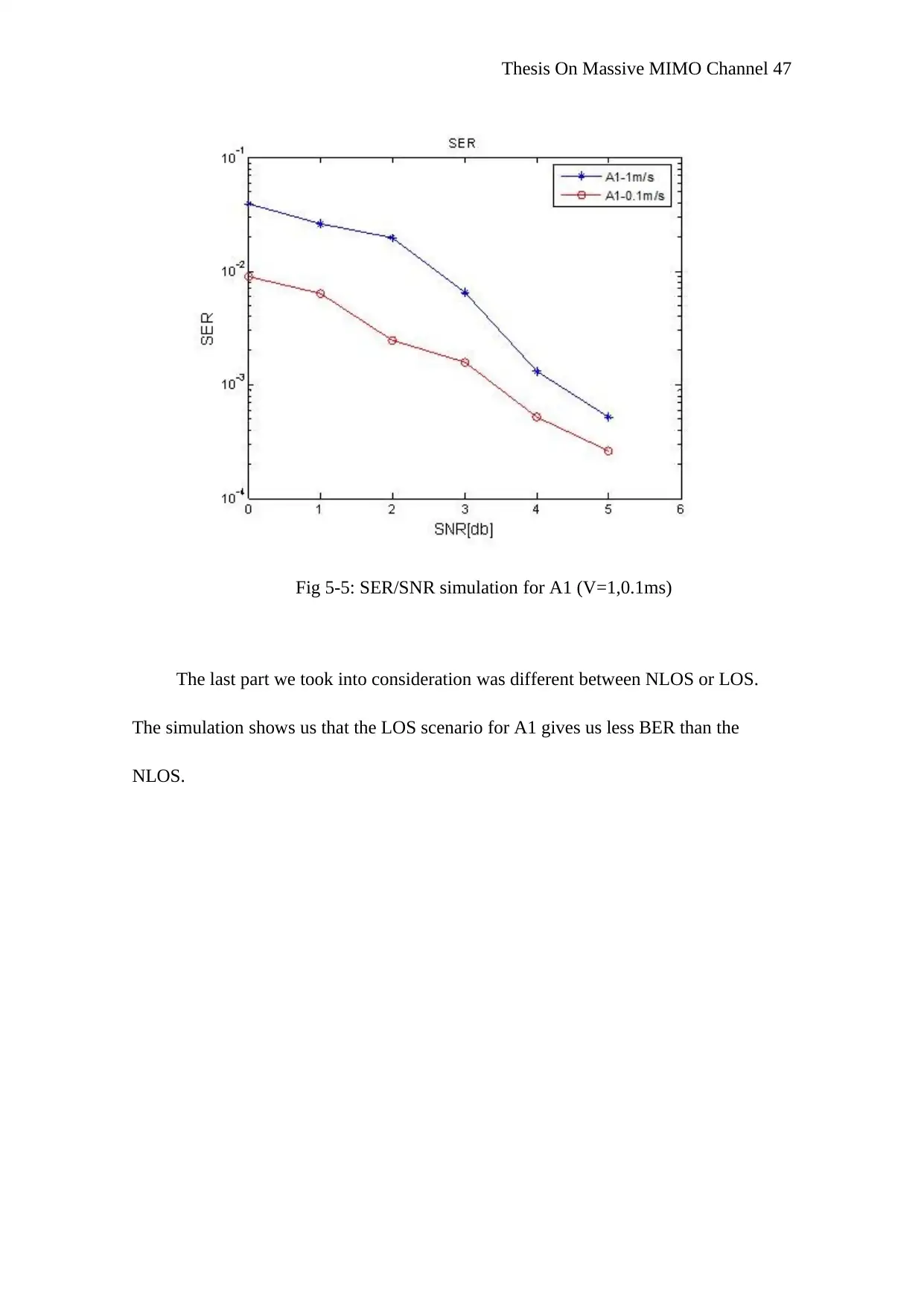
Thesis On Massive MIMO Channel 47
Fig 5-5: SER/SNR simulation for A1 (V=1,0.1ms)
The last part we took into consideration was different between NLOS or LOS.
The simulation shows us that the LOS scenario for A1 gives us less BER than the
NLOS.
Fig 5-5: SER/SNR simulation for A1 (V=1,0.1ms)
The last part we took into consideration was different between NLOS or LOS.
The simulation shows us that the LOS scenario for A1 gives us less BER than the
NLOS.
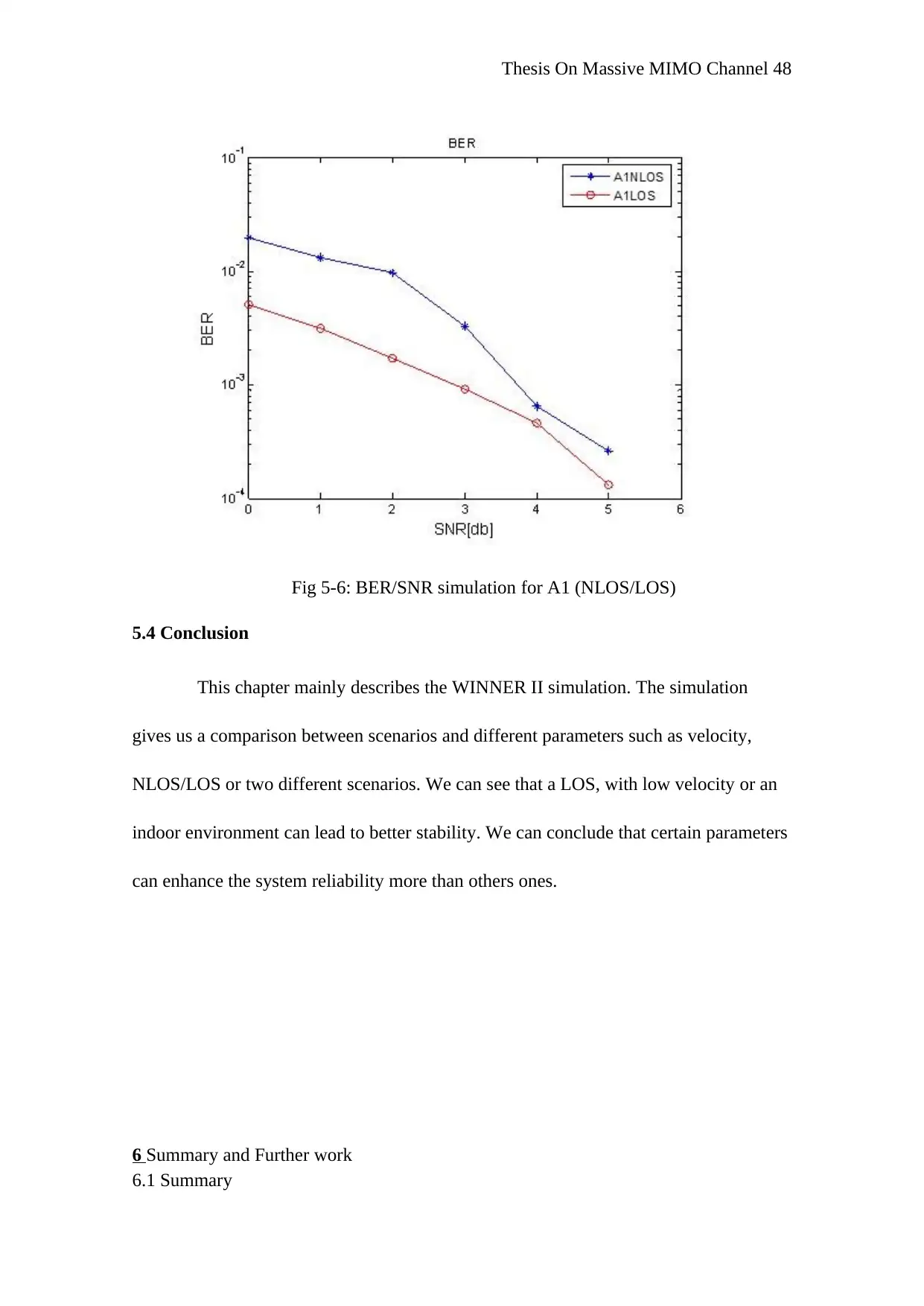
Thesis On Massive MIMO Channel 48
Fig 5-6: BER/SNR simulation for A1 (NLOS/LOS)
5.4 Conclusion
This chapter mainly describes the WINNER II simulation. The simulation
gives us a comparison between scenarios and different parameters such as velocity,
NLOS/LOS or two different scenarios. We can see that a LOS, with low velocity or an
indoor environment can lead to better stability. We can conclude that certain parameters
can enhance the system reliability more than others ones.
6 Summary and Further work
6.1 Summary
Fig 5-6: BER/SNR simulation for A1 (NLOS/LOS)
5.4 Conclusion
This chapter mainly describes the WINNER II simulation. The simulation
gives us a comparison between scenarios and different parameters such as velocity,
NLOS/LOS or two different scenarios. We can see that a LOS, with low velocity or an
indoor environment can lead to better stability. We can conclude that certain parameters
can enhance the system reliability more than others ones.
6 Summary and Further work
6.1 Summary
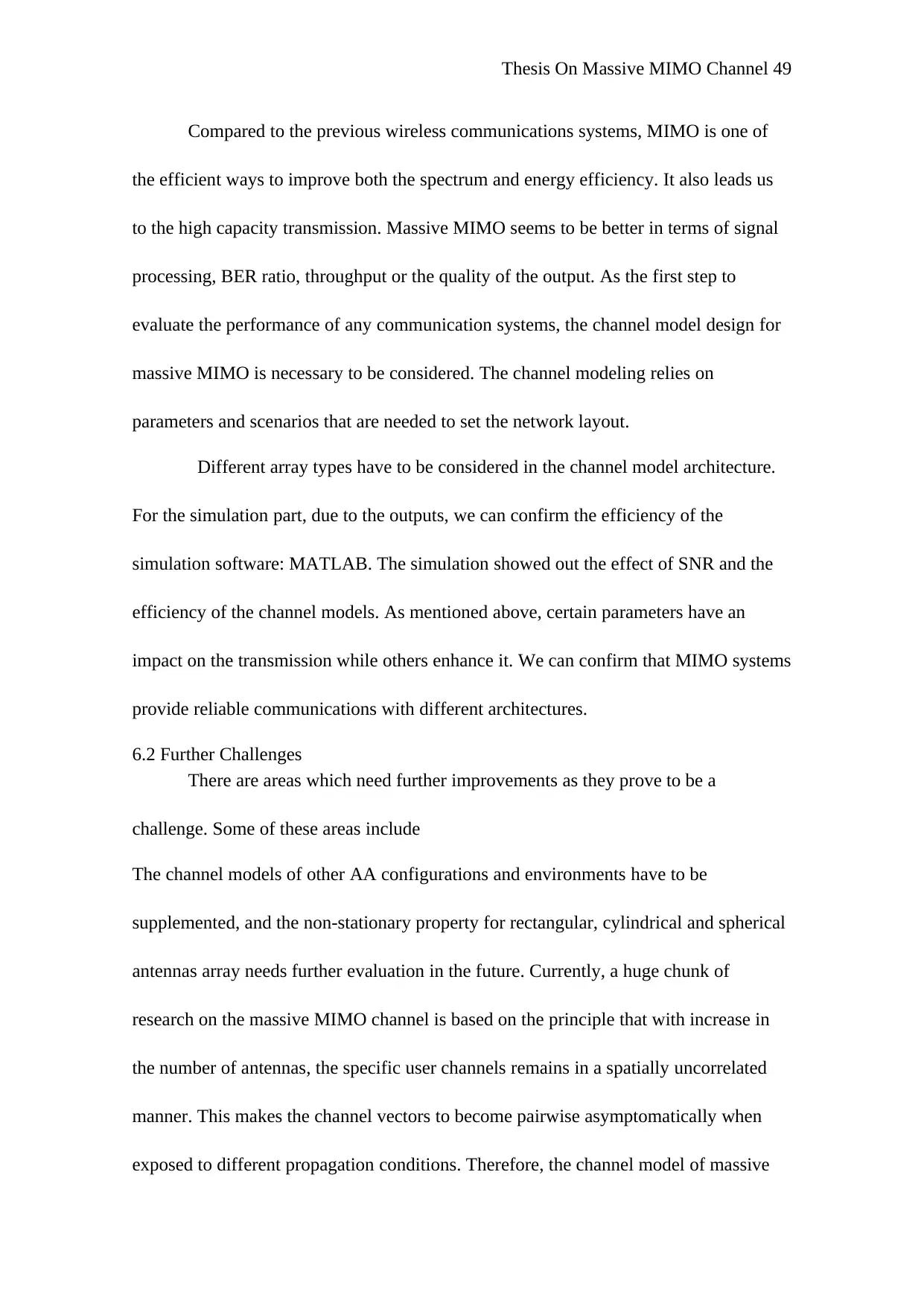
Thesis On Massive MIMO Channel 49
Compared to the previous wireless communications systems, MIMO is one of
the efficient ways to improve both the spectrum and energy efficiency. It also leads us
to the high capacity transmission. Massive MIMO seems to be better in terms of signal
processing, BER ratio, throughput or the quality of the output. As the first step to
evaluate the performance of any communication systems, the channel model design for
massive MIMO is necessary to be considered. The channel modeling relies on
parameters and scenarios that are needed to set the network layout.
Different array types have to be considered in the channel model architecture.
For the simulation part, due to the outputs, we can confirm the efficiency of the
simulation software: MATLAB. The simulation showed out the effect of SNR and the
efficiency of the channel models. As mentioned above, certain parameters have an
impact on the transmission while others enhance it. We can confirm that MIMO systems
provide reliable communications with different architectures.
6.2 Further Challenges
There are areas which need further improvements as they prove to be a
challenge. Some of these areas include
The channel models of other AA configurations and environments have to be
supplemented, and the non-stationary property for rectangular, cylindrical and spherical
antennas array needs further evaluation in the future. Currently, a huge chunk of
research on the massive MIMO channel is based on the principle that with increase in
the number of antennas, the specific user channels remains in a spatially uncorrelated
manner. This makes the channel vectors to become pairwise asymptomatically when
exposed to different propagation conditions. Therefore, the channel model of massive
Compared to the previous wireless communications systems, MIMO is one of
the efficient ways to improve both the spectrum and energy efficiency. It also leads us
to the high capacity transmission. Massive MIMO seems to be better in terms of signal
processing, BER ratio, throughput or the quality of the output. As the first step to
evaluate the performance of any communication systems, the channel model design for
massive MIMO is necessary to be considered. The channel modeling relies on
parameters and scenarios that are needed to set the network layout.
Different array types have to be considered in the channel model architecture.
For the simulation part, due to the outputs, we can confirm the efficiency of the
simulation software: MATLAB. The simulation showed out the effect of SNR and the
efficiency of the channel models. As mentioned above, certain parameters have an
impact on the transmission while others enhance it. We can confirm that MIMO systems
provide reliable communications with different architectures.
6.2 Further Challenges
There are areas which need further improvements as they prove to be a
challenge. Some of these areas include
The channel models of other AA configurations and environments have to be
supplemented, and the non-stationary property for rectangular, cylindrical and spherical
antennas array needs further evaluation in the future. Currently, a huge chunk of
research on the massive MIMO channel is based on the principle that with increase in
the number of antennas, the specific user channels remains in a spatially uncorrelated
manner. This makes the channel vectors to become pairwise asymptomatically when
exposed to different propagation conditions. Therefore, the channel model of massive
Paraphrase This Document
Need a fresh take? Get an instant paraphrase of this document with our AI Paraphraser
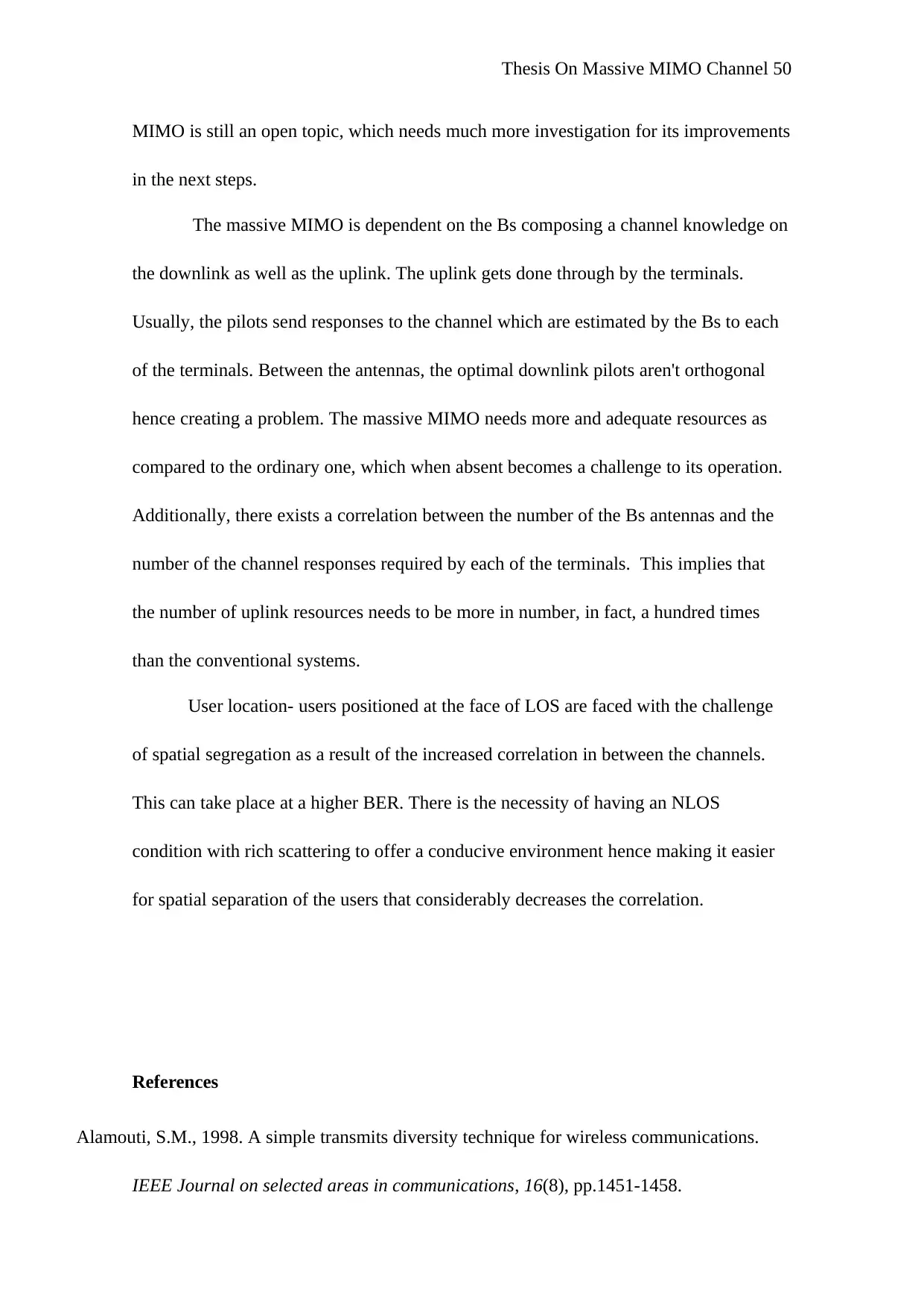
Thesis On Massive MIMO Channel 50
MIMO is still an open topic, which needs much more investigation for its improvements
in the next steps.
The massive MIMO is dependent on the Bs composing a channel knowledge on
the downlink as well as the uplink. The uplink gets done through by the terminals.
Usually, the pilots send responses to the channel which are estimated by the Bs to each
of the terminals. Between the antennas, the optimal downlink pilots aren't orthogonal
hence creating a problem. The massive MIMO needs more and adequate resources as
compared to the ordinary one, which when absent becomes a challenge to its operation.
Additionally, there exists a correlation between the number of the Bs antennas and the
number of the channel responses required by each of the terminals. This implies that
the number of uplink resources needs to be more in number, in fact, a hundred times
than the conventional systems.
User location- users positioned at the face of LOS are faced with the challenge
of spatial segregation as a result of the increased correlation in between the channels.
This can take place at a higher BER. There is the necessity of having an NLOS
condition with rich scattering to offer a conducive environment hence making it easier
for spatial separation of the users that considerably decreases the correlation.
References
Alamouti, S.M., 1998. A simple transmits diversity technique for wireless communications.
IEEE Journal on selected areas in communications, 16(8), pp.1451-1458.
MIMO is still an open topic, which needs much more investigation for its improvements
in the next steps.
The massive MIMO is dependent on the Bs composing a channel knowledge on
the downlink as well as the uplink. The uplink gets done through by the terminals.
Usually, the pilots send responses to the channel which are estimated by the Bs to each
of the terminals. Between the antennas, the optimal downlink pilots aren't orthogonal
hence creating a problem. The massive MIMO needs more and adequate resources as
compared to the ordinary one, which when absent becomes a challenge to its operation.
Additionally, there exists a correlation between the number of the Bs antennas and the
number of the channel responses required by each of the terminals. This implies that
the number of uplink resources needs to be more in number, in fact, a hundred times
than the conventional systems.
User location- users positioned at the face of LOS are faced with the challenge
of spatial segregation as a result of the increased correlation in between the channels.
This can take place at a higher BER. There is the necessity of having an NLOS
condition with rich scattering to offer a conducive environment hence making it easier
for spatial separation of the users that considerably decreases the correlation.
References
Alamouti, S.M., 1998. A simple transmits diversity technique for wireless communications.
IEEE Journal on selected areas in communications, 16(8), pp.1451-1458.
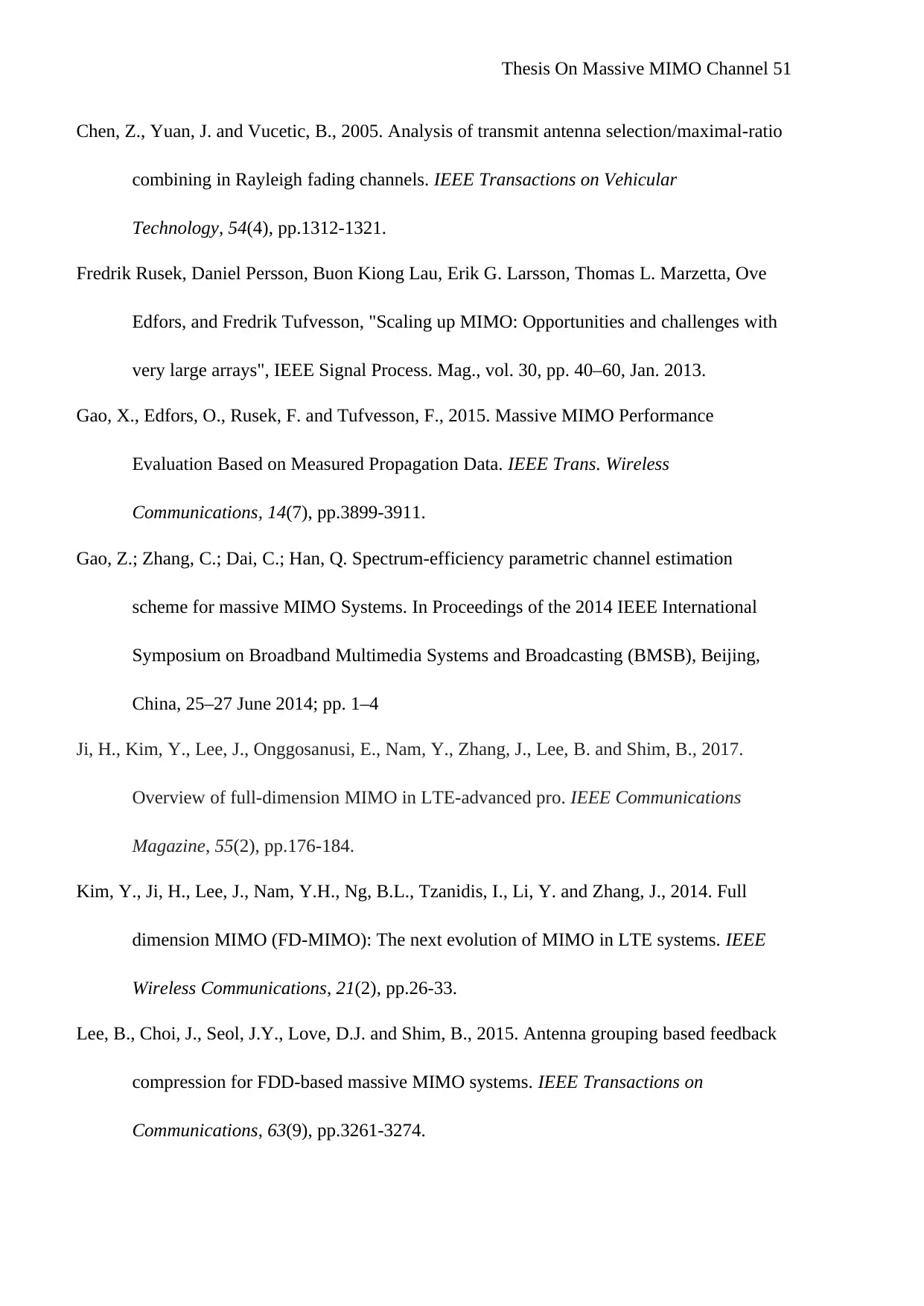
Thesis On Massive MIMO Channel 51
Chen, Z., Yuan, J. and Vucetic, B., 2005. Analysis of transmit antenna selection/maximal-ratio
combining in Rayleigh fading channels. IEEE Transactions on Vehicular
Technology, 54(4), pp.1312-1321.
Fredrik Rusek, Daniel Persson, Buon Kiong Lau, Erik G. Larsson, Thomas L. Marzetta, Ove
Edfors, and Fredrik Tufvesson, "Scaling up MIMO: Opportunities and challenges with
very large arrays", IEEE Signal Process. Mag., vol. 30, pp. 40–60, Jan. 2013.
Gao, X., Edfors, O., Rusek, F. and Tufvesson, F., 2015. Massive MIMO Performance
Evaluation Based on Measured Propagation Data. IEEE Trans. Wireless
Communications, 14(7), pp.3899-3911.
Gao, Z.; Zhang, C.; Dai, C.; Han, Q. Spectrum-efficiency parametric channel estimation
scheme for massive MIMO Systems. In Proceedings of the 2014 IEEE International
Symposium on Broadband Multimedia Systems and Broadcasting (BMSB), Beijing,
China, 25–27 June 2014; pp. 1–4
Ji, H., Kim, Y., Lee, J., Onggosanusi, E., Nam, Y., Zhang, J., Lee, B. and Shim, B., 2017.
Overview of full-dimension MIMO in LTE-advanced pro. IEEE Communications
Magazine, 55(2), pp.176-184.
Kim, Y., Ji, H., Lee, J., Nam, Y.H., Ng, B.L., Tzanidis, I., Li, Y. and Zhang, J., 2014. Full
dimension MIMO (FD-MIMO): The next evolution of MIMO in LTE systems. IEEE
Wireless Communications, 21(2), pp.26-33.
Lee, B., Choi, J., Seol, J.Y., Love, D.J. and Shim, B., 2015. Antenna grouping based feedback
compression for FDD-based massive MIMO systems. IEEE Transactions on
Communications, 63(9), pp.3261-3274.
Chen, Z., Yuan, J. and Vucetic, B., 2005. Analysis of transmit antenna selection/maximal-ratio
combining in Rayleigh fading channels. IEEE Transactions on Vehicular
Technology, 54(4), pp.1312-1321.
Fredrik Rusek, Daniel Persson, Buon Kiong Lau, Erik G. Larsson, Thomas L. Marzetta, Ove
Edfors, and Fredrik Tufvesson, "Scaling up MIMO: Opportunities and challenges with
very large arrays", IEEE Signal Process. Mag., vol. 30, pp. 40–60, Jan. 2013.
Gao, X., Edfors, O., Rusek, F. and Tufvesson, F., 2015. Massive MIMO Performance
Evaluation Based on Measured Propagation Data. IEEE Trans. Wireless
Communications, 14(7), pp.3899-3911.
Gao, Z.; Zhang, C.; Dai, C.; Han, Q. Spectrum-efficiency parametric channel estimation
scheme for massive MIMO Systems. In Proceedings of the 2014 IEEE International
Symposium on Broadband Multimedia Systems and Broadcasting (BMSB), Beijing,
China, 25–27 June 2014; pp. 1–4
Ji, H., Kim, Y., Lee, J., Onggosanusi, E., Nam, Y., Zhang, J., Lee, B. and Shim, B., 2017.
Overview of full-dimension MIMO in LTE-advanced pro. IEEE Communications
Magazine, 55(2), pp.176-184.
Kim, Y., Ji, H., Lee, J., Nam, Y.H., Ng, B.L., Tzanidis, I., Li, Y. and Zhang, J., 2014. Full
dimension MIMO (FD-MIMO): The next evolution of MIMO in LTE systems. IEEE
Wireless Communications, 21(2), pp.26-33.
Lee, B., Choi, J., Seol, J.Y., Love, D.J. and Shim, B., 2015. Antenna grouping based feedback
compression for FDD-based massive MIMO systems. IEEE Transactions on
Communications, 63(9), pp.3261-3274.
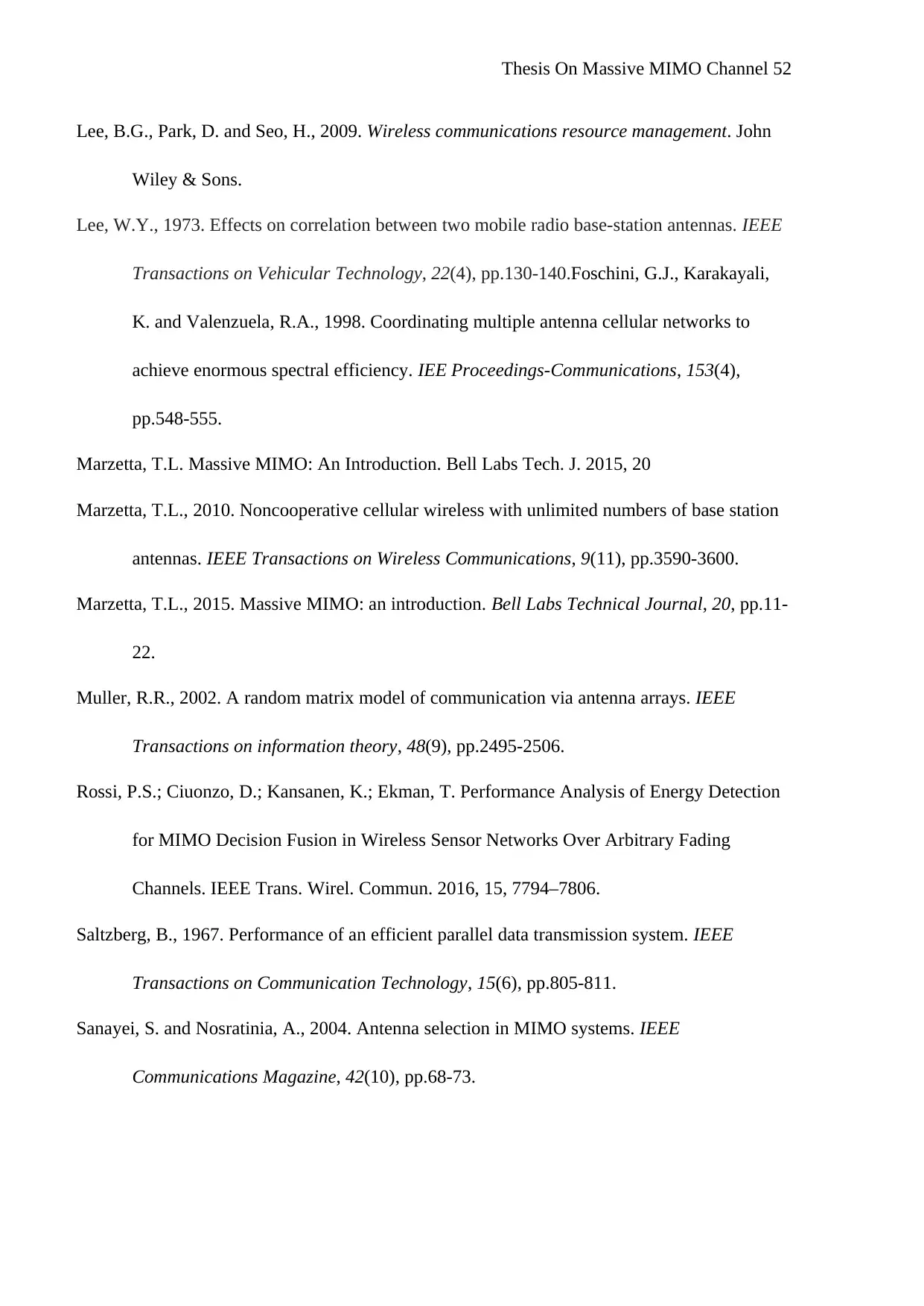
Thesis On Massive MIMO Channel 52
Lee, B.G., Park, D. and Seo, H., 2009. Wireless communications resource management. John
Wiley & Sons.
Lee, W.Y., 1973. Effects on correlation between two mobile radio base-station antennas. IEEE
Transactions on Vehicular Technology, 22(4), pp.130-140.Foschini, G.J., Karakayali,
K. and Valenzuela, R.A., 1998. Coordinating multiple antenna cellular networks to
achieve enormous spectral efficiency. IEE Proceedings-Communications, 153(4),
pp.548-555.
Marzetta, T.L. Massive MIMO: An Introduction. Bell Labs Tech. J. 2015, 20
Marzetta, T.L., 2010. Noncooperative cellular wireless with unlimited numbers of base station
antennas. IEEE Transactions on Wireless Communications, 9(11), pp.3590-3600.
Marzetta, T.L., 2015. Massive MIMO: an introduction. Bell Labs Technical Journal, 20, pp.11-
22.
Muller, R.R., 2002. A random matrix model of communication via antenna arrays. IEEE
Transactions on information theory, 48(9), pp.2495-2506.
Rossi, P.S.; Ciuonzo, D.; Kansanen, K.; Ekman, T. Performance Analysis of Energy Detection
for MIMO Decision Fusion in Wireless Sensor Networks Over Arbitrary Fading
Channels. IEEE Trans. Wirel. Commun. 2016, 15, 7794–7806.
Saltzberg, B., 1967. Performance of an efficient parallel data transmission system. IEEE
Transactions on Communication Technology, 15(6), pp.805-811.
Sanayei, S. and Nosratinia, A., 2004. Antenna selection in MIMO systems. IEEE
Communications Magazine, 42(10), pp.68-73.
Lee, B.G., Park, D. and Seo, H., 2009. Wireless communications resource management. John
Wiley & Sons.
Lee, W.Y., 1973. Effects on correlation between two mobile radio base-station antennas. IEEE
Transactions on Vehicular Technology, 22(4), pp.130-140.Foschini, G.J., Karakayali,
K. and Valenzuela, R.A., 1998. Coordinating multiple antenna cellular networks to
achieve enormous spectral efficiency. IEE Proceedings-Communications, 153(4),
pp.548-555.
Marzetta, T.L. Massive MIMO: An Introduction. Bell Labs Tech. J. 2015, 20
Marzetta, T.L., 2010. Noncooperative cellular wireless with unlimited numbers of base station
antennas. IEEE Transactions on Wireless Communications, 9(11), pp.3590-3600.
Marzetta, T.L., 2015. Massive MIMO: an introduction. Bell Labs Technical Journal, 20, pp.11-
22.
Muller, R.R., 2002. A random matrix model of communication via antenna arrays. IEEE
Transactions on information theory, 48(9), pp.2495-2506.
Rossi, P.S.; Ciuonzo, D.; Kansanen, K.; Ekman, T. Performance Analysis of Energy Detection
for MIMO Decision Fusion in Wireless Sensor Networks Over Arbitrary Fading
Channels. IEEE Trans. Wirel. Commun. 2016, 15, 7794–7806.
Saltzberg, B., 1967. Performance of an efficient parallel data transmission system. IEEE
Transactions on Communication Technology, 15(6), pp.805-811.
Sanayei, S. and Nosratinia, A., 2004. Antenna selection in MIMO systems. IEEE
Communications Magazine, 42(10), pp.68-73.
Secure Best Marks with AI Grader
Need help grading? Try our AI Grader for instant feedback on your assignments.
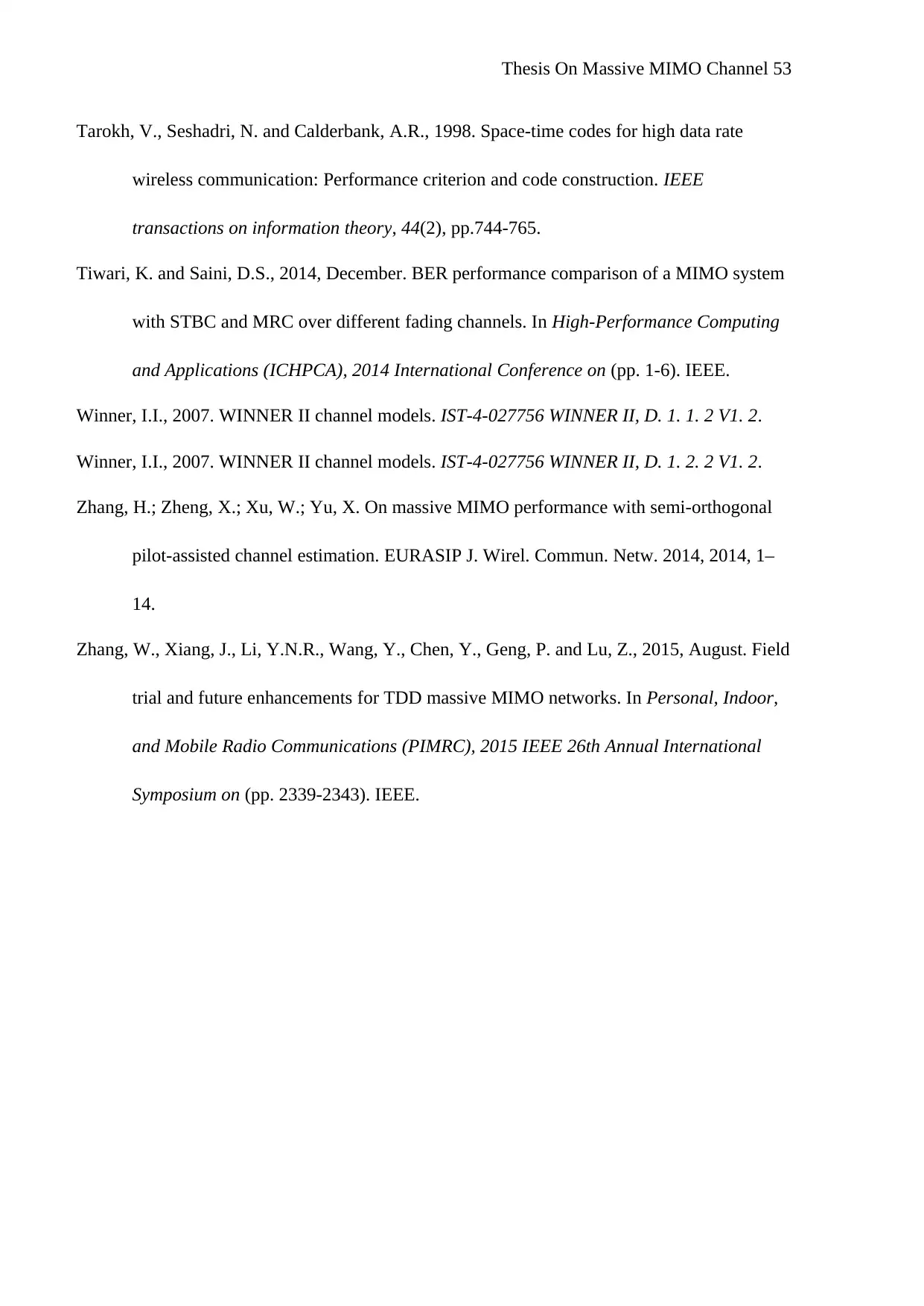
Thesis On Massive MIMO Channel 53
Tarokh, V., Seshadri, N. and Calderbank, A.R., 1998. Space-time codes for high data rate
wireless communication: Performance criterion and code construction. IEEE
transactions on information theory, 44(2), pp.744-765.
Tiwari, K. and Saini, D.S., 2014, December. BER performance comparison of a MIMO system
with STBC and MRC over different fading channels. In High-Performance Computing
and Applications (ICHPCA), 2014 International Conference on (pp. 1-6). IEEE.
Winner, I.I., 2007. WINNER II channel models. IST-4-027756 WINNER II, D. 1. 1. 2 V1. 2.
Winner, I.I., 2007. WINNER II channel models. IST-4-027756 WINNER II, D. 1. 2. 2 V1. 2.
Zhang, H.; Zheng, X.; Xu, W.; Yu, X. On massive MIMO performance with semi-orthogonal
pilot-assisted channel estimation. EURASIP J. Wirel. Commun. Netw. 2014, 2014, 1–
14.
Zhang, W., Xiang, J., Li, Y.N.R., Wang, Y., Chen, Y., Geng, P. and Lu, Z., 2015, August. Field
trial and future enhancements for TDD massive MIMO networks. In Personal, Indoor,
and Mobile Radio Communications (PIMRC), 2015 IEEE 26th Annual International
Symposium on (pp. 2339-2343). IEEE.
Tarokh, V., Seshadri, N. and Calderbank, A.R., 1998. Space-time codes for high data rate
wireless communication: Performance criterion and code construction. IEEE
transactions on information theory, 44(2), pp.744-765.
Tiwari, K. and Saini, D.S., 2014, December. BER performance comparison of a MIMO system
with STBC and MRC over different fading channels. In High-Performance Computing
and Applications (ICHPCA), 2014 International Conference on (pp. 1-6). IEEE.
Winner, I.I., 2007. WINNER II channel models. IST-4-027756 WINNER II, D. 1. 1. 2 V1. 2.
Winner, I.I., 2007. WINNER II channel models. IST-4-027756 WINNER II, D. 1. 2. 2 V1. 2.
Zhang, H.; Zheng, X.; Xu, W.; Yu, X. On massive MIMO performance with semi-orthogonal
pilot-assisted channel estimation. EURASIP J. Wirel. Commun. Netw. 2014, 2014, 1–
14.
Zhang, W., Xiang, J., Li, Y.N.R., Wang, Y., Chen, Y., Geng, P. and Lu, Z., 2015, August. Field
trial and future enhancements for TDD massive MIMO networks. In Personal, Indoor,
and Mobile Radio Communications (PIMRC), 2015 IEEE 26th Annual International
Symposium on (pp. 2339-2343). IEEE.
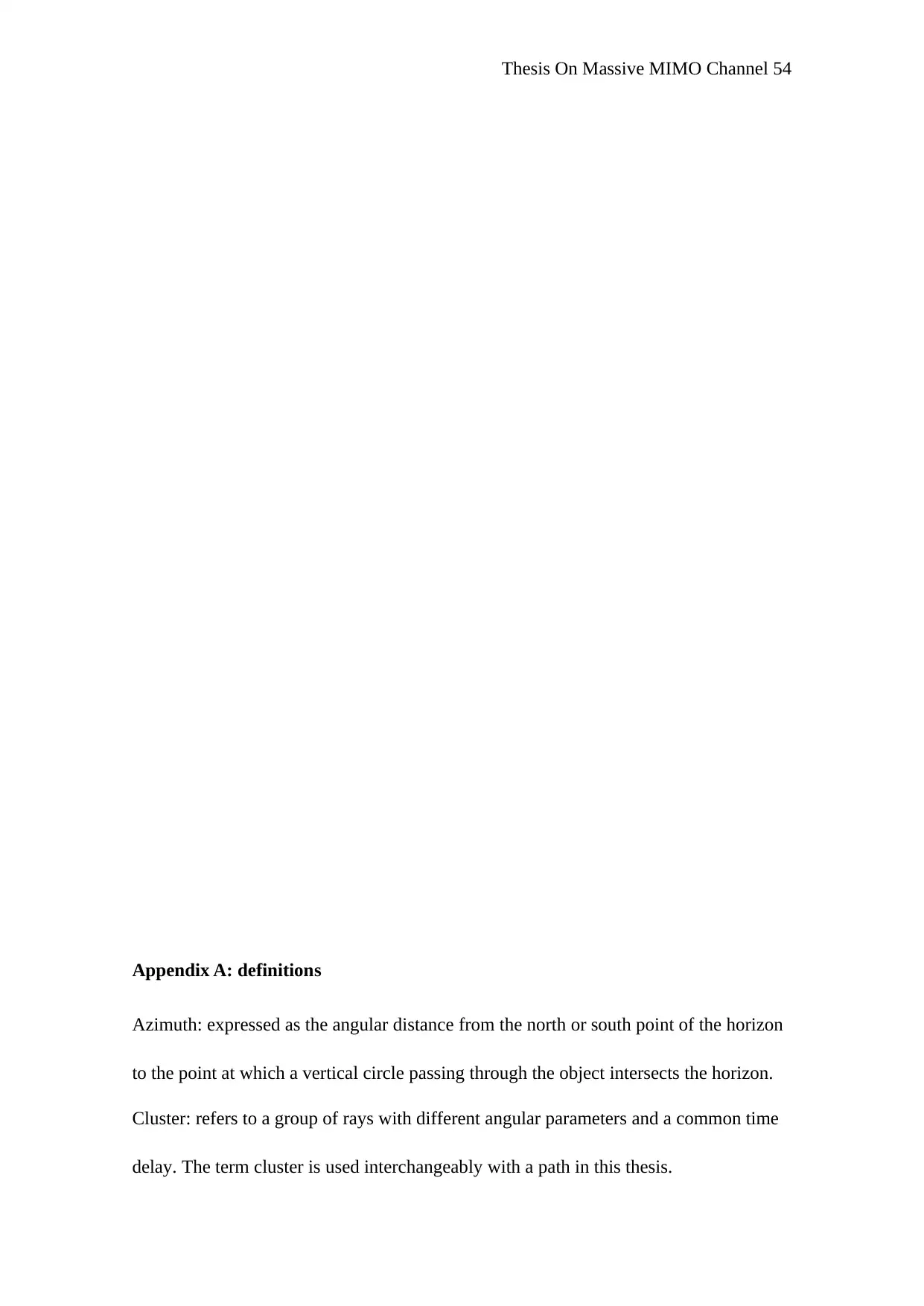
Thesis On Massive MIMO Channel 54
Appendix A: definitions
Azimuth: expressed as the angular distance from the north or south point of the horizon
to the point at which a vertical circle passing through the object intersects the horizon.
Cluster: refers to a group of rays with different angular parameters and a common time
delay. The term cluster is used interchangeably with a path in this thesis.
Appendix A: definitions
Azimuth: expressed as the angular distance from the north or south point of the horizon
to the point at which a vertical circle passing through the object intersects the horizon.
Cluster: refers to a group of rays with different angular parameters and a common time
delay. The term cluster is used interchangeably with a path in this thesis.
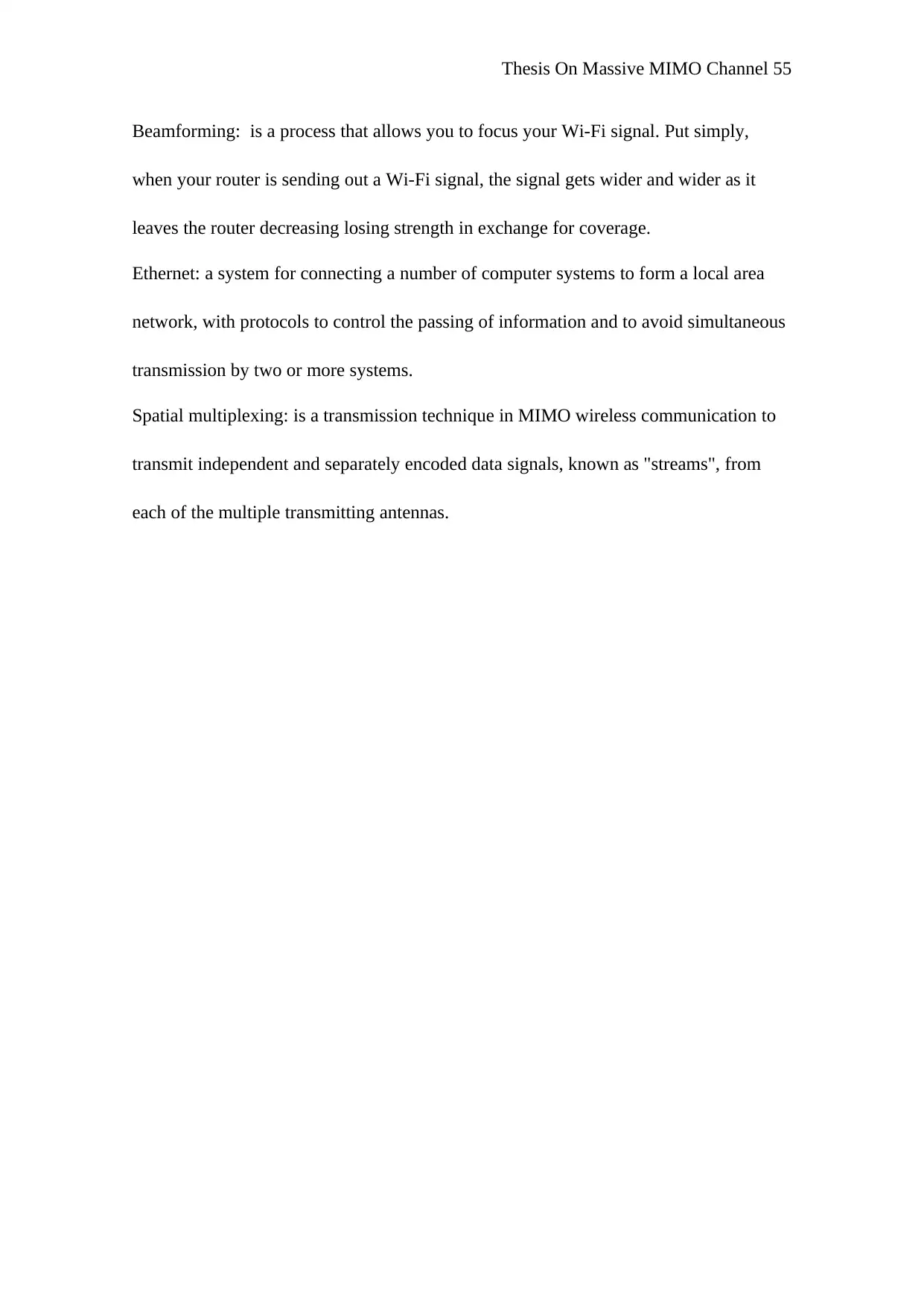
Thesis On Massive MIMO Channel 55
Beamforming: is a process that allows you to focus your Wi-Fi signal. Put simply,
when your router is sending out a Wi-Fi signal, the signal gets wider and wider as it
leaves the router decreasing losing strength in exchange for coverage.
Ethernet: a system for connecting a number of computer systems to form a local area
network, with protocols to control the passing of information and to avoid simultaneous
transmission by two or more systems.
Spatial multiplexing: is a transmission technique in MIMO wireless communication to
transmit independent and separately encoded data signals, known as "streams", from
each of the multiple transmitting antennas.
Beamforming: is a process that allows you to focus your Wi-Fi signal. Put simply,
when your router is sending out a Wi-Fi signal, the signal gets wider and wider as it
leaves the router decreasing losing strength in exchange for coverage.
Ethernet: a system for connecting a number of computer systems to form a local area
network, with protocols to control the passing of information and to avoid simultaneous
transmission by two or more systems.
Spatial multiplexing: is a transmission technique in MIMO wireless communication to
transmit independent and separately encoded data signals, known as "streams", from
each of the multiple transmitting antennas.
Paraphrase This Document
Need a fresh take? Get an instant paraphrase of this document with our AI Paraphraser
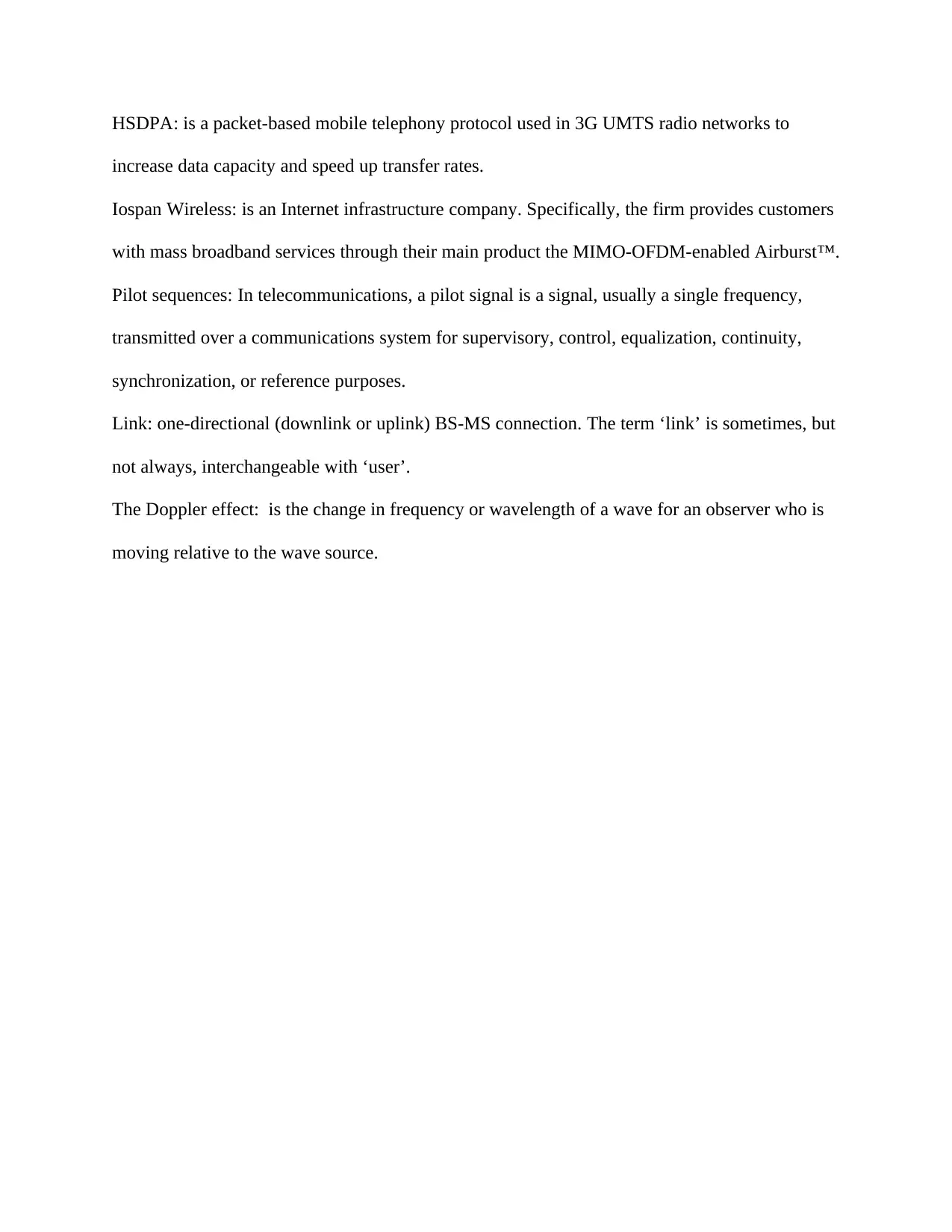
HSDPA: is a packet-based mobile telephony protocol used in 3G UMTS radio networks to
increase data capacity and speed up transfer rates.
Iospan Wireless: is an Internet infrastructure company. Specifically, the firm provides customers
with mass broadband services through their main product the MIMO-OFDM-enabled Airburst™.
Pilot sequences: In telecommunications, a pilot signal is a signal, usually a single frequency,
transmitted over a communications system for supervisory, control, equalization, continuity,
synchronization, or reference purposes.
Link: one-directional (downlink or uplink) BS-MS connection. The term ‘link’ is sometimes, but
not always, interchangeable with ‘user’.
The Doppler effect: is the change in frequency or wavelength of a wave for an observer who is
moving relative to the wave source.
increase data capacity and speed up transfer rates.
Iospan Wireless: is an Internet infrastructure company. Specifically, the firm provides customers
with mass broadband services through their main product the MIMO-OFDM-enabled Airburst™.
Pilot sequences: In telecommunications, a pilot signal is a signal, usually a single frequency,
transmitted over a communications system for supervisory, control, equalization, continuity,
synchronization, or reference purposes.
Link: one-directional (downlink or uplink) BS-MS connection. The term ‘link’ is sometimes, but
not always, interchangeable with ‘user’.
The Doppler effect: is the change in frequency or wavelength of a wave for an observer who is
moving relative to the wave source.
1 out of 56
Related Documents
Your All-in-One AI-Powered Toolkit for Academic Success.
+13062052269
info@desklib.com
Available 24*7 on WhatsApp / Email
![[object Object]](/_next/static/media/star-bottom.7253800d.svg)
Unlock your academic potential
© 2024 | Zucol Services PVT LTD | All rights reserved.




